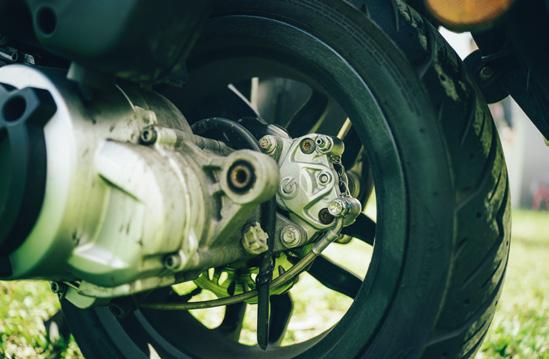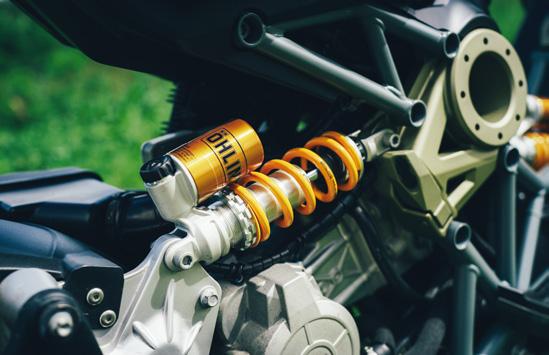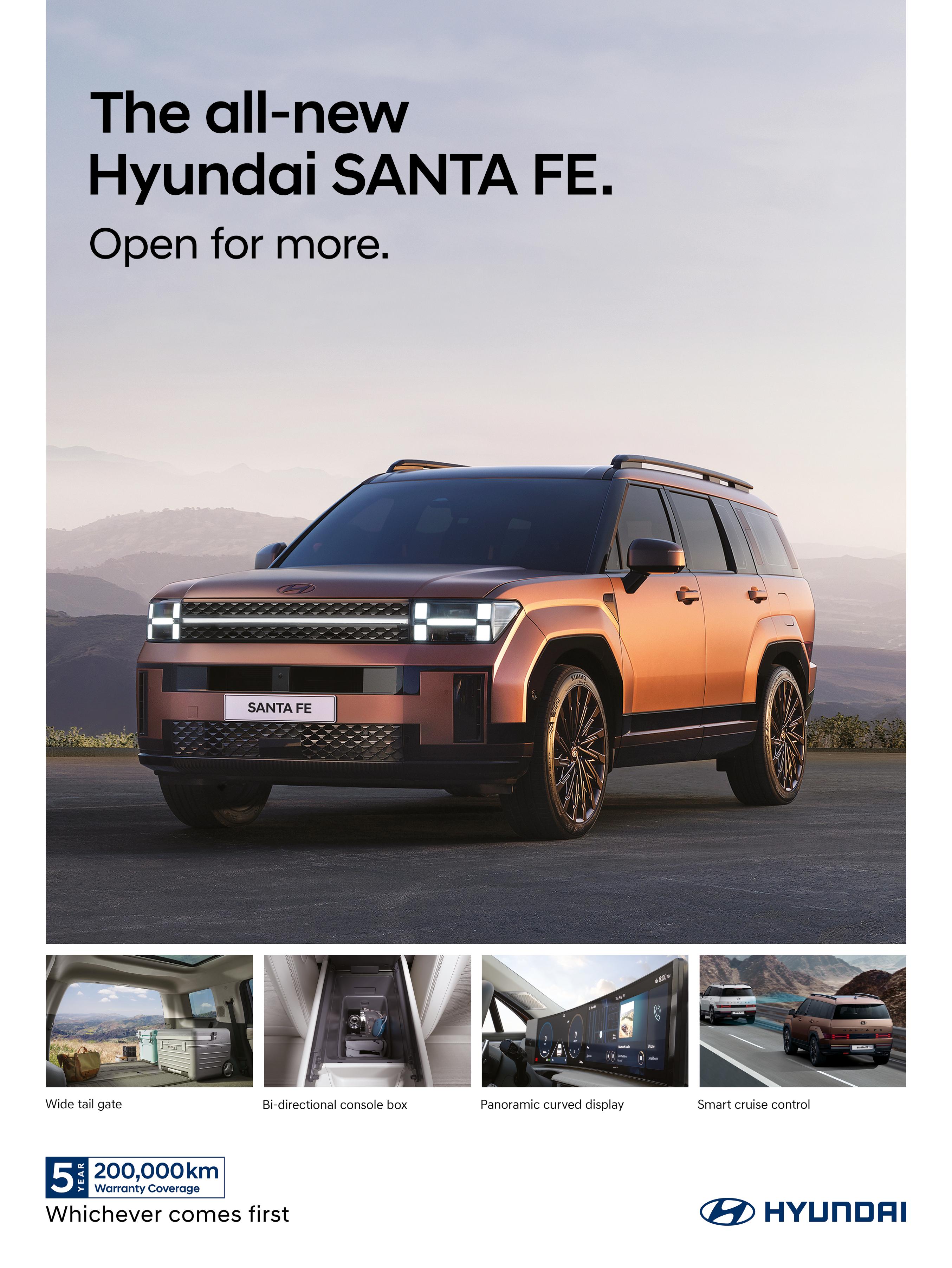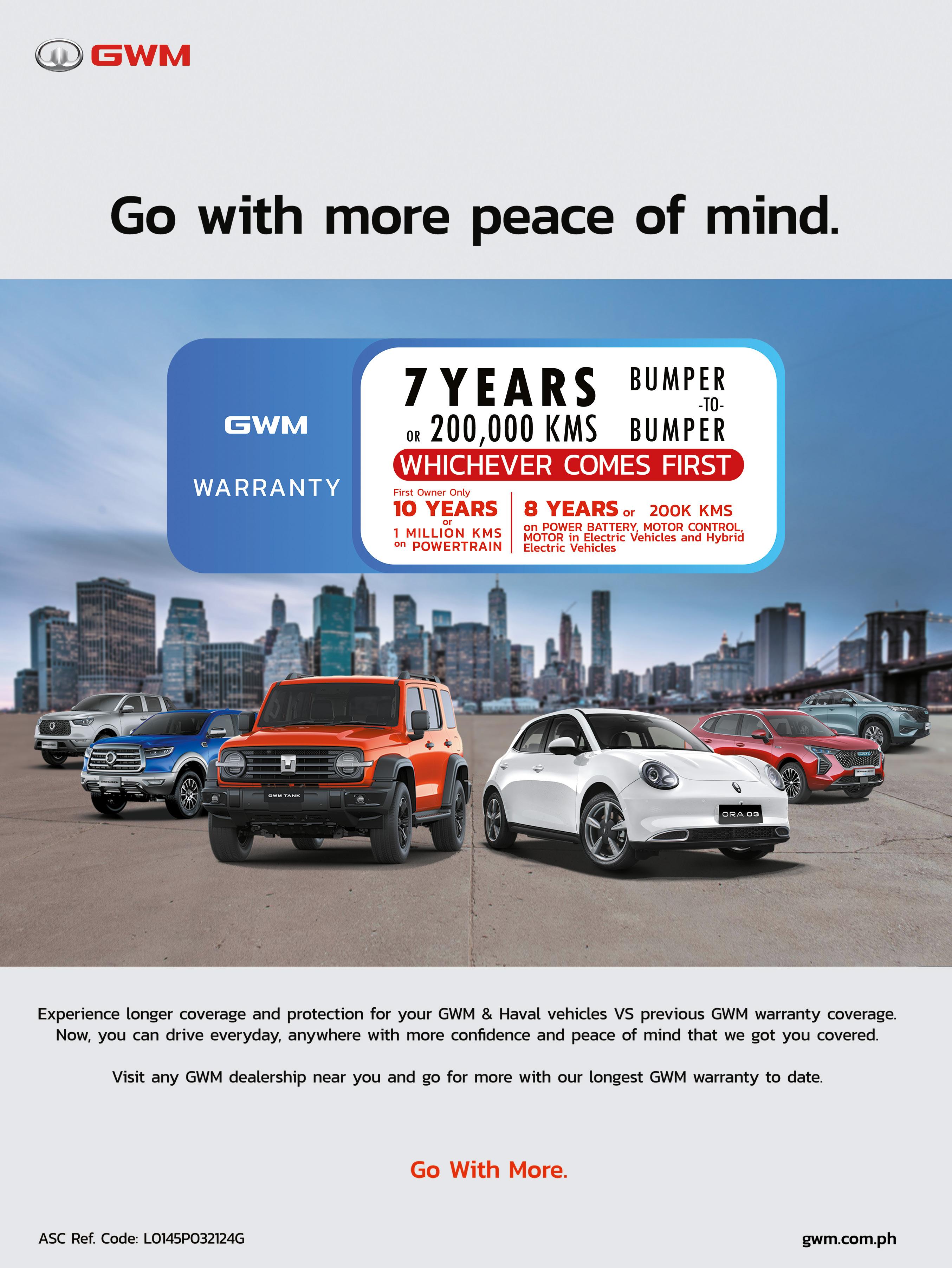A STAR IS BORN JETOUR T2
Stylish,versatile SUV












The authority in the automotive industry to being the authority in the mobility ecosystem.
In the coming months, the C! Publishing Team will formally launch and introduce our new strategic direction. We will take our audience to a bigger universe that we will explore together. Expect new sections, monthly creative themes, exploratory contents and work with different individuals and communities to create stories, in written and video format, that explores the entire Mobility Ecosystem. Expect exciting new features designed to elevate your reading and viewing experience.
We at C! Publishing and Media Group, Inc. are incredibly grateful for your loyalty over the years. As we discover better ways to share our stories, experiences onground, and explore new themes and ideas on this adventure, we invite you to join us and help build a bigger, more sustainable C! Mobility Ecosystem and Communities.
CK Buenviaje CHIEF OPERATING OFFICER
"In a world of constant change, the greatest danger is not to risk taking."
JOHN F. KENNEDY
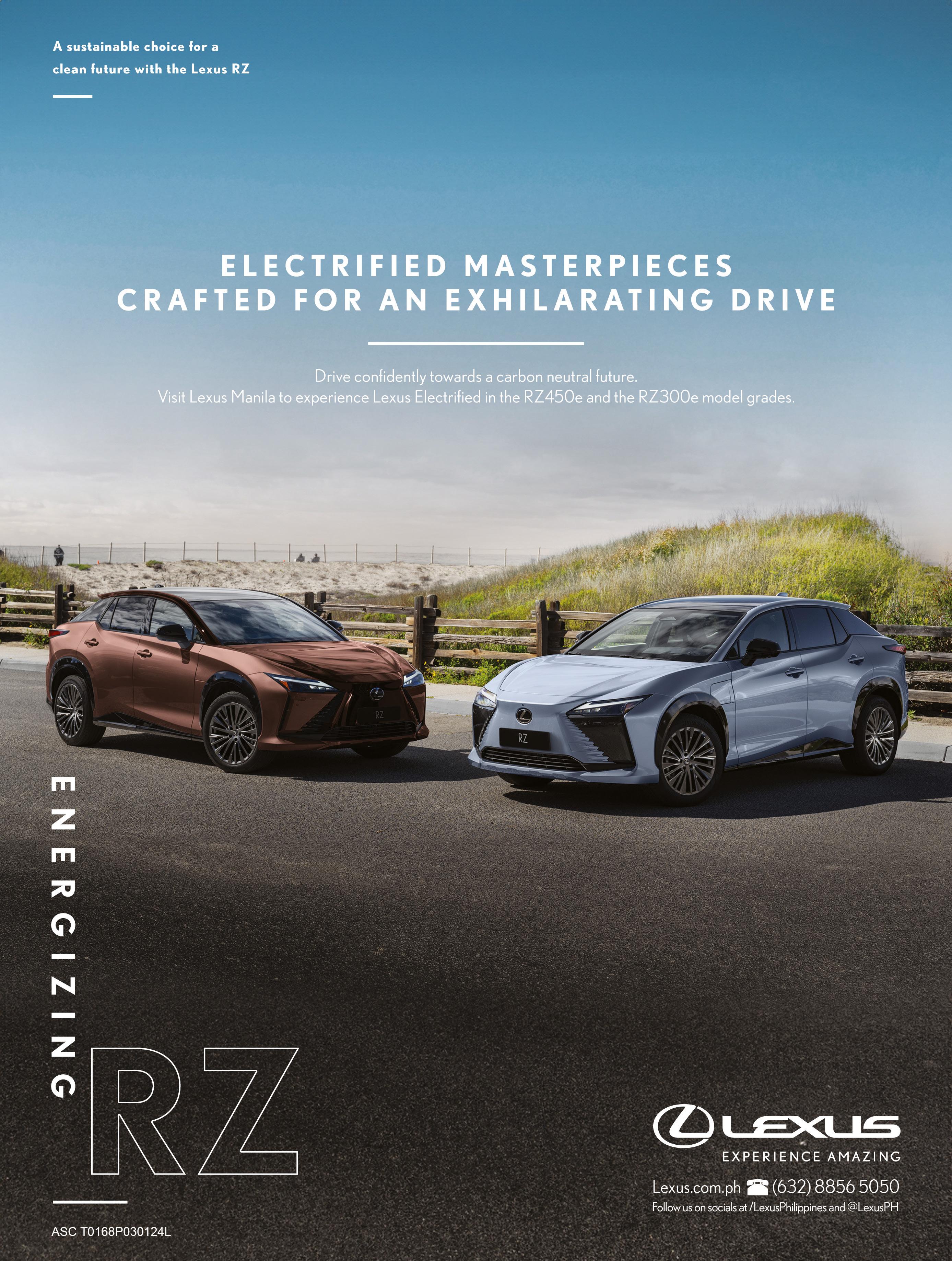



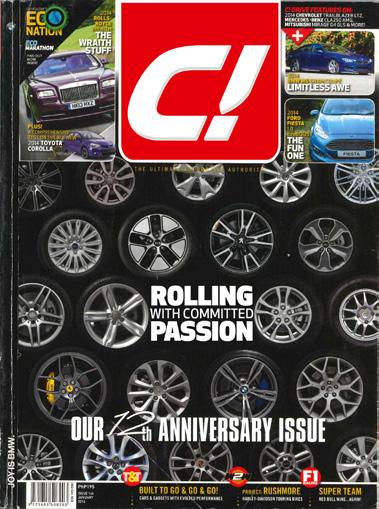
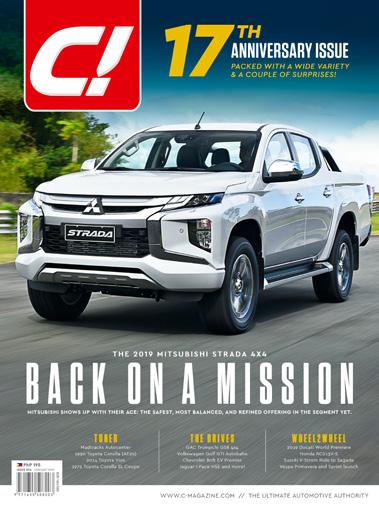
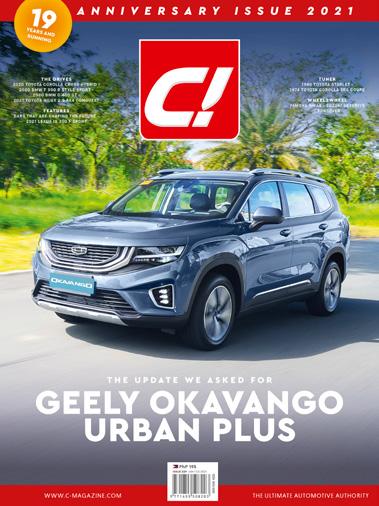

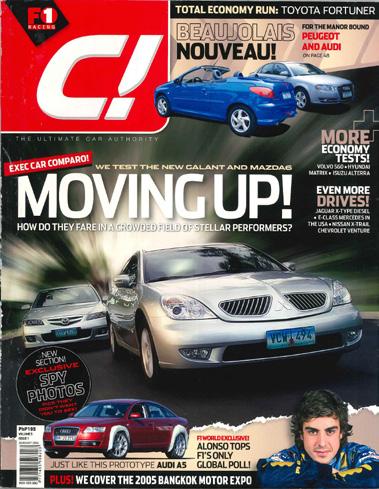

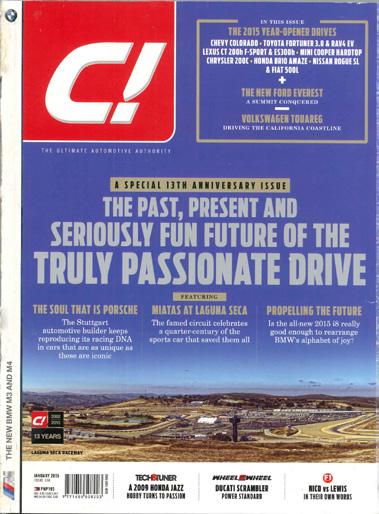

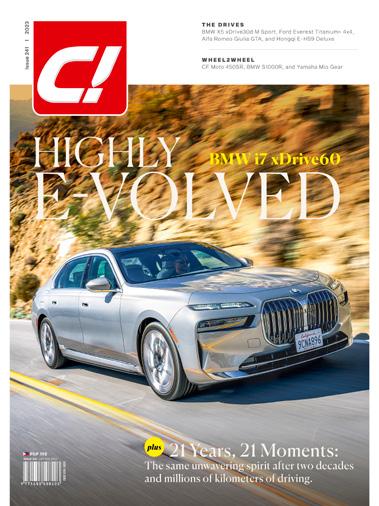
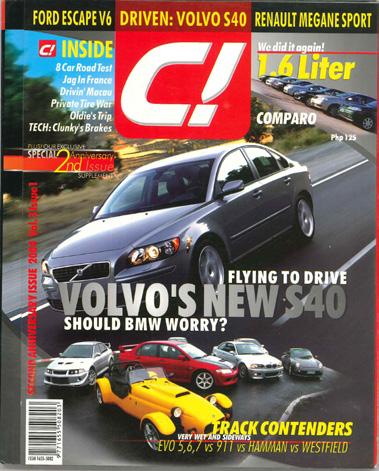
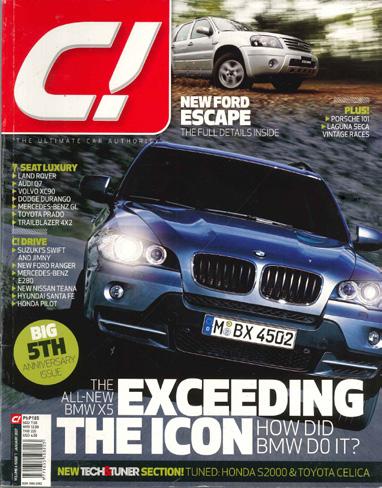

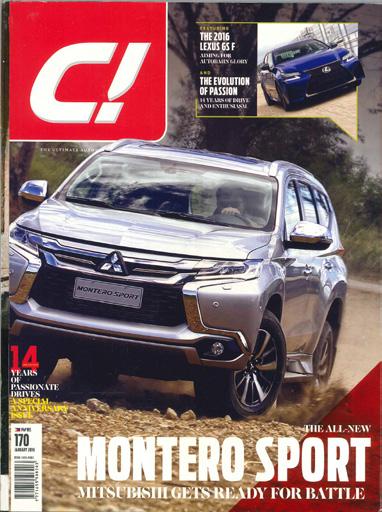

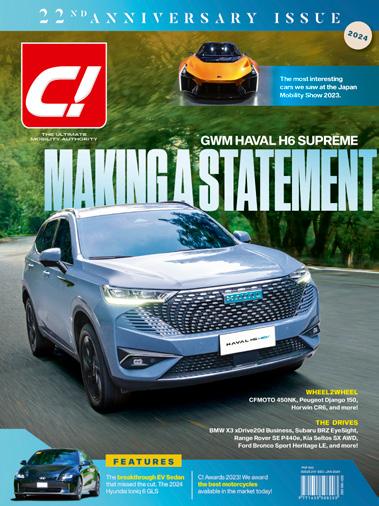

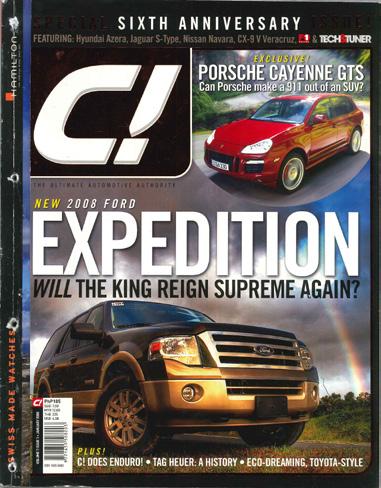



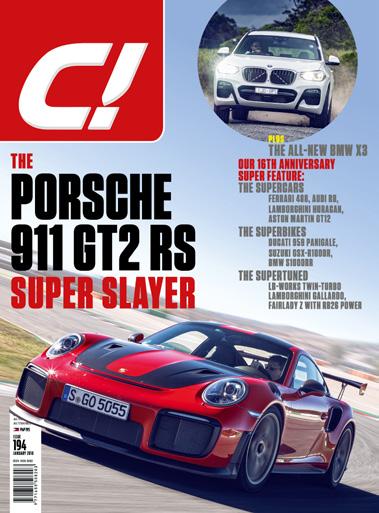
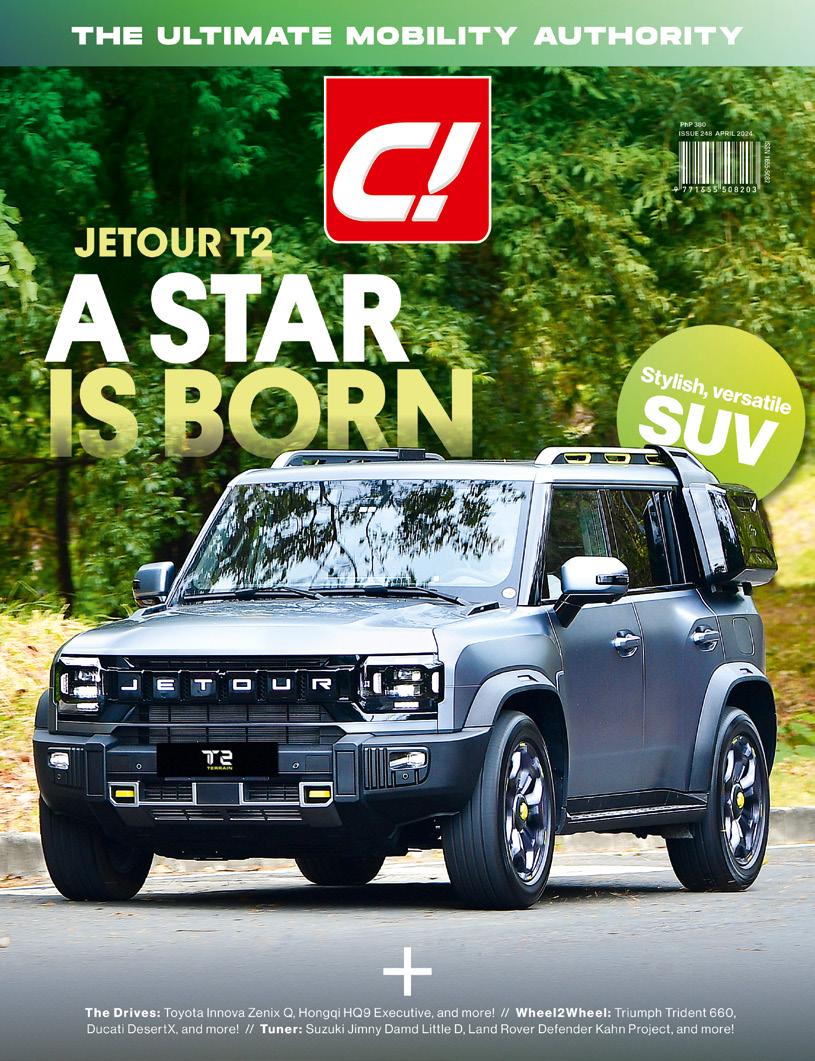

For the past 22 years, C! Publishing and Media, Inc. had the privilege to produce and deliver many stories and reviews through the pages of C! Magazines that resonated to our audience and partners. Our brand has seen the automobile industry transform, pivot and grow. We’ve witnessed the introduction and expansion of various aftermarket brands and their distribution network that helped support the automotive industry.
Since our maiden issue in 2002, the media publishing landscape has evolved. Print publications of varied subjects catering to different readership groups have slowly reduced its print frequency as progressing technology platforms shape how the audience consumes information. To immediately connect with and reach our audience, we have made the strategic decision to transition our publications from print to a fully digital platform to deliver daily and weekly news and stories.
We understand that digital content these days is the primary source for fast, immediate and timebound news, entertainment sources, stories, and references. A world constantly buzzing with alerts and content updates every minute, every hour, hurried and fleeting.
So, while digital content offers undeniable convenience and immediacy, print still holds a special place for us and every reader who appreciates the unique charm, tactile experience and appeal of a good book or magazine. Every page turned is a moment of anticipation.
Print offers every reader the time to disconnect and take a break from the usual digital clutter. To take it slow and easy. A familiar reprieve and comfort for early generations and a novelty for the millennials and Generation Z audience.
We believe print will never disappear but also, not be seen and consumed the same way. It’s for this reason will not completely abandon C! publications. In place of our regular magazines will be special coffee-table issues we will produce quarterly. Collectible, highly-curated and well-produced, Special Edition C! Mobility books will bring beautiful selection of evergreen articles and engaging photos.
“Print still holds a special place for us and every reader who appreciates the unique charm, tactile experience and appeal of a good book or magazine. Every page turned is a moment of anticipation.”
CK Buenviaje CHIEF OPERATING OFFICER
With an unprecedented influx of new automotive brands coming from Chinese manufacturers, I think it’s pretty clear that we’re facing a paradigm shift in the industry. Chinese brands are here to stay, that much is clear, but there’s still a palpable sense of uneasiness and trepidation from consumers. That’s to be expected, of course, after 40 or so years of Japanese dominance in the market. The questions are always the same: how durable are those cars? Will they fall apart after five years? How are the parts and aftersales? What will resale values be like? Since these brands have barely hit the five-year mark in the market, most of the answers to these questions are still relatively unknown, and asking our readers or followers to submit or share their experiences can lead to biased results. So, we decided to see for ourselves.
As some long-time readers may already know, C! Magazine has a subsection of reviews where we test cars for the long term. These are either cars we purchased ourselves or cars lent to us for long-term testing. We call it our FastFleet, and it’s something we’re extremely proud of. The latest addition to our FastFleet is a 2024 GAC GN6. With its comfortable amenities, ample seating and luggage space, energetic powertrain, and a price tag below PhP 1.4 million, we’ve long touted it as a worthy rival to the unshakeable Toyota Innova, even winning “Best MPV” on our 19th Annual C! Awards last year.
The value presented by Chinese brands is impossible to ignore, and this is what makes them so intriguing to consumers. Taking the GN6 as an example, it has leather seats, a sunroof, captain’s chairs, disc brakes all around,
great fuel economy, and a comfortable ride for almost PhP 500,000 less than its closest Japanese competitor, which has none of these features. This price discrepancy is great for us, the consumer, as well, since it will add some muchneeded competitive pressure on Japanese, Korean, and American brands to rethink their packaging and lower their pricing as well. Either way, the consumer is the winner.
Be sure to keep an eye out on our website and social media pages for constant updates on this and the rest of our FastFleet cars, and we’ll tell you what it’s truly like to live with a Chinese-branded car from all angles - good, bad, and ugly. We’ll talk about how the materials hold up, what aftersales is like, how difficult it is to source parts, and how the value holds up over time. It might not satisfy everyone’s worries, but it’ll definitely give us some muchneeded answers.
“I think it’s pretty clear that we’re facing a paradigm shift in the industry.”

Chris Van Hoven EDITOR-IN-CHIEF

Phones detract from your ability to concentrate on the road and increase your chance of a collision by nearly 400%.
“Jetour’s
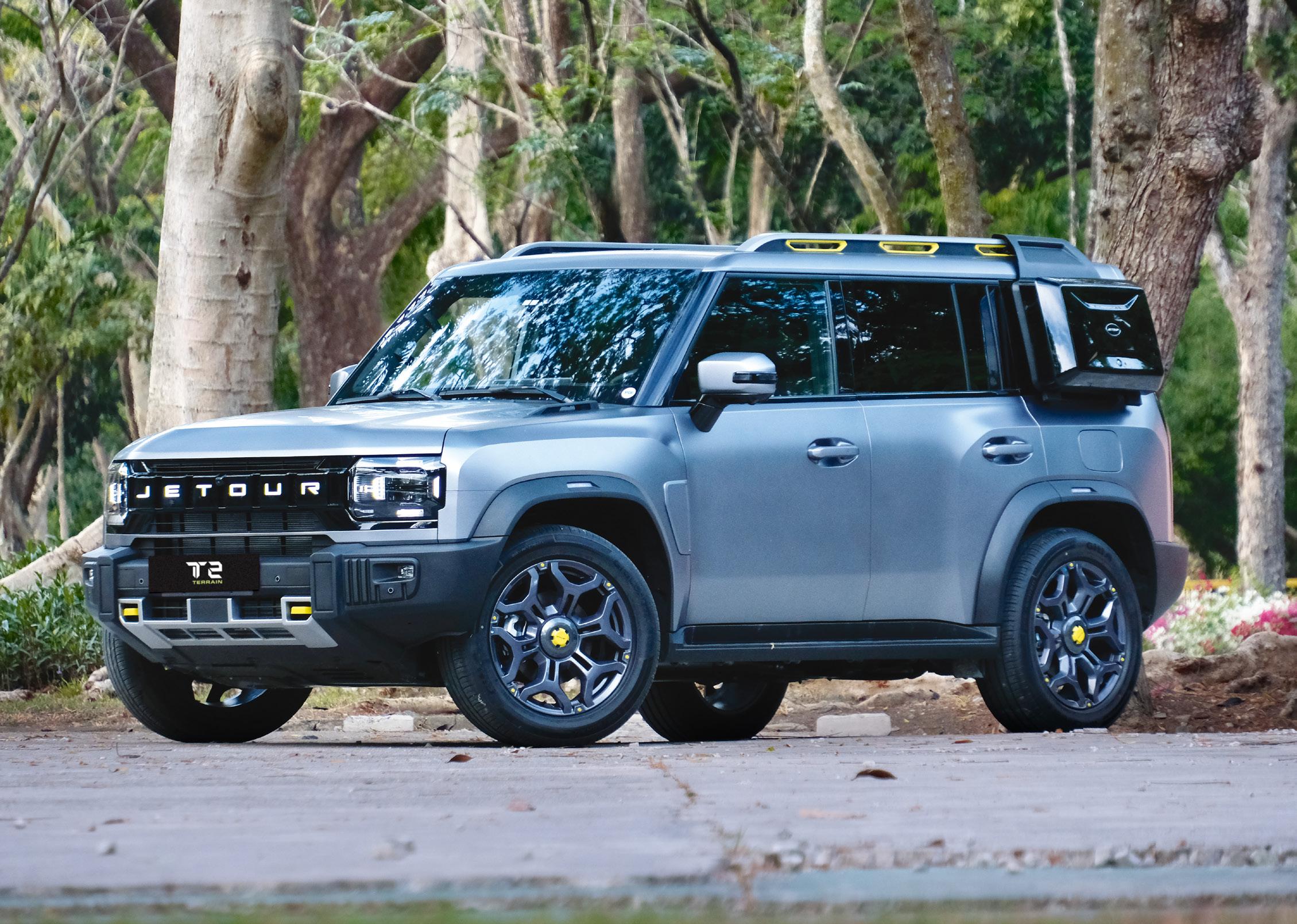
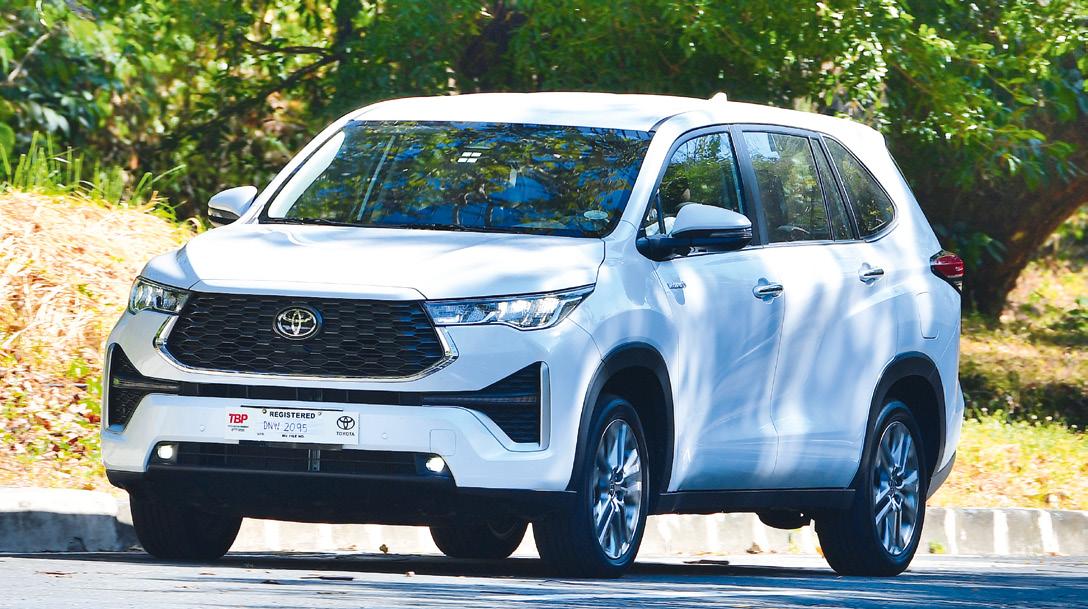
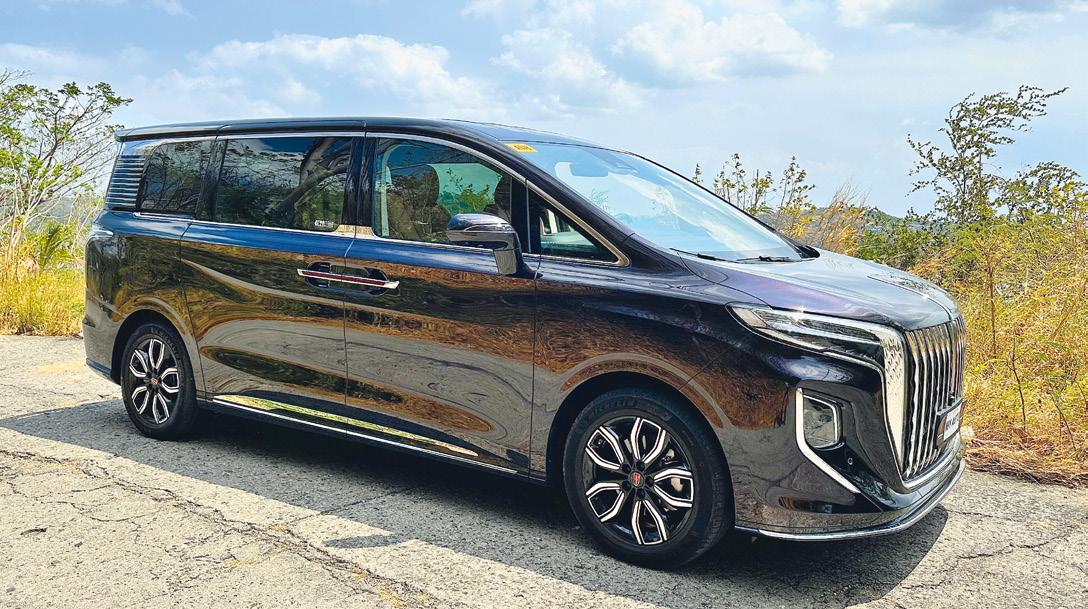


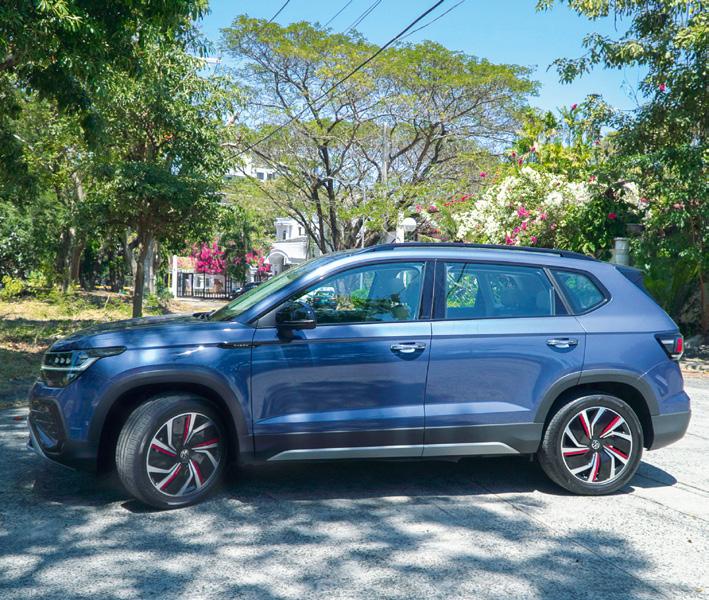
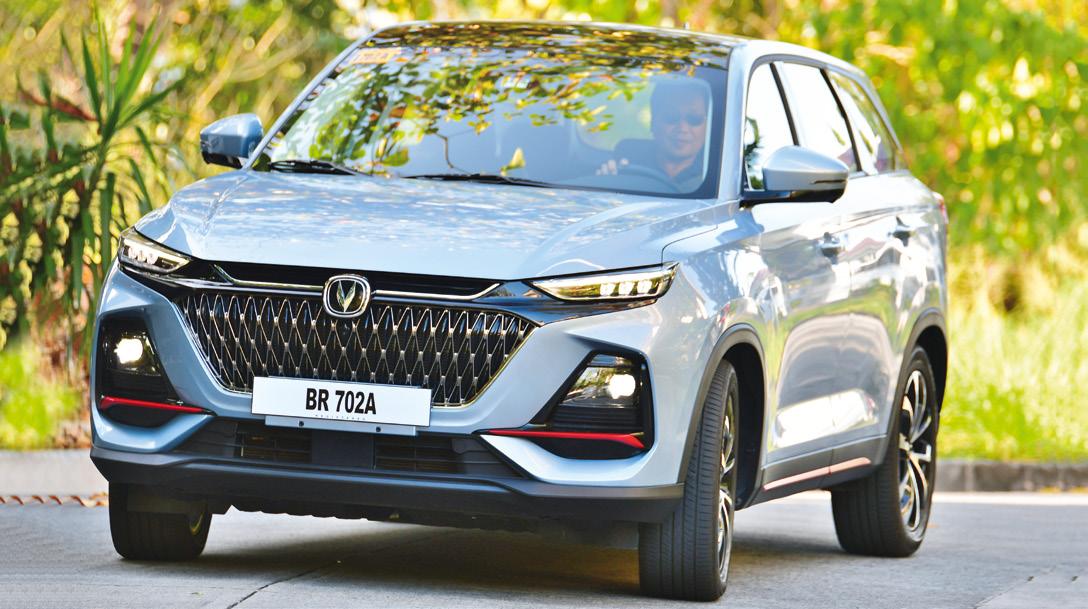






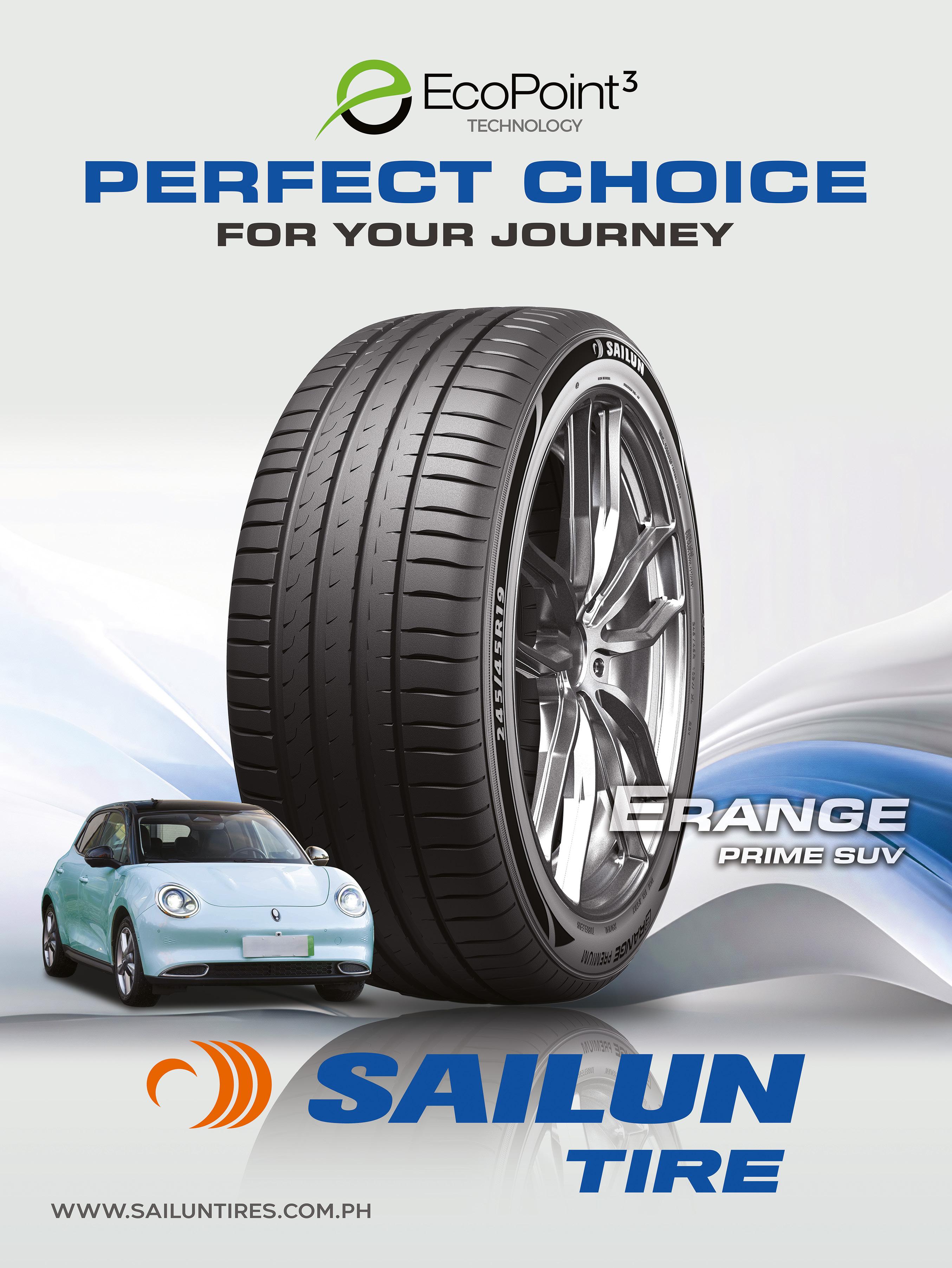

“There is so much more to Quiapo than what meets the eyes, ears, and nostrils.”Preservation’s Plenty Phases A Heritage Walk around FEU and Quiapo By Martin E. Z. Lopez

“Aside from collecting different forms of artwork and collectibles, Ivan also considers himself an avid motorcycle enthusiast.”
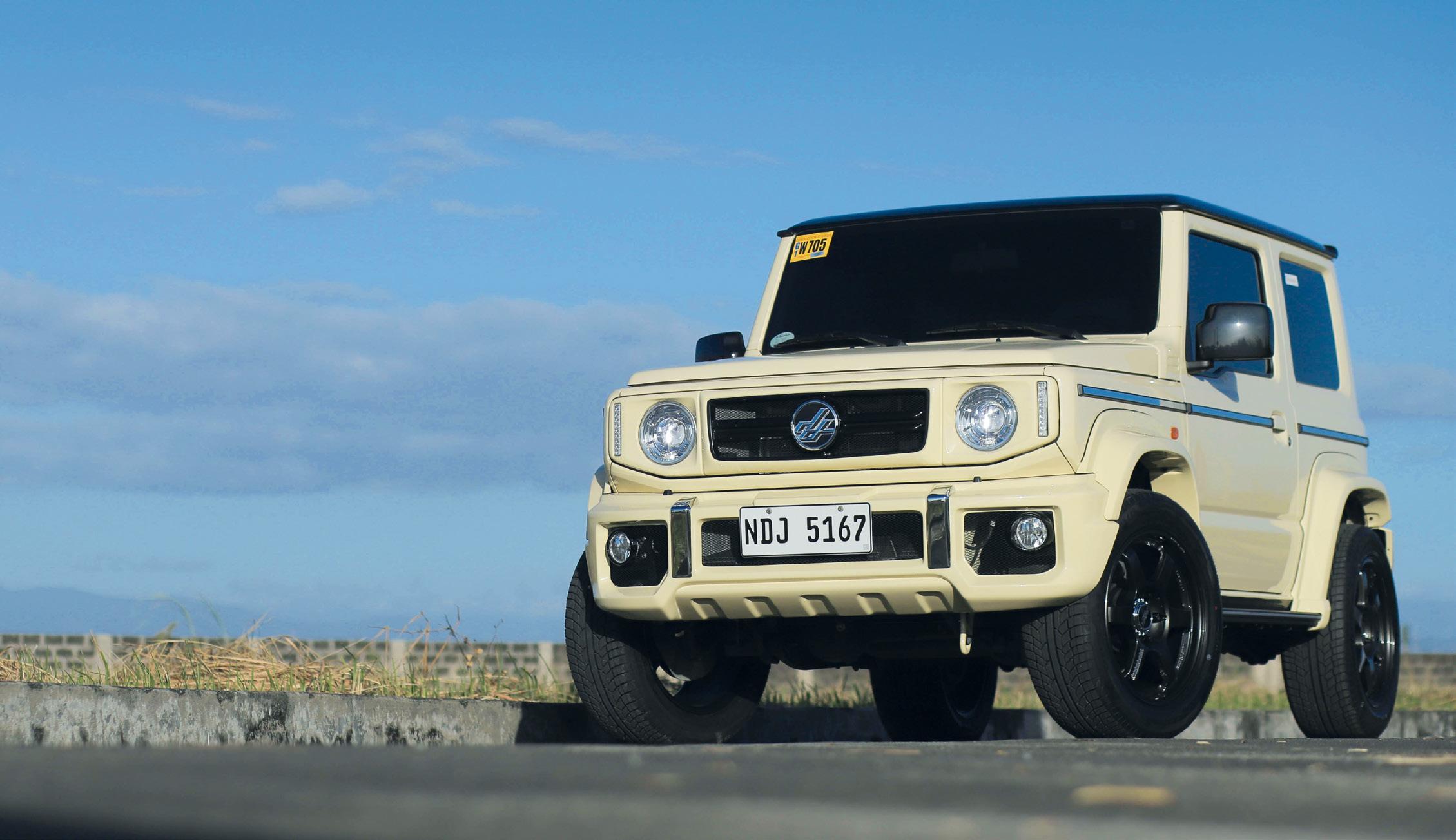


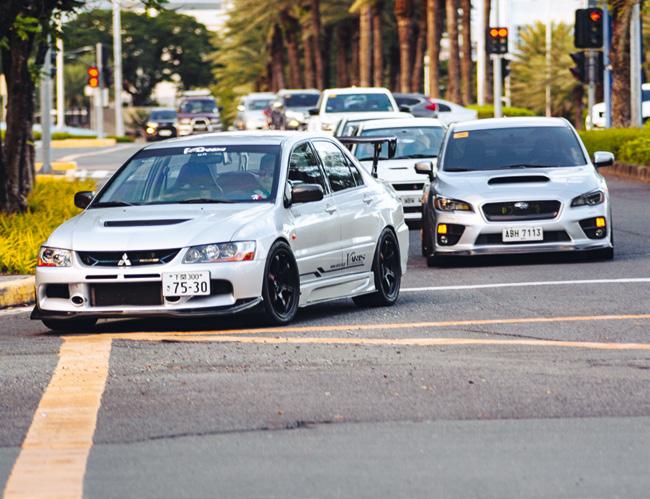
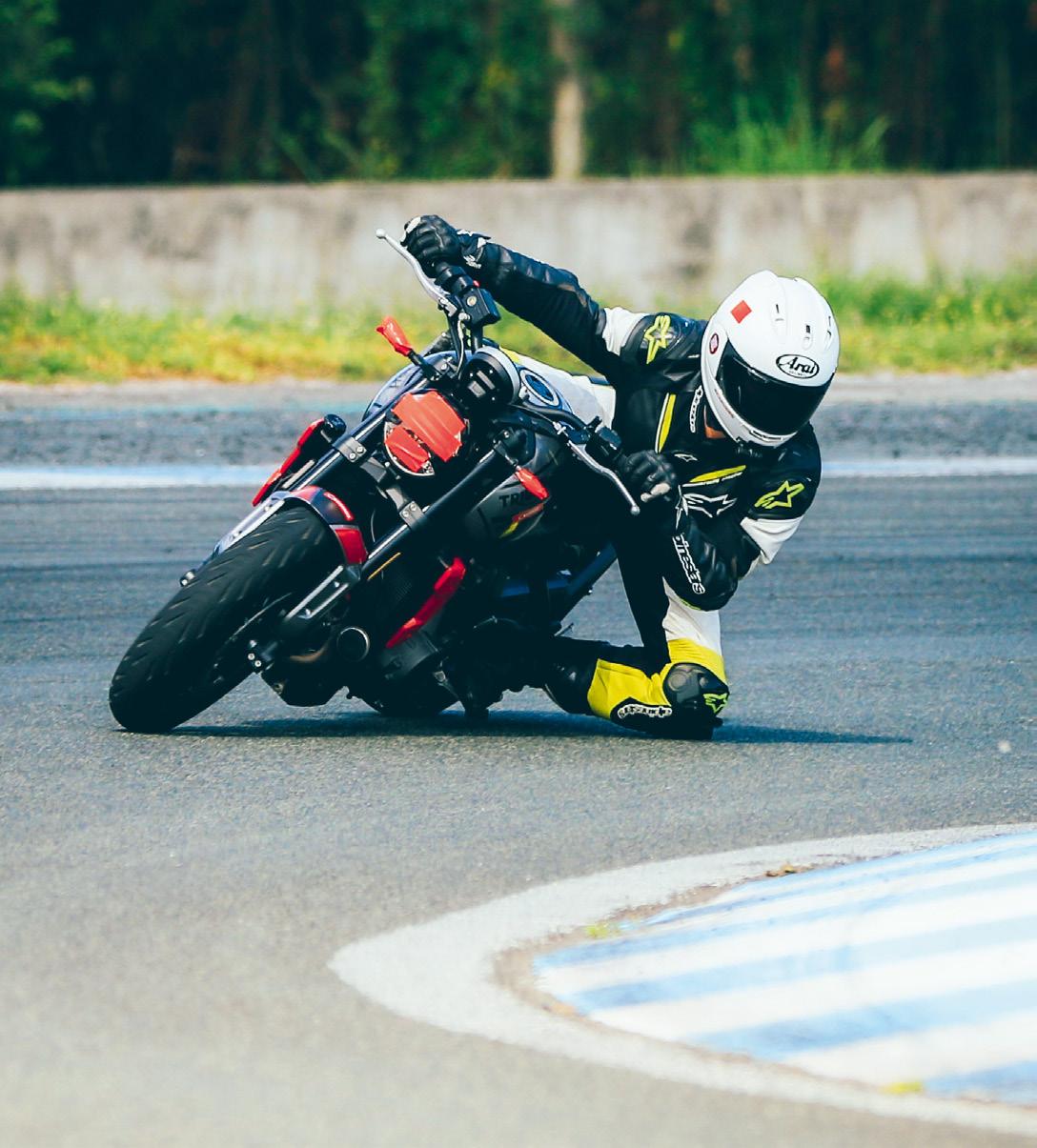
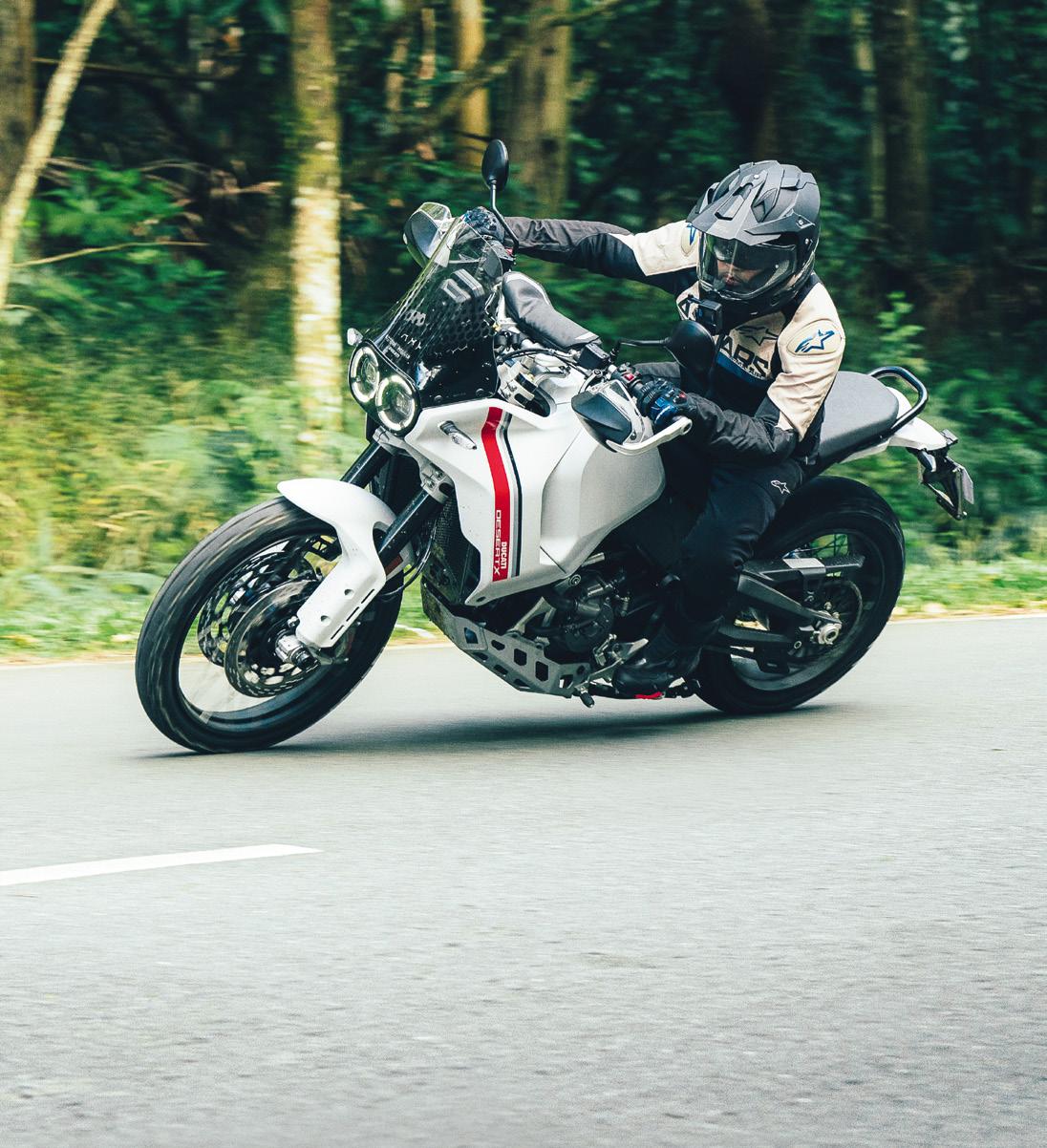
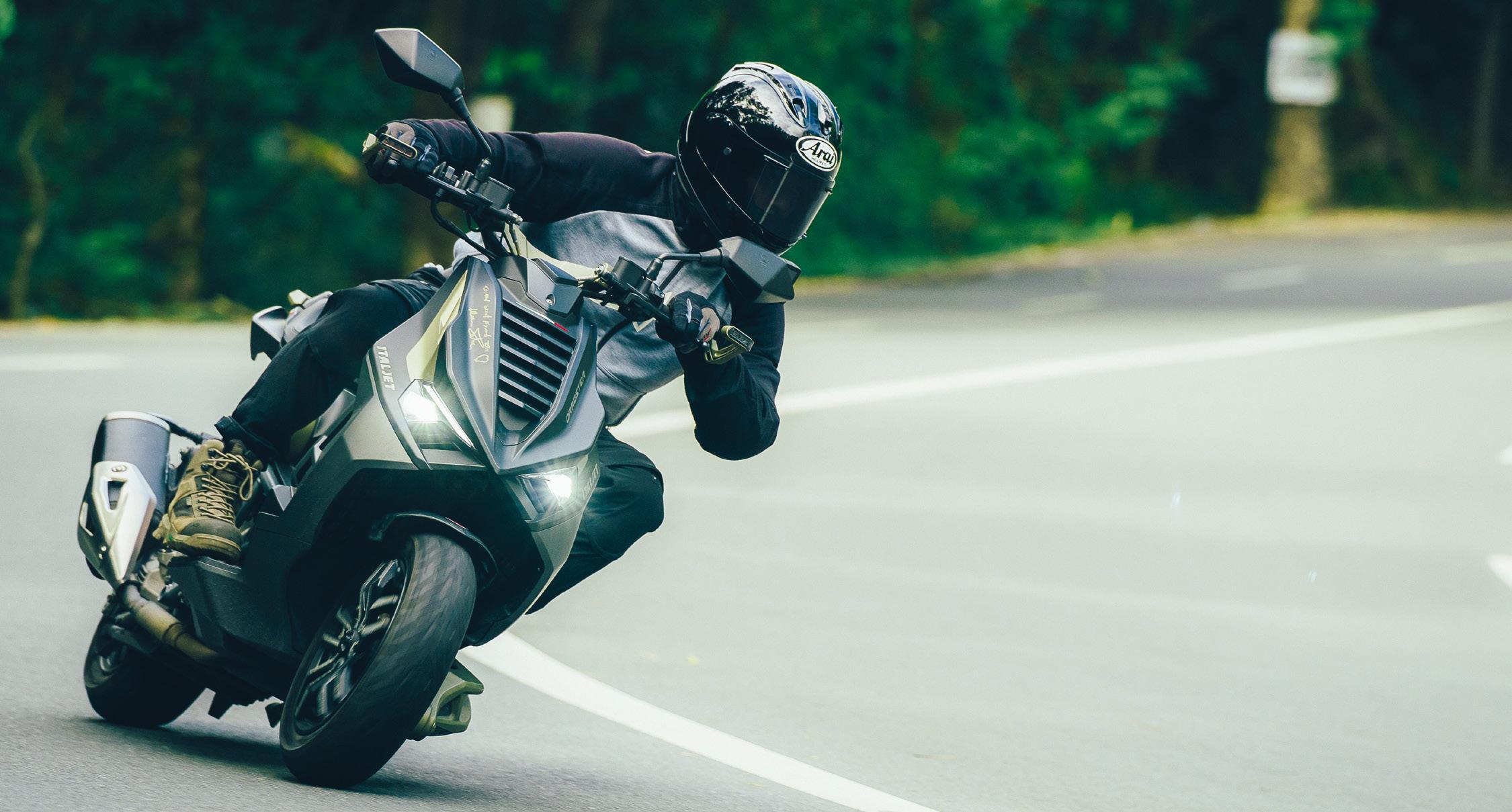

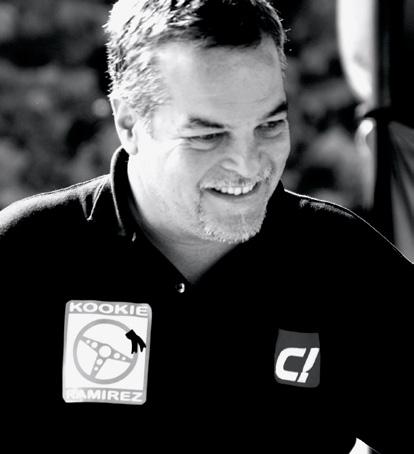



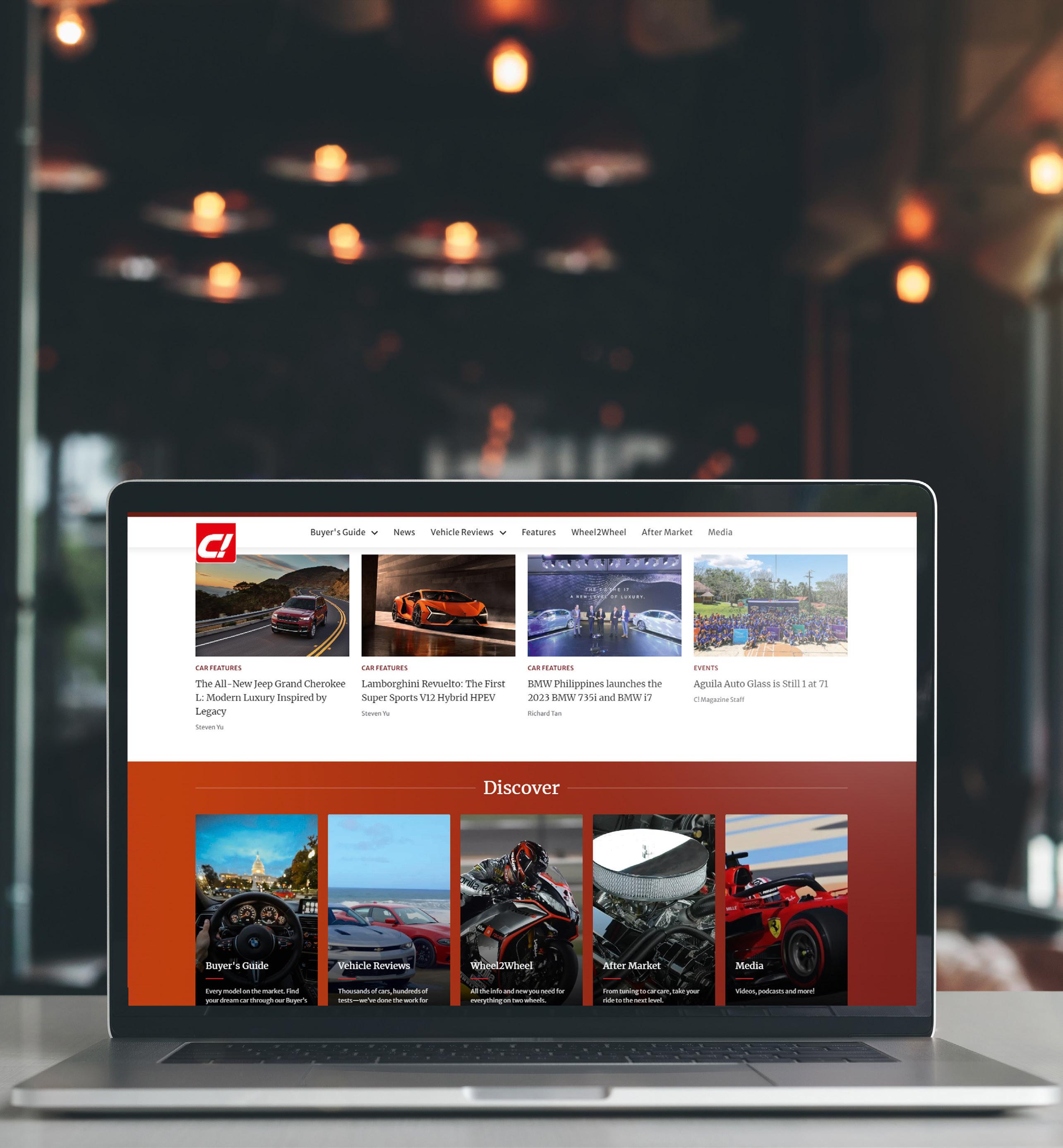
• Updated comprehensive buyer’s guide
• Car reviews
• Videos
• Feature stories
• Deep archives spanning almost two decades of dedication and passion!
www.c-magazine.com
Enjoy all of our best stories, instrumented test reviews, and so much more, from our pages to your screen!
Since my last two editorials, I have been driving a few more EVs, and as I mentioned, I will continue to experience even more as 2024 rolls on. MIAS Manila International Auto Show is just after Holy Week, and I am interested to see what new offers will be shown in our fastgrowing EV market.
I can recall two years ago, some individuals telling me with such certainty that battery technology had maxed out and wasn’t going to go any further in the way of range. Yet, here we are, doing what humans tend to do, breaking the records previously set. Both in the realm of range and speed of charging, we have doubled, and I don’t see any slowdown in this department.
On the other hand, you have the Mavericks like the logistics company Mober who have taken a proactive approach and intend to have 100% of its fleet going electric next year (2025). If they can do it and remain to be a profitable business, I don’t see why others cannot.
There are several of these Mavericks, some are tricycle groups who have taken it upon themselves to go electric and find it to be more profitable, and they keep growing. Another telling example of it being feasible is the proliferation of these private small tricycle type electric vehicles that provide affordable mobility for families in humble neighborhoods. It is in the segments of our
society that are most sensitive to things being affordable or profitable that we find this organic type of growth.
As for those who can afford to buy these new cars being offered in the market, the infrastructure is there for now. For those with homes who can charge every day, it’s fine, as well as, for the most part, traveling to the more common vacation areas. But if sales start to grow, and I feel it is already off to a good start, we are going to need to roll out DC charging stations at a quicker pace.
DC chargers are the fast ones and are what we need for the transient motorist as he is going long distances and therefore doesn’t want to wait long to charge. When traveling North, an example is Shell in Rosario which is a few meters off the rotunda at the end of TPLEX.
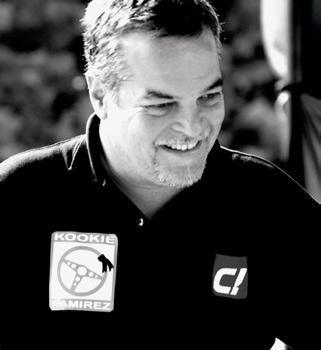 Georges B. Ramirez SENIOR EDITOR
Georges B. Ramirez SENIOR EDITOR
If you’re going to climb a mountain like Marcos Highway to Baguio and are a moderate driver, just multiply your range by 2, and you should be good. If you are a bit aggressive, multiply by 3 or simply have a cup of coffee and charge in Shell Rosario. To give you an idea, 20 minutes in the DC charger in Shell Rosario adds 38% to the battery’s charge or 148km to your range. Shell to the Manor is 50 km.
Then there are AC chargers that are, for the most part, the slower ones. If you are buzzing around the city or suburbs and would like to charge a bit during a stop at the mall or resto an AC 22 kW would get you about 25% in about two hours.
The AC 7 or 8 kW chargers are more for homes, hotels, resorts, or any place you are staying overnight, and the portable ones that come with most EVs are even slower and would need 11 hours to get 60%. So, just for home use or an overnight place but with the intention to top up in a faster public station.
So, for now make sure you get to know where and what type of charging stations are around you or on your planned trip. This would also help remove anxiety and another would be to put on Waze and see how many kilometers to get to your destination, then look at the range of the car and see if you have any real concern.
Today’s EVs have 400 to 650 range, and that’s a lot of kilometers.
Richard Tan
DIGITAL MEDIA HEAD AND SENIOR ONLINE EDITOR
Steven Edward Yu
ONLINE AND SUPPLEMENT EDITOR
Stephanie Corpuz
DIGITAL MARKETING OFFICER
Odysseiah Reyes
PUBLISHING TRAINEE
Crisanto Javier ONLINE COORDINATOR
Charie L. Biaden DESIGN DIRECTOR
Mark David A. See SENIOR DESIGNER
facebook.com/cmagazinephilippines
@cmagazineph
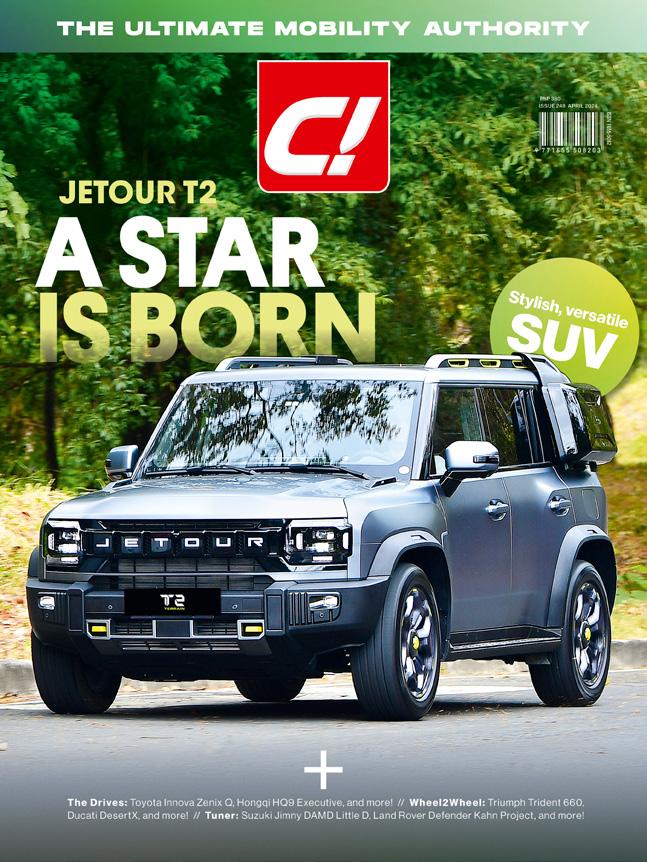
Golez
LEGAL COUNSEL
been possible without the help of:
Hiroshi Suzuki / Shuzo Hoshikura / EJ Francisco / Rueben Jarvina / Nonoy Yulo / Steven Tan / Dax Avenido / Franz Decloedt / Timmy De Leon / Felix Ang / Rene Nunez / Atty. Albert Arcilla / Lyn Buena / Chris Lee Yu / Nora Liquido / Lyka-Mae De La Cruz-Andres / Tony Si / Felipe Estrella / Carlo Ablaza / Raymond Rodriguez / Angelo Barron / Paolo Ella / Chris Yu / Willy Tee Ten / Froilan Dytianquin / Saul Babas / Cameron Arciaga / Michael Dennis Uy / Lawrence Dimaunahan / Akira Utsumi / Norminio Mojica / Dominic Busran / Mark Parulan / Elgie Nunez / Jasper Castro / Nadinne Capistrano / Elijah Sue Marcial / Edmund Araga / Rommel Sytin / Ira Jornada / Spencer Yu / Ramon Ang / Thea Geronimo / Hermes Canon / Jade Sison / Germain Alilio / Dino Santos / Tine Liwanag / Ann Tayao / Cherrey Lou Villaester-Alvarez / Mia Dollentas / Angel Sardoma / Michael Breen / Takeshi Hara / Yosuke Nishi / Alfred Ty / Vince Socco / May Moreno / Antonio Zara / Chris Ward / Uzzi Asuncion / Jimmy Barinaga / Samantha Tabada
AS COMPREHENSIVE AS the all-new 2024 Toyota Innova Zenix Q is, having evolved proportionally and organically from the 2nd generation Innova, the segment standard, I am relieved that Toyota Motor Philippines will continue to soldier on and produce the current ladder-framed model. Our market does need both model family ranges to serve the real-world requirements of the Philippine consumer. The robust old Innova chassis combined with the Toyota 2.8-liter turbodiesel is a very reliable and resilient combination. The incremental improvements over the years have produced a truly versatile, safe, comfortable, and extremely usable MPV that was only limited by its steadily increasing pricing and slow equipment updates.
The handsome all-new Zenix model, especially in its current top-spec Q hybrid variant, is definitely very desirable and ticks most boxes. Even the new 2.0V Zenix model is superior to its gasoline-powered predecessor/ equivalent offering more power, fuel efficiency, and space. If you don’t require the new advanced technology and the extra space, the current 2nd generation Innova with six variants ranging from P1,236,000.00 to P1,789,000.00, will continue to serve you, your family, and your workload with the same guaranteed reliability and duty.
The 3rd generation Toyota Innova Zenix Q (designated as the AG10 series) is a genuine conventional hybrid (Toyota's Series Parallel Hybrid System). It uses a weight saving frontwheel-drive-based GA-C platform Unibody (not to be confused with a monocoque which uses body panels as stressed members) that saves approximately 170 kg (375 lbs.) compared to its predecessor. The wheelbase is longer by 100 mm, which stretched the new cabin by 56 mm (2.2 in) and widened by 46 mm (1.8 in). The ceiling is also taller by 32 mm (1.3 in), so the cabin certainly feels a bit more spacious
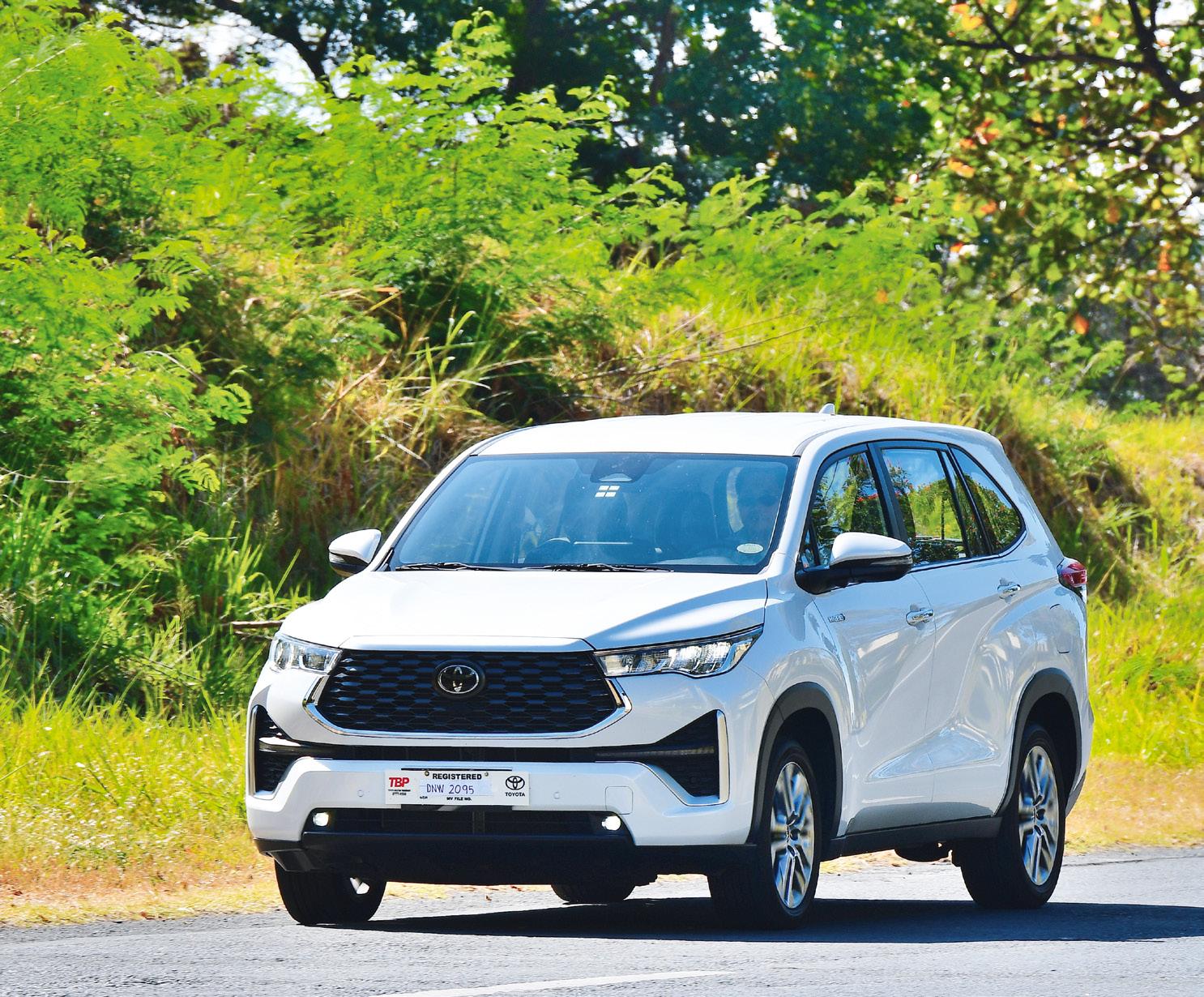
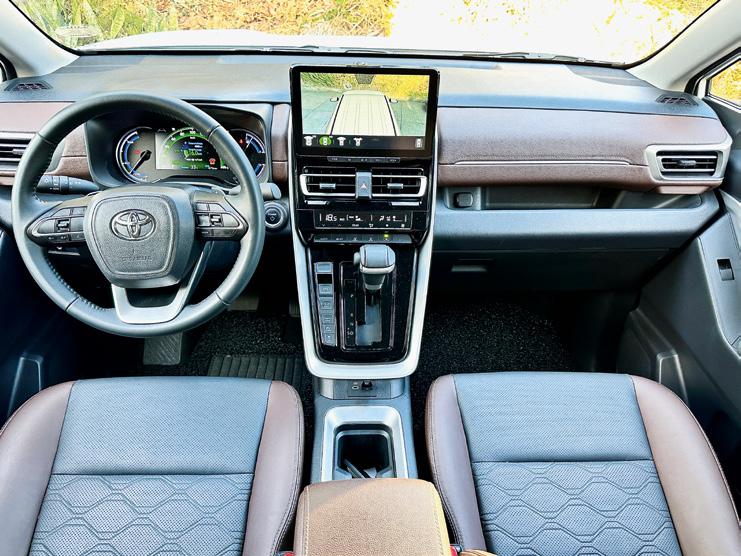


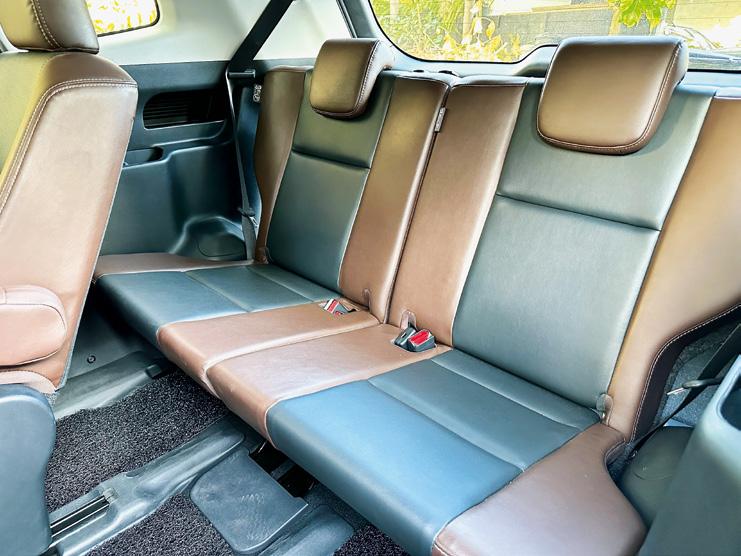


and airier which also allows the new ottoman leg rests on the second-row captain chairs to be enjoyed unencumbered. The new flat floor (the rear driveshaft has been removed) helps liberate even more space and increases passenger comfort now that the driven wheels are in front. The new configuration also allowed the Zenix to finally lose the cumbersome space-robbing lift-seats for a proper fold-flat third-row split adjustable bench. However, even if the capacity is rated at 7 adults, I still feel that the Zenix is more of a 6-seater despite the increased interior capacity.
The 6-speed automatic transmission has also been replaced with an e-CVT that optimizes the reduced torque from the hybrid system in place of the turbodiesel. The manual e-brake and rear drum brakes have been replaced with disc brakes (to help draw charging from the regenerative system to service the modest nickel–metal hydride
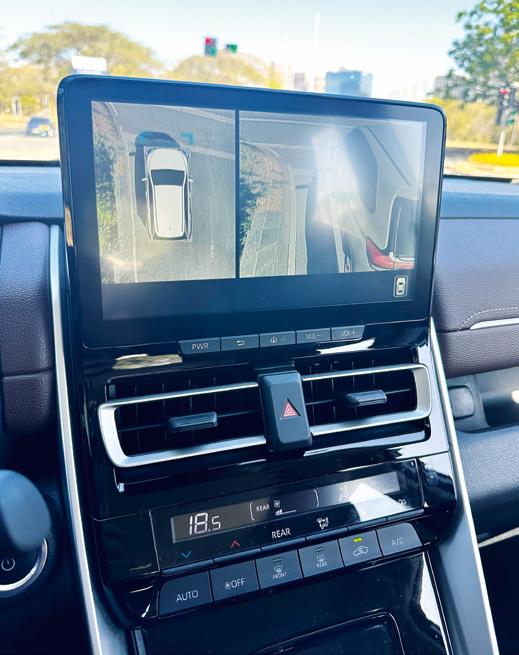
but it is also a completely new effortless system altogether with quicker response and accuracy but without the weight and visceral communication with the driver like before.
The all-new Toyota Innova Zenix model series is already a resounding sales dynamo despite some of my criticism. It is truly better overall than its predecessor, depending on individual needs, yet it also does not orphan the current model range which is a masterstroke for Toyota Motor Philippines. [Ni-MH] battery located beneath the front seats) and an electronic parking brake which also allows auto-braking in heavy traffic. The important Toyota Safety Sense 3.0 comprehensive safety suite is standard in the new Innova Zenix Q model only.
I appreciate the application of the Hybrid system which also means the Zenix Q is exempted from traffic number-coding among other benefits but I did expect considerably more power and a more vibrant driving experience. The Zenix Q is slightly quicker than its predecessor and is certainly tangibly more refined but somehow in the process of achieving cleaner efficiency, gaining standard kit, improving NVH, and safety, the Innova lost some soul, raw ability, and character. It does travel and handles like it is a lighter and more efficient MPV considering it is larger and more spacious. The steering feel has changed exponentially not just because of the drivetrain

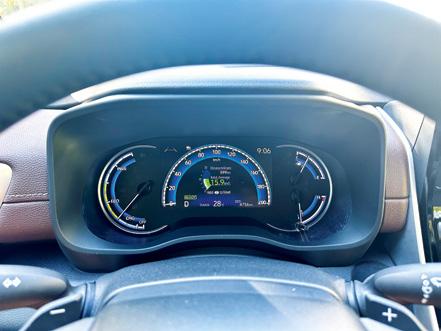

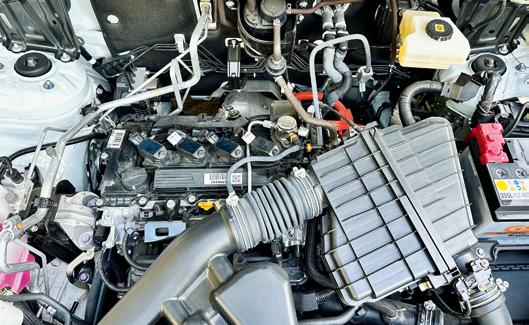
The interior design and execution are definitely vastly improved, highlighted by a steering wheel that has full remote controls that finally include adaptive cruise control, an auto-dimming rear view mirror, a 10.1-inch central infotainment system with wireless Apple CarPlay and Android Auto heard through better than before six speakers (but would have been considerably better with the 9-speaker JBL system available in other markets), ambient lighting, the second-row Captain Seats with powered ottomans, and the power tailgate.
Plus Improvements across the board, considerably greener and a touch quicker while being larger and more fullfeatured. TSS. Abundant cup holders and C-Type / A-Type USB ports charging points. Ambient lighting. Powered rear trunk. Wireless phone charger.
Minus Price of admission. Long delivery times. Non-ventilated seats. Only slightly more spacious than the standard Innova. No panoramic roof. 9-speaker JBL Audio System not available yet.
with anti-roll bar, coil springs, and dampers.
• Fuel Capacity: 52 liters (13.7 gallons)
• Load Capacity: 239 liters with third row fixed, 991-liters with third row folded flat
Ground Clearance: 185 mm
• L x W x H: 4755 mm x 1850 mm x 1790 mm
• Wheelbase: 2850 mm
• Brakes: Front 12-inch (305 mm) ventilated discs with 1-piston calipers / Rear 11.1inch (282 mm) solid discs with 1-piston calipers, Integrated Electric Parking Brake, ABS, EBD, HDC, DSC, BSM, 360º View Monitor, Regenerative Braking, Toyota Safety Sense 3.0. Wheels: 18”x 7.5J Multispoke Alloys • Tires: P225/50R18
Photos: Isabel N. Delos Reyes
MINIVANS MAY HAVE flourished and celebrated in the North American mass market with the development of the Dodge Caravan that began in 1977 with sales starting in 1984 but for our region and our country in particular it was the 1st generation Toyota HiAce that started our multi-passenger mobility since 1967. The actual very first production minivan that aimed to be the first versatile multi-passenger mobility solution is the 1936 Stout Scarab. For Europe in 1950, it was the Volkswagen Type 2 “Kombi” that started their charge for capacity and versatility, then in 1984, it was the Renault Espace that was the first to offer the expanded family all-rounder solution in that market with a touch of luxury and a variety of standard extra creature comforts.
The Philippine minivan automotive landscape was changed forever when Toyota Philippines began importing the 2nd generation Alphard that featured the first official ottoman leg rests for the second-row captain’s chairs in 2011. Seemingly, since then, the comfort craze has spread worldwide through multiple brands with many sedans now even offering the extended comfort feature. The next big wave of minivan evolution has been passed the baton to the Chinese who have raised the bar further with the new GAC M8 and our leviathan test unit here, the allnew Hongqi HQ9 in Executive trim (in Gentian Purple exterior color and Graphic Black with Danxia Brown leather interior trim which looks like terracotta/caramel which I think is the finest available in the range) among others on their way to our archipelago.
The available multi-passenger mobility comfort options in our Philippine market have never been as great as they are today in a time when we also have the most road accessibility despite the overall decrease in average speed of travel. Toyota may have ruled the high-capacity MPV format with the HiAce then elevated it with the Alphard/Vellfire, and further still with the Lexus LM but their pricing,

packaging, and availability has become even more challenging due to the overwhelming market demand.
The Hongqi HQ9 (also known as the Bestune M9 with different skin in other markets) is offered by its exclusive domestic distributor EVOxTerra in two variants, the Executive model tested here, and the higher trim Deluxe model which builds on the already substantial standard equipment with a touch more desirable kit. They are mechanically and aesthetically (exterior) identical. The huge question though is if the Hongqi HQ9 Executive can justify its P520,000.00 premium over the current revised new Toyota Alphard Hybrid? That is not an easy answer.
Toyota’s success with the Alphard has made it a complex buying decision balancing delivery times and varied dealership pricing. The Alphard is now more than ever a passenger vehicle that may not be as dynamic to drive without its old V6 engine but it has evolved to be at its


most comfortable, quietest, most fuel efficient and most full featured, BUT it is much smaller than the Hongqi HQ9 that offers considerably more space and more passenger comfort for all occupants while being more dramatic and a more superior driving experience for the driver which admittedly is the least important factor for this segment. Oh wait, the least expensive Lexus LM 350h 7-seater Hybrid is a whopping P2,078,000.00 more expensive than the significantly larger Hongqi HQ9 but it does have AWD and a longer list of standard entertainment features! Both the Toyota Alphard and the Lexus LM are fully compliant with the Electric Vehicle Industry Development Act (EVIDA) law that offers number coding exemption while the Hongqi HQ9 uses a mild hybrid system which misses the cut despite being a good and efficient powerplant.
Since I do fall under the 1% that would drive this minivan with friends and family throughout our country, I appreciate the
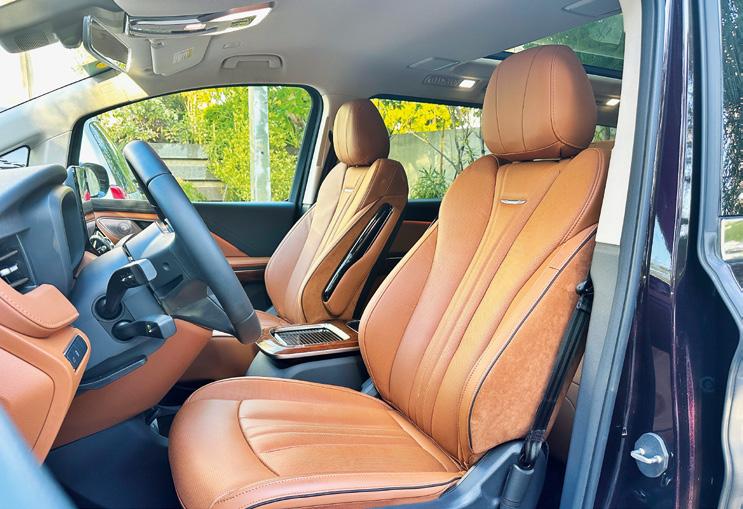

excellent dynamic balance of handling and power in the very solid feeling HQ9 (68% of the HQ9 is composed of ultra-high strength steel). Hongqi engineers applied significant amounts of aluminum in the fully independent suspension combined with generous attention to NVH and even underbody aero measures. In terms of exterior design, the Hongqi HQ9 continues Giles Taylor’s flamboyant design language, with a large waterfall-shaped grille dominating the front end combined with the signature light show. The iconic red badge is placed on the hood and extends down to the middle of the grille which I had hoped would light up. Another selling point aside from immediate availability are also the optional
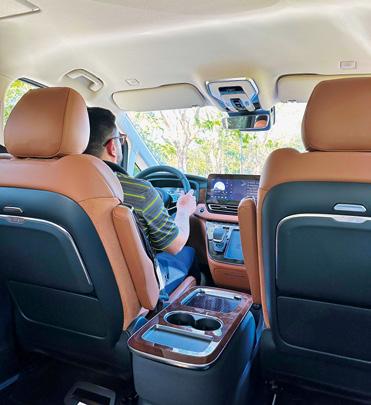

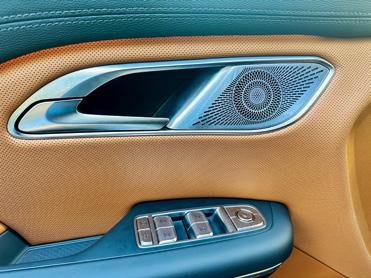



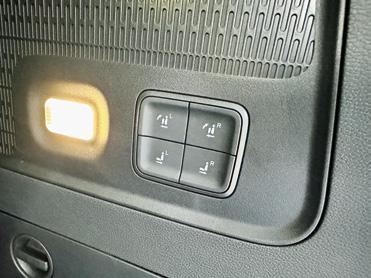
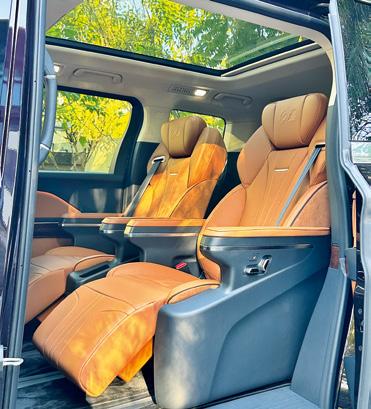
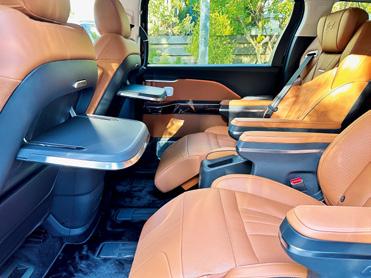

colors which include Dark Knight II, Mountain White, Platinum Gold, and Quantum Silver Grey. In terms of advanced driving assistance, functions such as automatic parking system, SACC advanced cruise system, AEB automatic emergency braking system, and 360-degree panoramic cameras are also standard.
The humongous Hongqi HQ9 is larger than any minivan sold in North America, and compared to the current twining Toyota Alphard/Lexus LM, it is 212 mm longer, 155 mm wider, but 58 mm lower, with a longer wheelbase of 200 mm. It is so large that two full size golf bags can be easily stacked up in the rear trunk with the third row in its fully usable position. Dimensionally compared
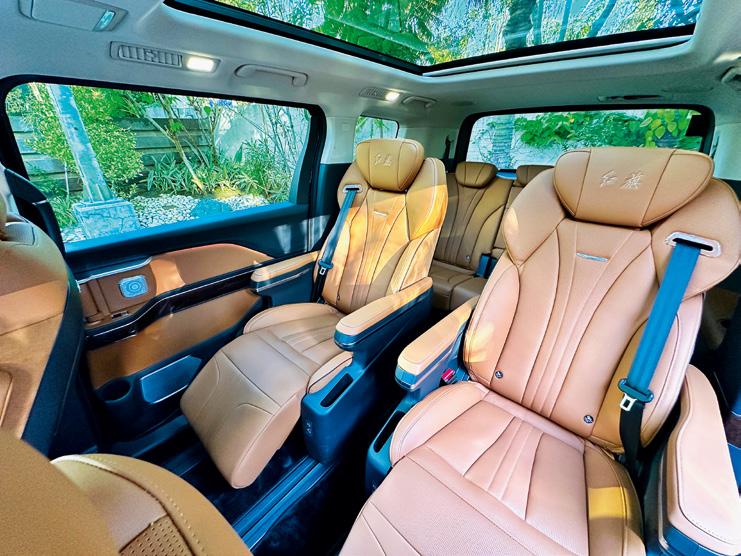
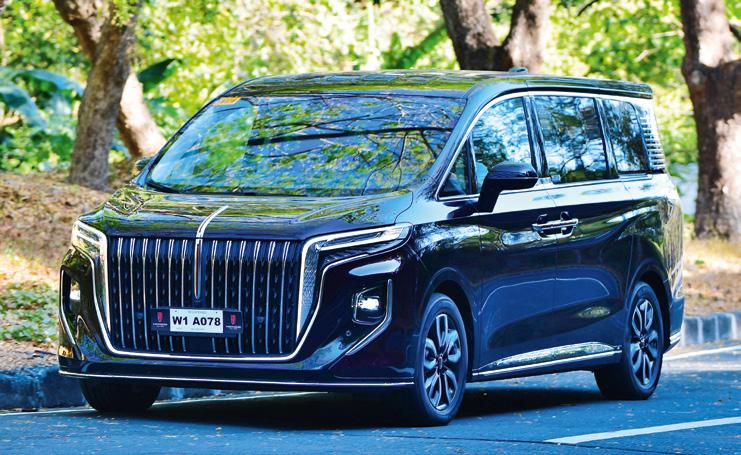

to the GAC M8 (which is currently priced at just P2,998,000.00 for the comparable GL model and P3,948,000.00 GX model), the HQ9 uses a 130 mm longer wheelbase, has a 10 mm longer body, is 112 mm wider, and 69 mm taller. The GAC M8 is its strongest direct competition that does not have electrification, but it is still smaller and uses more modest materials as well as less appealing design features. The Kia Carnival SX (P3,088,000.00) and Hyundai Staria Premium+ AWD 7-seater (P3,030,000.00) both have captain chairs with ottomans too, and are also great minivans but if space and passenger comfort are the most important requirements then the Hongqi HQ9 stands at the top of the segment.
Rating 9.5/10
Plus The new premium luxury minivan standard! Excellent build-quality and polish. Properly opulent at a higher level of comfort and space optimization. Rich details and expansive standard equipment. Powered side doors and rear trunk. Solid sounding 8-speaker audio system. Ambient lighting. Optimal wireless smartphone charger. Crisp 16.2-inch infotainment screen.
Supremely comfortable for both powered sets of second and third rows. Remarkable handling and brakes for its size. Massive panoramic roof with a proper sunshade. Minus Price of admission. Does not have the additional optional equipment found in the higher Deluxe model like the 12-speaker 700-watt Dynaudio, HUD, screen-controlled wider second row captain’s chairs with massage feature, ventilated front seats, second-row window sunshades, and more.
• Transmission: 8-speed Aisin Automatic, Front Wheel Drive with multiple drive modes. • Front suspension: Independent MacPherson Struts with aluminum supports and anti-roll bar
Fuel Capacity: 62 liters (16.4 gallons)
Ground Clearance: 205 mm
• Rear suspension: Independent Multi-link with aluminum support arms, anti-roll bar, coil springs, and dampers.
• Load Capacity: 620-liters with third row fixed in default, 1700-liters of maximum volume with variable settings.
• L x W x H: 5222 mm x 2005 mm x 1935 mm
• Wheelbase: 3200 mm
• Brakes: Front 12.6-inch (320 mm) ventilated discs with 2-piston calipers / Rear 11.8-inch (300 mm) vented discs with 1-piston calipers, Integrated Electric Parking Brake, ABS, EBD, HDC, DSC, BSM, 360º View Monitor, Regenerative Braking, Adaptive Cruise Control.
• Wheels: 18”x 7.5J Multispoke Petal Two-tone Alloys.
• Tires: P225/55R18 102V Michelin e-Primacy
100 kms. combined overall
• Price as tested: PhP 5,550,000.00
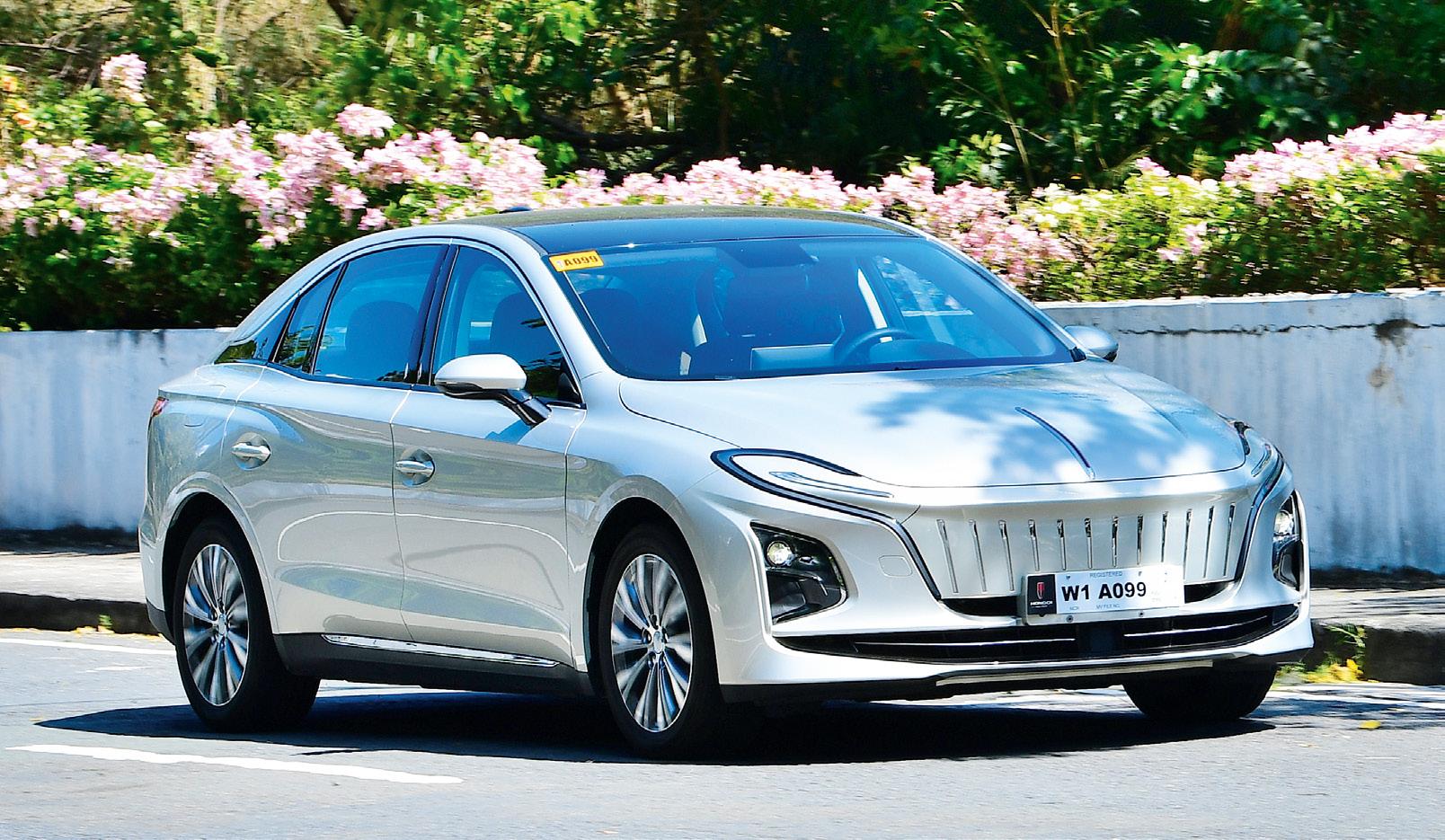
Words: Datu Kevin C. Limjoco
Photos: Isabel N. Delos Reyes
THE HONGQI E-QM5 is currently the second most affordable model in the family range offered in our market which so happens to be a fully electric and very spacious mid-size sedan. It was designed by Giles Taylor so it showcases the signature waterfall front grille treatment first seen on the momentous fully-electrified E-HS9 flagship 7-seater SUV which debuted in our Philippine market in late 2022. And perhaps as a homage to his previous employers (RollsRoyce), the tachometer, in the mostly analog instrument cluster, which is ironic, displays the percentage of power produced.
The E-QM5 uses the underpinnings of the Hongqi H5 sedan, which is the least expensive model in the family, but with a further stretched out wheelbase to accommodate the battery and flatten the floor area to increase rear legroom. The E-QM5 is dimensionally larger than the very stylish H5 sedan in every direction so it definitely feels and looks much larger when sitting in the rear as a passenger. However, despite the increased width, the E-QM5 is best enjoyed with only two people in the back to maximize comfort, which also makes sense too since the original purpose of this sedan during its development in China is for the high-end ride-hailing market.
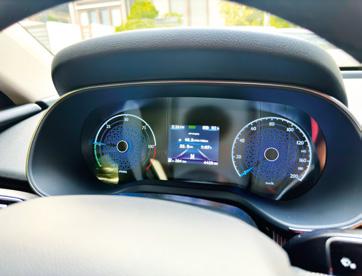
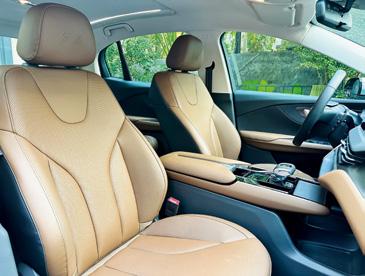
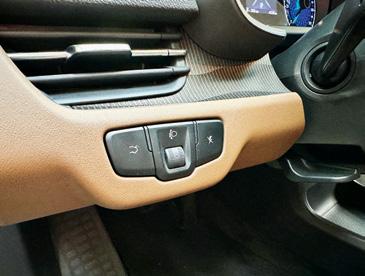


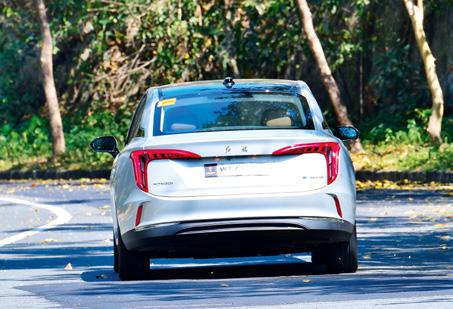


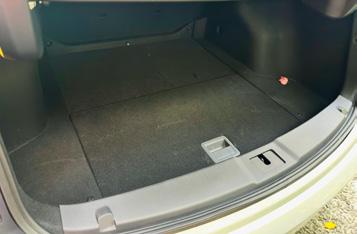
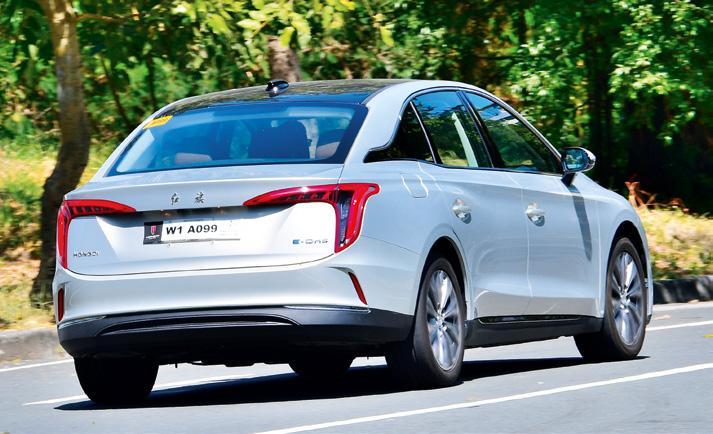
With that in mind, a few more notable fitment/packaging nuances need to be pointed out in particular. The E-QM5 is a good car to drive but it is best enjoyed as a passenger. A) the driver seat would mostly be driven by the family chauffeur so the seat adjustments are mostly manual, B) to start the car, the driver simply steps on the brake pedal to ignite the ignition, C) to switch off the sedan after setting it in the Park position, you have to press a toggle switch on the dashboard to the left of the steering wheel three times.
The copious spaced sedan has key elements in spades despite some compromises.. The brakes are very strong, it handles a lot like its award-winning donor car the H5 but in effortless silence, it is very comfortable, the main 10-inch infotainment screen is sharp and comprehensive, strong full-LED lighting, ambient lighting, strong a/c with rear vents, comprehensive safety equipment, charges in about 7 hours from 0 to 100 % using the supplied home charger, and so much more.
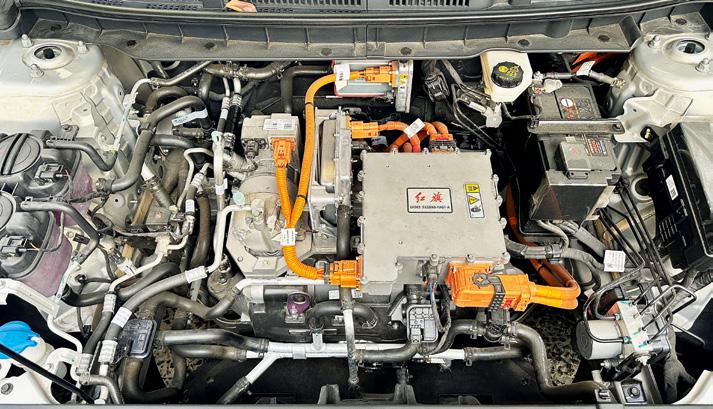
Plus Very spacious cabin, brisk and fairly athletic, very good battery range, good looking, cruise control, and a strong practical pure-EV alternative mid-size sedan.
Minus 560 km (74.9 kWh battery) and 620 km (82 kWh battery) versions available with 188 hp and 236 lb-ft of torque powerplants available in other markets. Only 4-speakers for the audio, no standard Android Auto or Apple CarPlay connectivity. No wireless phonecharger. Rating 9/10

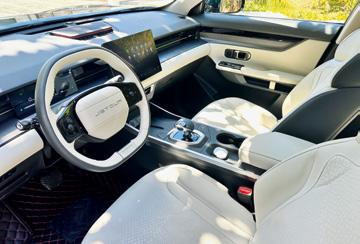
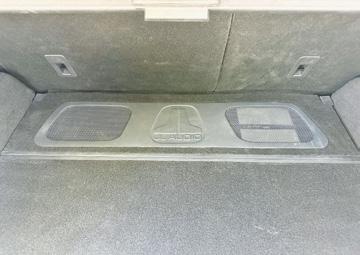

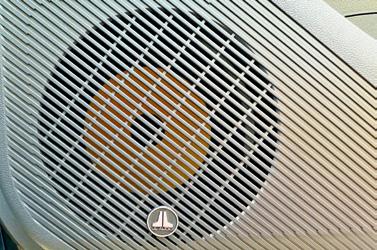
The Wuhu Blitz with a Score
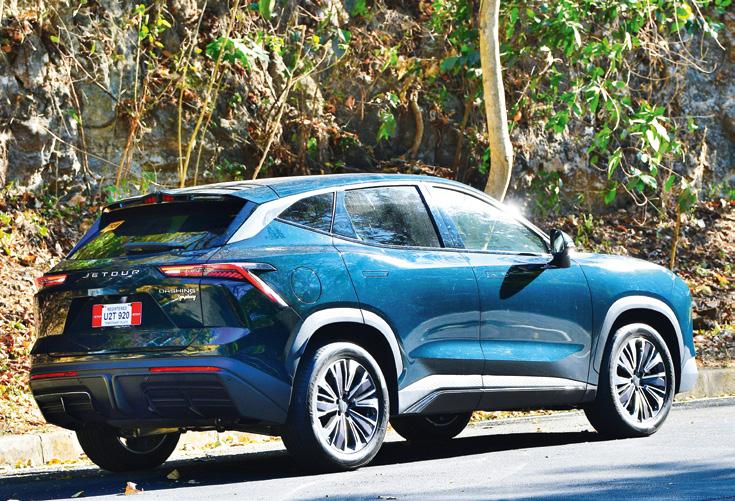
Chery Tiggo 8 EX and the current Tiggo 8
Pro with 1.6T but with a pronounced smaller fastback body. It uses the healthier 1.5T powerplant that used to propel the Tiggo 8 EX in other markets mated to a 6-speed wet dualclutch transmission. With the good brakes, well calibrated fully independent suspension and motivated 1.5T engine, the Dashing is an entertaining and nimble crossover.
and a component speaker system that includes separated woofers and tweeters from American brand JL Audio. The visual difference from the standard system are yellow speaker cones which you can see through the new JBL branded speaker screens while the rear trunk has a new slightly raised yet discreet rear housing for the amplifier and subwoofer that does not reduce rear capacity at all.
The new sound system combined with the elegant exterior color may cost close to P200k more than the standard model but it's worth it especially for the daily grind in heavy traffic. I just wish Jetour allows owners to be able to customize the dynamic ambient lighting further in the near future; at the moment when the unique central dashboard signal lights engage, the illuminated lighting up to the rear doors shut off. And the side mirrors should have their own dedicated physical controls.
Rating 9.5/10
WITH CHERY’S growing success and reputation for reliability and strong aftersales support, their other brands can capitalize on the general shared components to be able to explore differentiation by design, packaging, and specific target segments. The Jetour brand was established in 2018 with the focus on a more youthful and energetic clientele. This very stylish all-new Jetour Dashing compact crossover is a perfect manifestation of that strategy. Many folks still think that the Dashing is a new Lamborghini Urus variant, which is definitely high praise!
The 5-seater compact crossover Jetour Dashing actually uses a slightly longer wheelbase than both the previous 7-seater
It has excellent full-LED signature lighting and nice complex two-tone and textured multi-spoke 19-inch alloy wheels wrapped with 235/55R19 101V Wanli Flash ASO 28 tires. The standard 12.8-inch infotainment system with 6-speakers was alright but what you see here in the special unique model-exclusive Aurora Green exterior paint is the Symphony variant that boasts the excellent 700-watt RMS 9-speaker JL audio system which is leagues better.
The standard 40W mobile phone wireless fast charger is standard. Overall, the Jetour Dashing is a great value, very attractive full-featured crossover with generous cabin space and a very long list of standard kit. The Dashing Symphony system consists of a 10-inch subwoofer, a 4-channel amplifier,
Plus Stand-out looks, unique details, peppy, generous soft interior materials, adjustable ambient lighting, tremendous value, thoughtful versatility and kit, ventilated front seats, entertaining to drive, comfortable. Panoramic moonroof.
Very long 6-year / 1-million-kilometer mileage overall factory warranty with a 10-year warranty on the engine. Exclusive Aurora Green exterior paint and the excellent 700-watt RMS 9-speaker JL audio system. The grey cabin treatment. Wireless phonecharger. Cool Smart Rubik’s Cube key fob. 360° panoramic visual parking assist.
Minus Wish it had the fabulous 197 bhp 1.6T engine. Does not have the optional 15.6-inch control screen, no external environment sensing digital display screen, odd ambient light behavior, and no HUD.
• Fuel Capacity: 57 liters (15.1 gallons)
• Ground Clearance: 160 mm
• Wading Depth: 350 mm
• Load Capacity: 486 liters with rear seat fixed / 977 liters with rear seat folded.
• L x W x H: 4590 mm x 1900 mm x 1680 mm
• Wheelbase: 2720 mm
• Brakes: Front 13.4-inch (340 mm) ventilated discs with 2-piston calipers / Rear 13.4-inch (340 mm) solid discs with 1-piston calipers, ABS, BA, Integrated Electric Parking Brake, EBD, TCS, EBA, HDC, and DBF
• Wheels: 19”x 7.5J Multi-Spoke Two-tone Aluminum Alloys
• Tires: 235/55R19 101V Wanli Flash ASO28
• Weight (kerb): 1495 kg. (3289 lbs.)
• 0-100 km/h (0-62 mph): 9.4 sec.
• Top Speed (mph): 198 km/h (124 mph)
Fuel Mileage: 10.2 km/L Overall
• Price as tested: PhP 1,523,000.00
Decidedly European
Words: Richard Tan Photos: Author and Jarro CabañesIN A TRULY SATURATED compact crossover market, it can be difficult to make a mark, especially when you’re up against familiarity and practicality. That’s why when the 2024 Volkswagen Tharu 300 DSG TSI SEL fell on our laps, I couldn’t help but benchmark it on the same scale as most other compact crossovers available today. The standard is fairly easy to meet, and it does: be as comfortable as a sedan, but also be as versatile as an SUV. Done. Which made me wonder, what’s more to the Tharu?
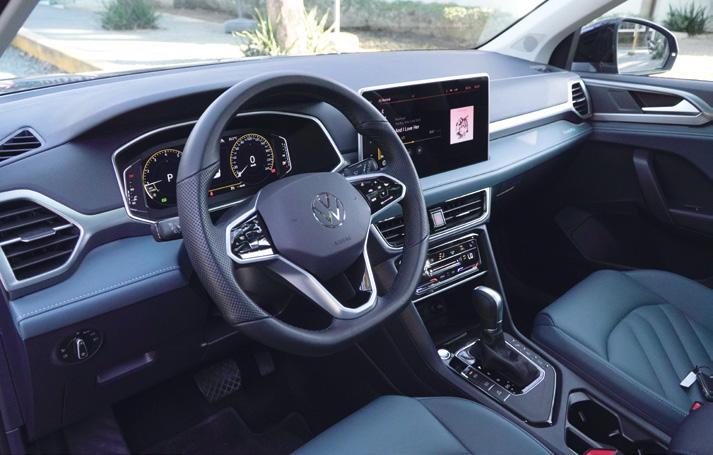

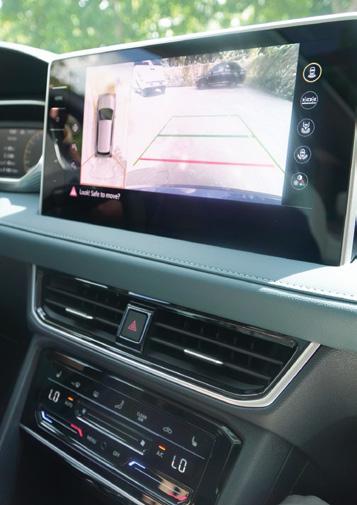
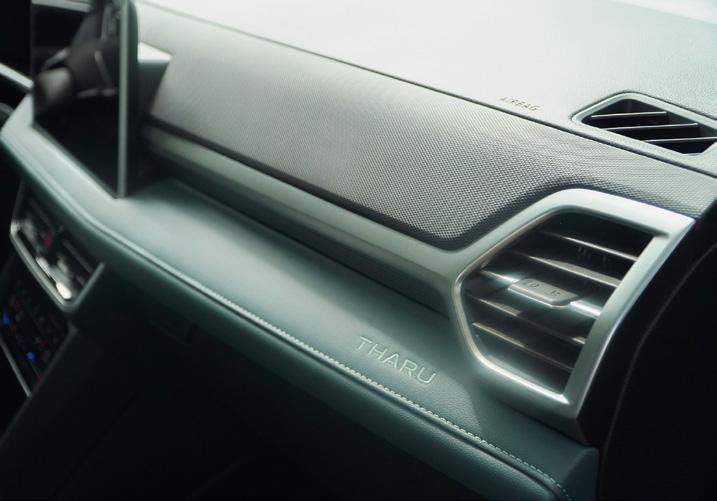
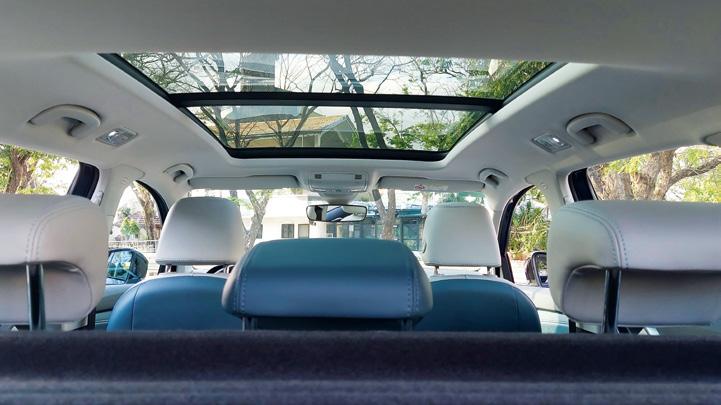
At first glance, the Tharu SEL looks the part of the quintessential German machine: Self-assured, clinical, and focused. Up front, the matrix LED headlights with IQ technology worked as described, providing visibility on turns and even automatically pulling up a high beam on a dark stretch of road. The grille and tailgate LED running lights were a nice touch, I think it gave the car some aesthetic pizzazz I felt it lacked, but it didn’t feel so boisterous that it would turn off buyers looking for something with a classy feel.
Inside, the driver’s seat was comfortably firm, offering ample lumbar support for a larger driver like myself without feeling cramped. I liked that all buttons were comfortably within reach, although I failed to immediately figure out how the touch sensitive controls worked. Unlike traditional buttons, the control panels on the aircon, infotainment system, and certain steering wheel controls worked like a trackpad, with the feel akin to that of the touch surface of an Apple Magic Mouse. Figuring all that out on the fly (aka while taking the Tharu out for an initial spin) is NOT advisable, but once I got
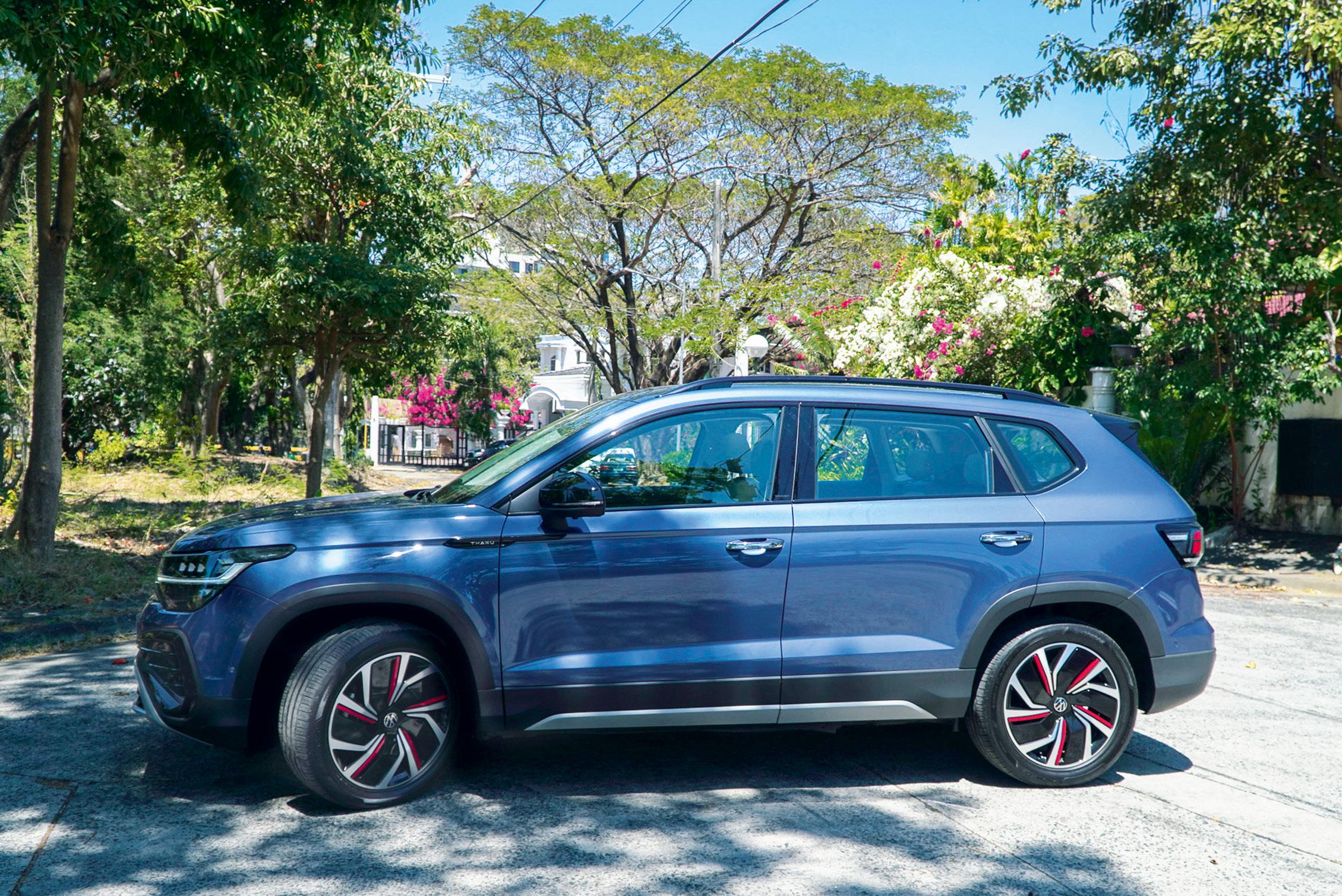

comfortable with it, I saw the appeal. It was a step away from traditional buttons, but not an all-in dive into the non-tactile world of touch screens. This was a nice go-between. The infotainment system can be a little cluttered to some, but it has Apple CarPlay, which is increasingly becoming an essential, instead of a mere enticement. The Area View Camera and Intelligent Park Assist features are helpful, but I hope Volkswagen can deploy a less grainy rear camera in future Tharu iterations.
The steering wheel looks and feels premium, reminiscent of the tiller from the Mk
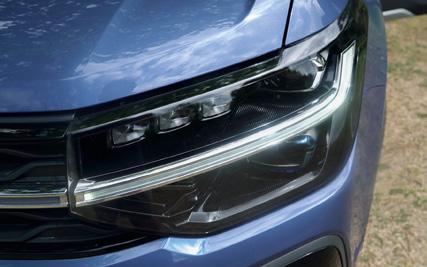
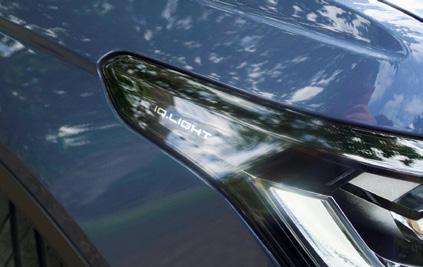
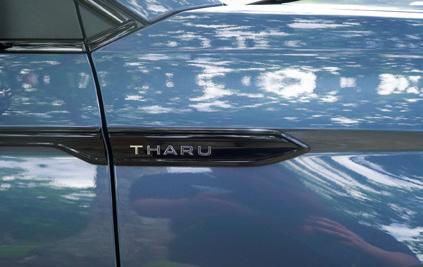
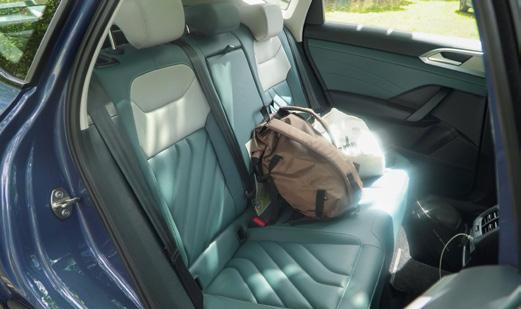
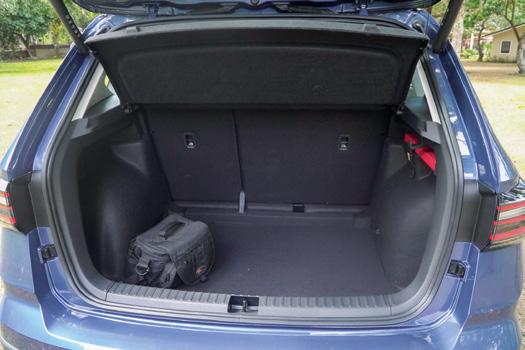
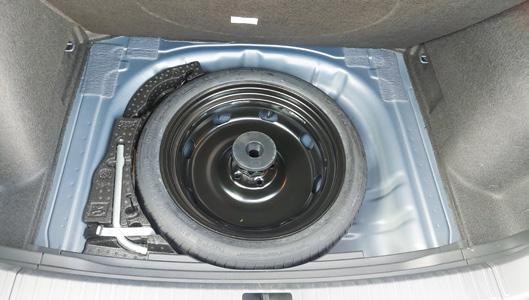
8 Golf (probably because it’s the same one). Holding it at speed delivers joy – perhaps not at pure hot hatch levels, but joy just the same. It’s the gateway to a responsive and nimble car. Elsewhere in the front half of the Tharu’s cabin, one will find a wireless charging cubby, two center console cup holders, and fabulous ambient lighting that wonderfully highlights fine details such as the Tharu stitching on the dashboard and the stylish blue/white duotone leather seats.
Rear seating is ample and I find that the backrest tilts at a more generous angle than
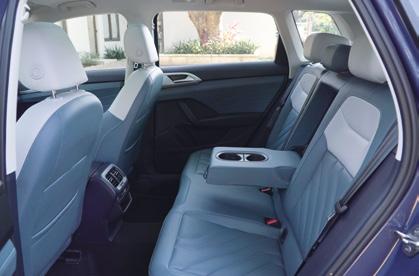



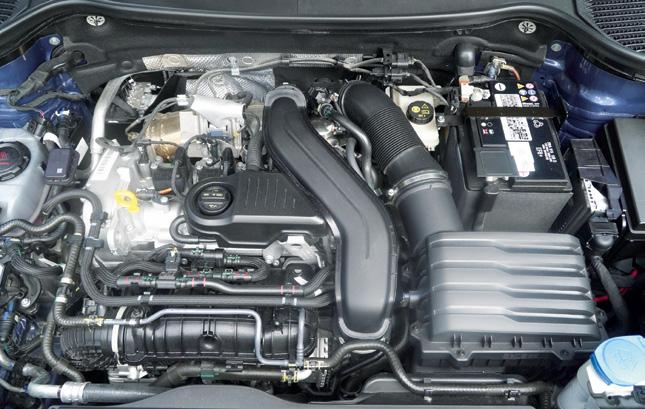
most compact crossovers. One will find a pair of USB sockets right below the second row aircon vent, with a small cubby to hold smartphones and other small items. The trunk has a hard plastic tonneau and 455L of storage volume capacity with the second row seats on the upright position. Stow those down, and the storage capacity goes up to 1,543L, plenty of space for balikbayan boxes or luggage.
Under the hood, one will find the 1.5L 300 TSI with BlueMotion engine, which is mated to a 7-speed DSG transmission, capable of 158 hp at 5,500 rpm and 184 lb-ft of torque between 1,750 and 4,500 rpm. I found the powertrain to be tame at low speeds, seemingly biding its time to go up a notch. As a consequence, I felt like I needed to coax a little more power than I anticipated to do inclines and such. But this is a minor thing to note, especially taken within the context of the car’s BlueMotion system, which aims to improve fuel efficiency through various driving facets, such as dynamic deployment of power, lower tyre rolling resistance, engine/ start stop technologies, and more.
At speed is when the Tharu truly shines as a crossover. On the highway, I couldn’t help but feel a subtle nudge saying, “Hey, I’m still related to the Golf”. As mentioned above, the Tharu is nimble and responsive. It didn’t feel muted to drive at highway speeds as most other crossovers tend to be. The car is able to feel fast without needing to be actually fast. Most consumers may find it difficult to see the practicality of owning the Tharu given the broad crossover SUV spread the Philippine market currently enjoys, but it takes some looking beyond the price tag. In my eyes, the Tharu is an attractive proposition when viewed from the context of the Audi Q2 or the Peugeot 3008: It’s absolutely in the Euro car conversation, especially in terms of build materials, driving experience, and heritage.
Plus Alive at speed, comfortable second row, attractive blue leather upholstery, VW Golf steering wheel, wireless phone charger, oodles of cargo space
Minus Infotainment system takes some learning, reverse camera could have higher definition, panoramic roof liner is on the thin side

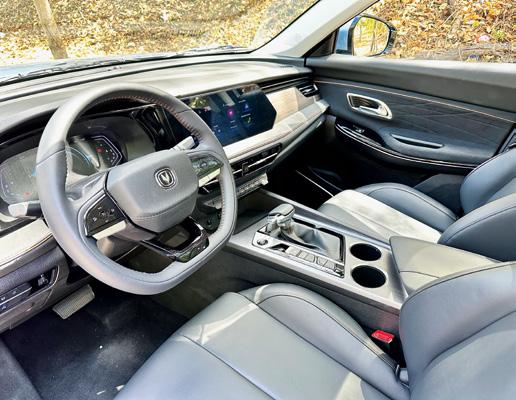

Words: Datu Kevin C. Limjoco
Photos: Isabel N. Delos Reyes
CHANGAN (which essentially means “Lasting Safety” in the Chinese language) may be the smallest of the very successful "Big Four" state-owned car manufacturers of China (SAIC Motor, FAW Group, Dongfeng Motor Corporation, and Changan Automobile), but it is technically the oldest having been founded in 1862.
This all-new mid-sized Changan X7 Plus 300T crossover is the first model of the brand that I have tested. The Changan brand
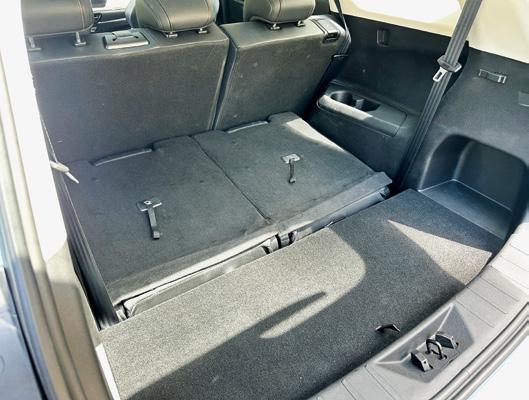

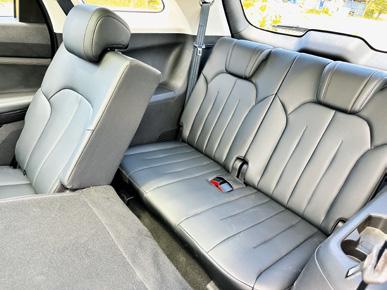
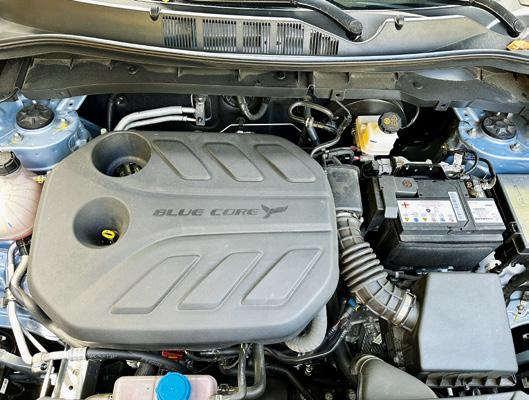
is managed and distributed by Inchcape Philippines (the joint venture between Inchcape and the CATS Group) for our market. Thus far, Changan is offered in 39 countries aside from China; found in Central and South America, the Middle East, Eastern Europe, Russia, the Caribbean, Asia and Africa.
Design-wise, the Changan X7 Plus 300T is good looking with a very nice front grille which so happens to be very peppy to drive. It displays a lot of promise in the sense that it is clear that significant cost-measures were applied to keep retail pricing very competitive in our market yet the materials and build quality that were used are very good. So, with more tweaking here and there, I am confident that Changan Philippines will be able to import significantly more desirable models with higher standard equipment and packaged with more features without raising the price too restrictively.
The Changan X7 Plus replaces the outgoing CS75 Plus. It is also offered in other markets

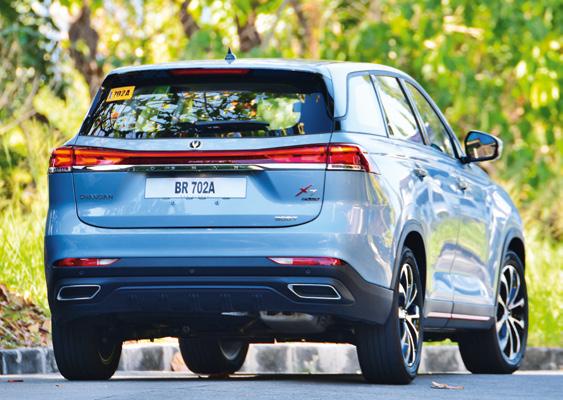
Plus Good looking, unique aesthetics, very eager engine, quite athletic, 360-degree cameras, panoramic roof, full signature LED-lighting, cruise control, multiple USB ports, 2nd row climate control, tasteful interior soft materials,
Rating 8.5/10
Minus No Telescopic Steering, No powered trunk. No Rear AC Vents in the 3rd Row, 7-inch instrument cluster limited GUI, ornamental faux dual exhaust, 4-speaker system severely lacks full audio range, no Apple CarPlay or Android Auto connectivity, and no wireless phonecharger.
under Changan’s sub-brand Oshan which is said to be positioned as “affordable luxury”. Compared to its other 7-seater crossover direct competition which are essentially also from China, its exterior looks and engine performance are the clear standout features. However, even with its promotional price that undercuts said competition, if you throw in the MPV-class vehicles that are also only front wheel driven but offer more comfort, space, and amenities, the Changan X7 Plus swiftly loses its sparkle. Compared to the Honda BR-V and Toyota Veloz/Avanza, which are dimensionally smaller but in real-world functions, all three carry similar capacities combined with more standard equipment, well-established branding and support, at more attainable pricing too.
The Changan X7 Plus 300T is a good and fairly spacious crossover with a very healthy powerplant and appealing good looks. It shows the direction where the brand is going in our market and it is competitive. As an early offering from Changan, I recognize the potential. It does have a solid bedrock to build up from with a good chassis, healthy drivetrain, and optimal brakes/suspension tuning. With more standard equipment and refinement while keeping its pricing attainable, I can certainly see the Changan X7 Plus being a contender in the segment.

Words and photos: Chris Van Hoven
ON THE OUTSIDE, the BYD Atto 3 is as inconspicuous as can be. No crazy large grille, no sharp angles, no slits for headlights. It’s almost as if it goes out of its way to avoid the futuristic trend we’re seeing on modern EVs. That could be a good thing, too, as the Atto 3’s symmetrical proportions retain a look that tends
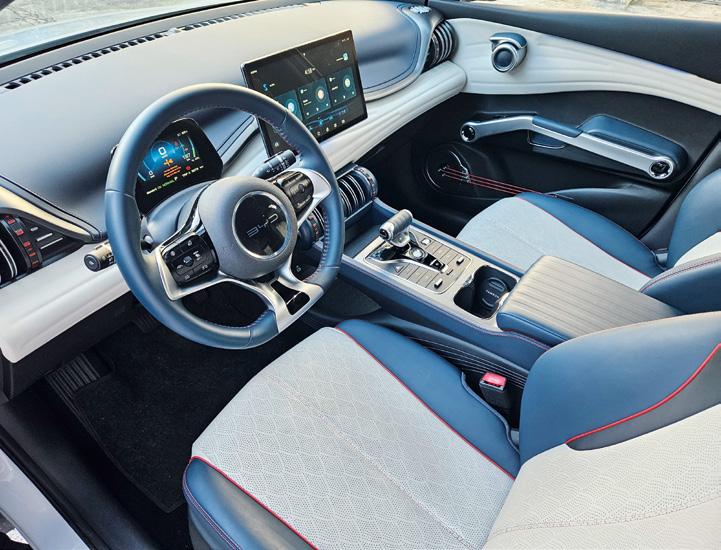


to stand the test of time better. But if you’re looking for a crossover that stands out among a sea of parked cars, this probably isn’t it.
All that changes when you step inside. The nautical design cues are an interesting choice for an interior, with bulbous accents throughout the dash that extend over to the door panels. Even the door handles, shifter, and rounded air vents look like they took inspiration from a boat’s throttle. All the materials feel great, and the build quality is impressive. Eyes are immediately drawn to the star of the show — a massive 12.8-inch touchscreen that rotates between portrait and landscape modes with the touch of a button. Apple CarPlay and Android Auto connectivity come baked in, outputting the sound through 8 speakers for




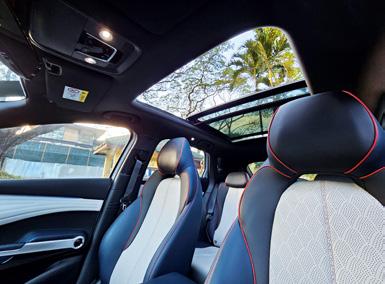


this Premium variant. The front seats offer fantastic bolster support, while the rear seats offer decent legroom. There’s a surprising amount of space for luggage as well.
The Atto 3’s linear power delivery is consistent, predictable, and reliable. No hunting for gears here because of its 1-speed transmission, making all that power and torque immediately available. Getting up to (and maintaining) 100 km/h is effortless, as is overtaking. Two levels of regenerative braking are also available: standard and high. High mode resembles engine braking on standard internal combustion engine cars and isn’t as intrusive as expected.
The BYD Atto 3 Premium’s 60.48 kWh battery supposedly gives us a range of 520 kilometers, though typical driving scenarios around the city bring that figure down to around 400 kilometers. When recharging at home, BYD includes a 7kW charger that takes around 10 hours for a full charge and an emergency 2.3kW charger that plugs into any 15 Amp socket.
The Atto 3’s suspension is fully independent and biased for comfort. The MacPherson struts up front and multi-link setup at the rear do a great job absorbing small to medium bumps quite well, making the Atto 3 an excellent choice for going around the city.
On the safety side, the Atto 3 boasts ventilated discs up front and solid disc brakes at the rear, giving it excellent stopping power. While six airbags, a 360-degree monitor, and an advanced driver assistance suite all contribute to its 5-star Euro NCAP score.
At a surprisingly reasonable PhP 1,798,000, the BYD Atto 3 leads the charge of the electric revolution and makes it more attainable to the everyday consumer. And that’s the best step in the right direction.
Plus Comfortable ride, affordable price, great acceleration, excellent build quality, good NVH levels, great safety features
Minus Bland exterior styling, interior design not for everyone, unathletic driving dynamics
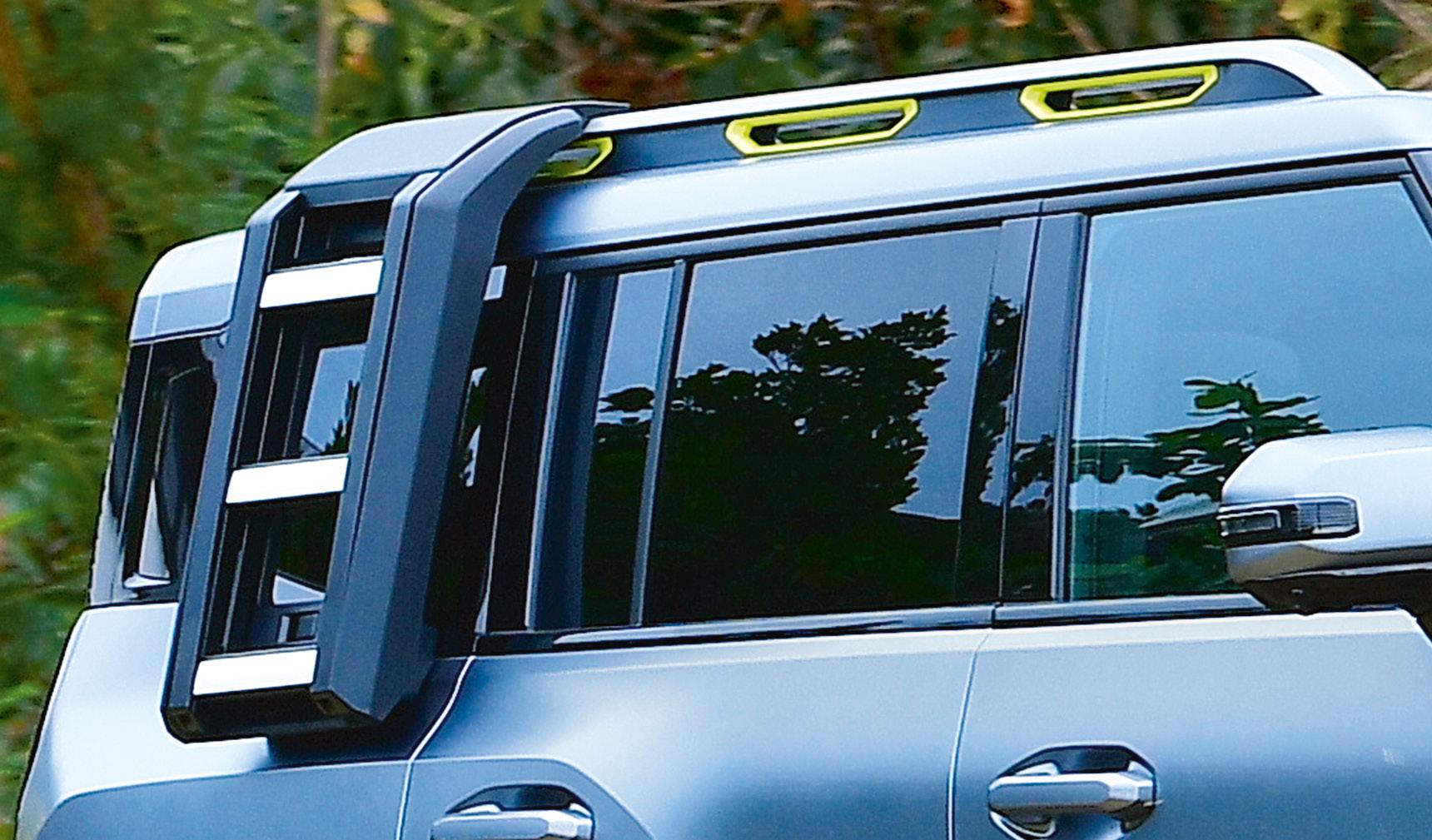


Photos by Author and Isabel N. Delos Reyes




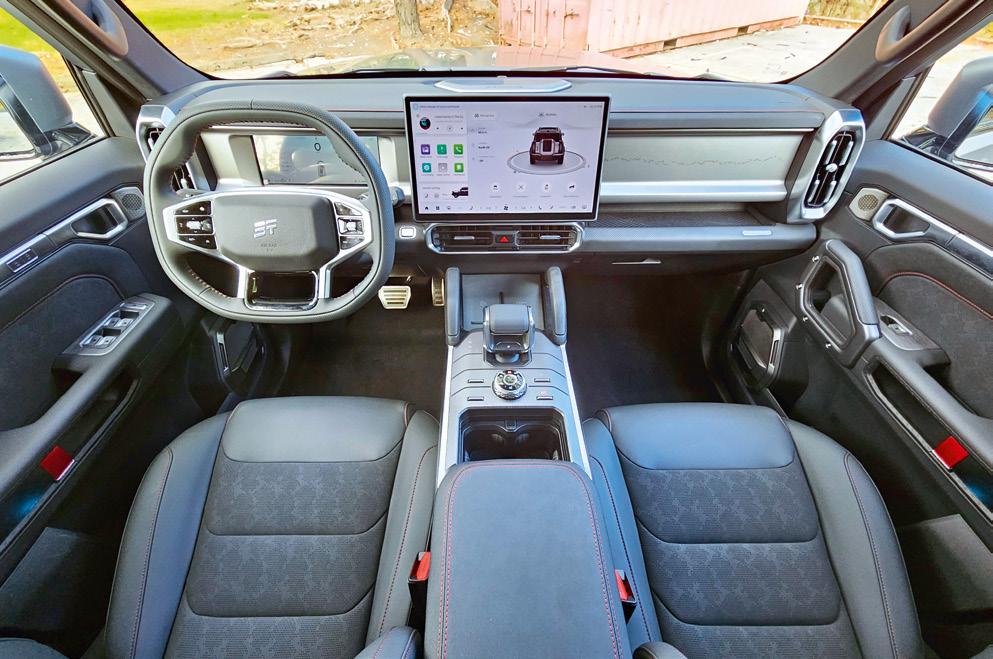

Just a year after its introduction to the Philippine market, JETOUR’s impact on the industry has been significant. The release of the JETOUR Dashing and X70 models has shown that they’re a standalone marque to be taken seriously. However, their latest release, the T2 SUV, elevates them to another level entirely.


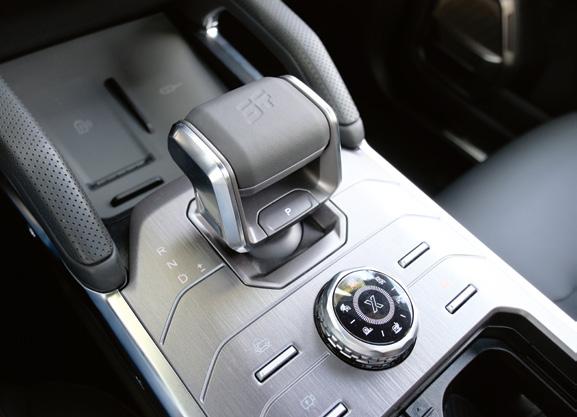
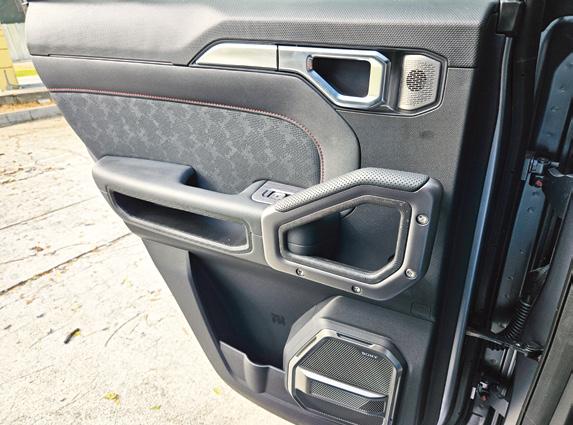

There's a lot of attention to detail in the T2's interior, showing that a lot of care went into its design and creation.
Known as the JETOUR Traveller in China, the JETOUR T2 (as it’s known outside its home market) is a fully-featured mid-sized SUV that boasts a combination of excellent packaging, a refined drive, and enough off-roading chops to warrant some serious attention. It was designed under the guidance of Porsche's top designer, Hakan Saracoglu, who helped pen the exteriors for models such as the Porsche 918, Spyder, Boxter, and Cayman. The JETOUR T2’s exterior adopts the iconic, ruggedly boxy shape of classic off-road SUVs, complete with the spare tire at the rear. Wide wheel arches, a fixed stepboard, and large 20-inch tires add to its rugged appeal, but it’s the other design details – an approach angle of 28 degrees, ramp of 18.6 degrees, 30-degree departure angle, and a functioning roof rack that can carry up to 300 kilos of gear – that lend more credence to it being a legitimate overland machine. The side compartment and ladder are optional accessories, though they come as standard as a part of the Terrain package that adds an extra PhP 100,000 on top of the T2’s PhP 2,498,000 price tag. I personally love the matte Stone Gray color shown here, and the yellow accents found on the wheels, bumper, and roof rack are a fun way to break the monotony.
All lighting fixtures, from headlights, daytime running lights, and front fog lights to the tail lights at the rear are all LED, providing excellent illumination at night.
The JETOUR T2’s interior is tasteful and cohesive. Unlike the space-age influence of the youth-oriented Dashing, the T2’s cabin is much more straightforward, with no overdone designs. The seats boast a combination of suede and leather, and while some might argue that this combination of materials might be more challenging to clean, they absolutely add to the T2’s upscale interior feel. Both driver and passenger seats are ventilated, incredibly supportive, and comfortable, with the driver seat featuring 6-way power adjustments and 4-way power adjustments for the passenger. The seats at the rear can be folded perfectly flat, turning an already generous luggage compartment into an absolutely cavernous one. A 64-inch panoramic sunroof opens the T2 up to a wide open greenhouse, allowing you to enjoy the views of the outdoors.
One similarity the JETOUR T2 shares with its Dashing sibling: they’re both filled to the brim with tech. The T2’s central dash is dominated by a massive 15.6-inch touchscreen beside a large 10.25-inch full-LCD instrument cluster. USB ports abound – 4 in the front row alone, which includes a 60-watt USB-C outlet. At the rear, you’ll find two more ports – one standard USB-A and another 60watt USB-C, giving you more than enough options to charge all your devices, from phones to laptops. And if that wasn’t enough, wireless charging is available as well. There are other nice details to take note of as well – the refrigerating center console to keep your drinks cool, cupholders that pop out the rear tailgate (perfect for holding Bluetooth speakers when camping), the flat-bottom and flat-top steering wheel, a variety of hooks and attachment points for gear, and a map-like detail above the glovebox. Infotainment duties are handled by
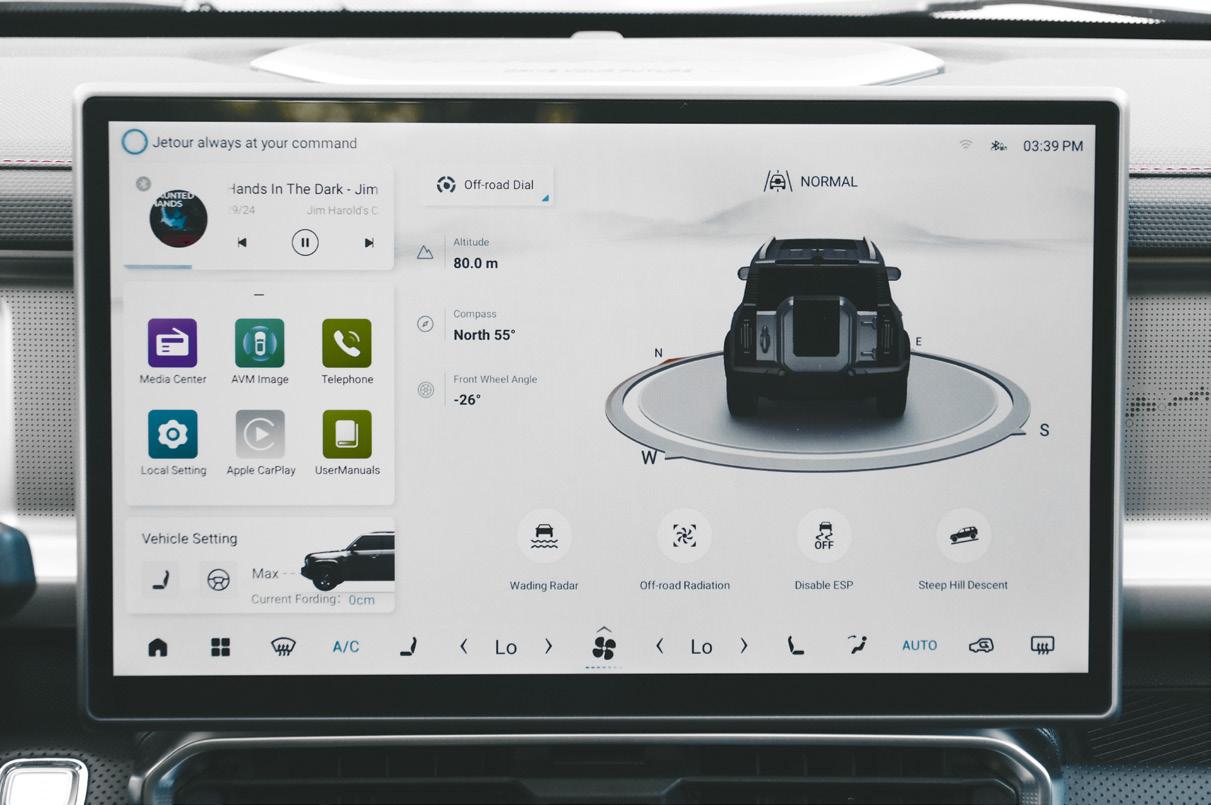
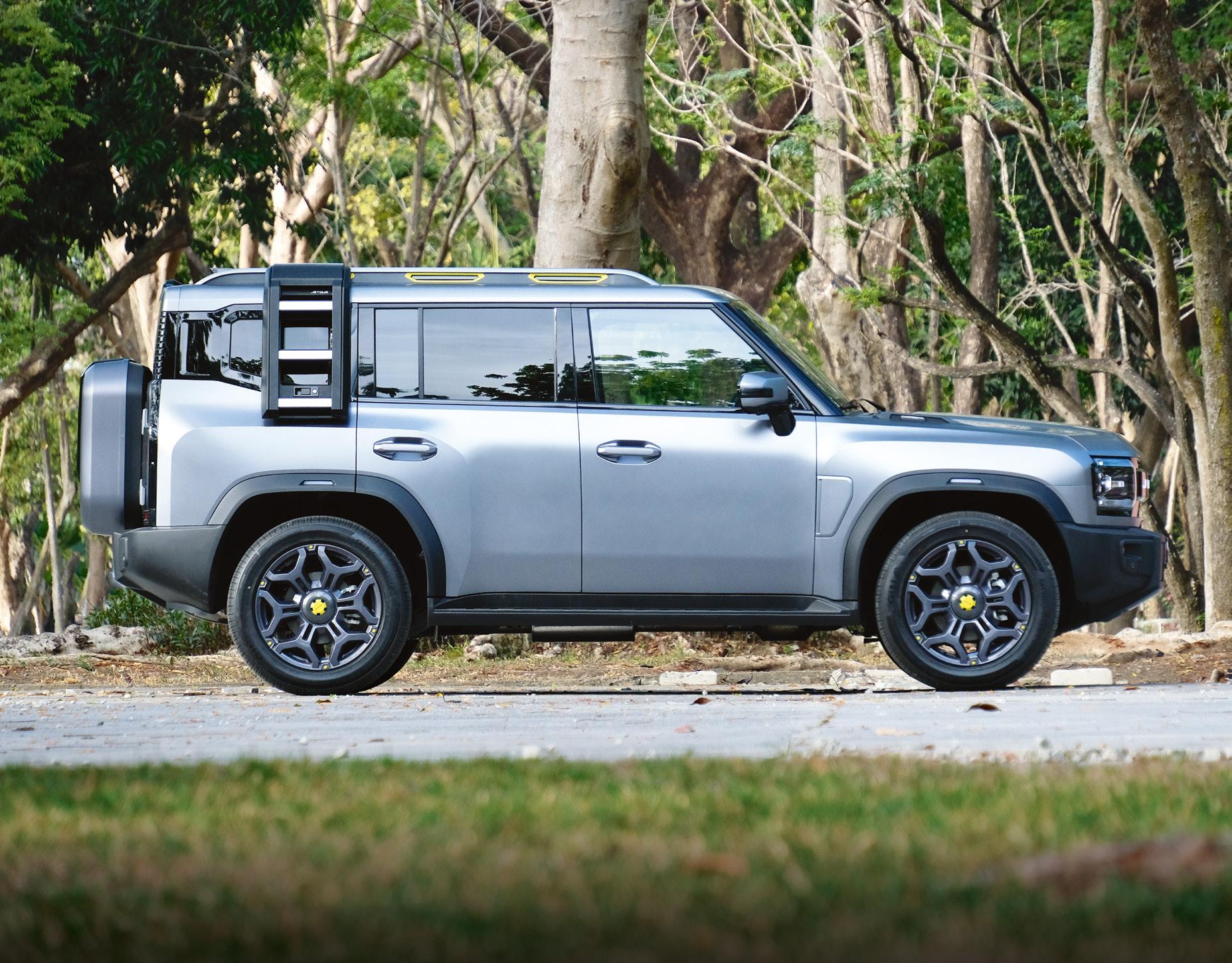
12 (!) Sony speakers, including a subwoofer, with Apple CarPlay connectivity. Despite the lack of Android Auto, you can’t deny how impressive this package is. JETOUR has done an excellent job with the T2’s cabin, and it feels decidedly more premium than the asking price tag dictates.

The JETOUR T2’s driving characteristics are equally impressive. Power is delivered by a turbocharged 2.0-liter 4-cylinder engine mated to a 7-speed wet-type dual-clutch transmission producing 253 hp and 287 lb-ft of torque. Suspension is fully independent, with MacPherson struts up front and a multi-link setup at the rear. The result is incredibly linear and predictable power delivery and an extremely supple ride with excellent noise, vibration, and harshness suppression. The T2 makes short work of quick acceleration jobs, efficiently supplying power during overtaking. Road irregularities and medium bumps are easily suppressed, making the T2 one of the most comfortable SUVs I’ve tested in a while. Finding a balance between comfort and crashy is



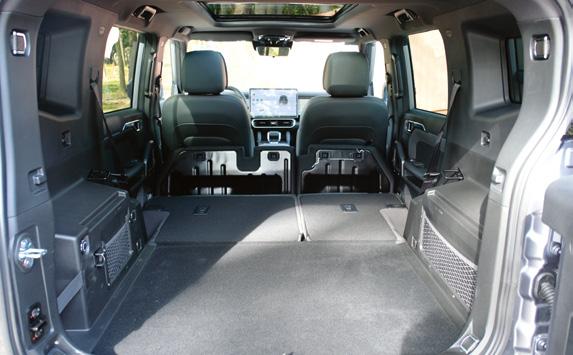

always tricky, and the T2 straddles this line perfectly. When venturing off the beaten path, the T2 offers seven driving modes that automatically handle its 4-wheel drive system — sports, standard, eco, grass, mud, rocky, and X-Mode (or XWD), which automatically assesses road conditions and adjusts the torque split accordingly. The T2’s wading depth is rated at 700mm, with a helpful wading sensor that lets you know how deep the current water levels are and alerts you when it’s not wise to proceed further. JETOUR pays attention to detail by placing the air filter higher to avoid water intake when traversing floods. While the T2 doesn’t have a locking differential — which automatically makes it a mild off-roader — it has enough off-roading capability for nearly any day- to-day scenario except for the most demanding off-road courses. It’s interesting to note that while the T2 uses a transverse-oriented engine, JETOUR states that the T2 features a rear-wheel bias, with the 2-wheel drive variant found in other markets primarily rear-wheel drive. We couldn’t test this during our initial diving impressions, but we’ll


be sure to investigate this in the future. Fuel mileage with our limited testing resulted in an impressive 10 km/L overall, on an average speed of 22 km/h.
JETOUR also takes safety seriously with the T2, with a complete advanced driver assistance system on top of a long list of standard safety features.
Braking is responsive, with ventilated disk brakes up front and solid disc brakes at the rear. Other features include driver and passenger front and side airbags, adaptive cruise control, traffic jam assistance, blind spot detection, lane keep assist and departure warnings, forward and rear collision warning, and advanced emergency braking.
Exceptionally packaged, with outstanding driving characteristics and a comprehensive and complete safety suite, the JETOUR T2 stands as one of the most impressive cars we’ve tested from a Chinese manufacturer, easily able to go toe-to-toe with other mid-sized SUVs, providing incredible value to rival more premium ones as well. If this is an indication of JETOUR’s offerings moving forward, then we’ll be expecting great things, indeed.
Engine: Inline-4
Location: Front, Transverse
Displacement: 1998 cc
Cylinder block: Cast Aluminum
Cylinder head: Cast Aluminum, DOHC, 4 valves per cylinder
Fuel Injection: Direct Injection, Intercooled Turbo
Max power: 253 bhp @ 5500 rpm
Max torque: 287 lb-ft @ 1750-4000 rpm
Transmission: 7-speed Dual Clutch, Four-WheelDrive, Intelligent AWD
Front suspension: Independent MacPherson Strut with Gas-Pressurized dampers and anti-roll bar
Rear suspension: Independent Multi-link, coil springs with Gas-Pressurized dampers and anti-roll bar.
Fuel Capacity: 70 liters (18.5 gallons)
Wading Depth: 700 mm
Approach Angle: 28 degrees
Departure Angle: 30 degrees
Ground Clearance: 220 mm
L x W x H: 4785 mm x 2006 mm x 1880 mm
Wheelbase: 2800 mm
Brakes: Front 12.4-inch (316 mm) ventilated discs with dual-piston calipers / Rear 12.3-inch (314 mm) solid discs with single-piston calipers; Integrated Electric Parking Brake, ABS, EBD, EBA, TCS, ESC, AEB, HHC, HDC
Wheels: 20”x 9J Multi-spoke Aluminum Alloys
Tires: 255/55R20 110W Giti Control P10
Weight (kerb): 1880 kg. (4145 lbs.)
0-100 km/h (0-62 mph): 8.7 seconds
Top Speed (mph): 180 km/h (112 mph) Governed
Fuel Mileage: 9.5 km/L Overall
Price as tested: PhP 2,598,000.00 (with Terrain package included)
C! RATING: 9.5/10
PLUS: 12-speaker Sony sound system, comfortable ride, overlanding potential, packed with features, complete ADAS suite, upscale cabin feel.
MINUS: Wish it had a proper locking diff for true offroading, no Android Auto, slightly pricey for a 5-seater SUV.
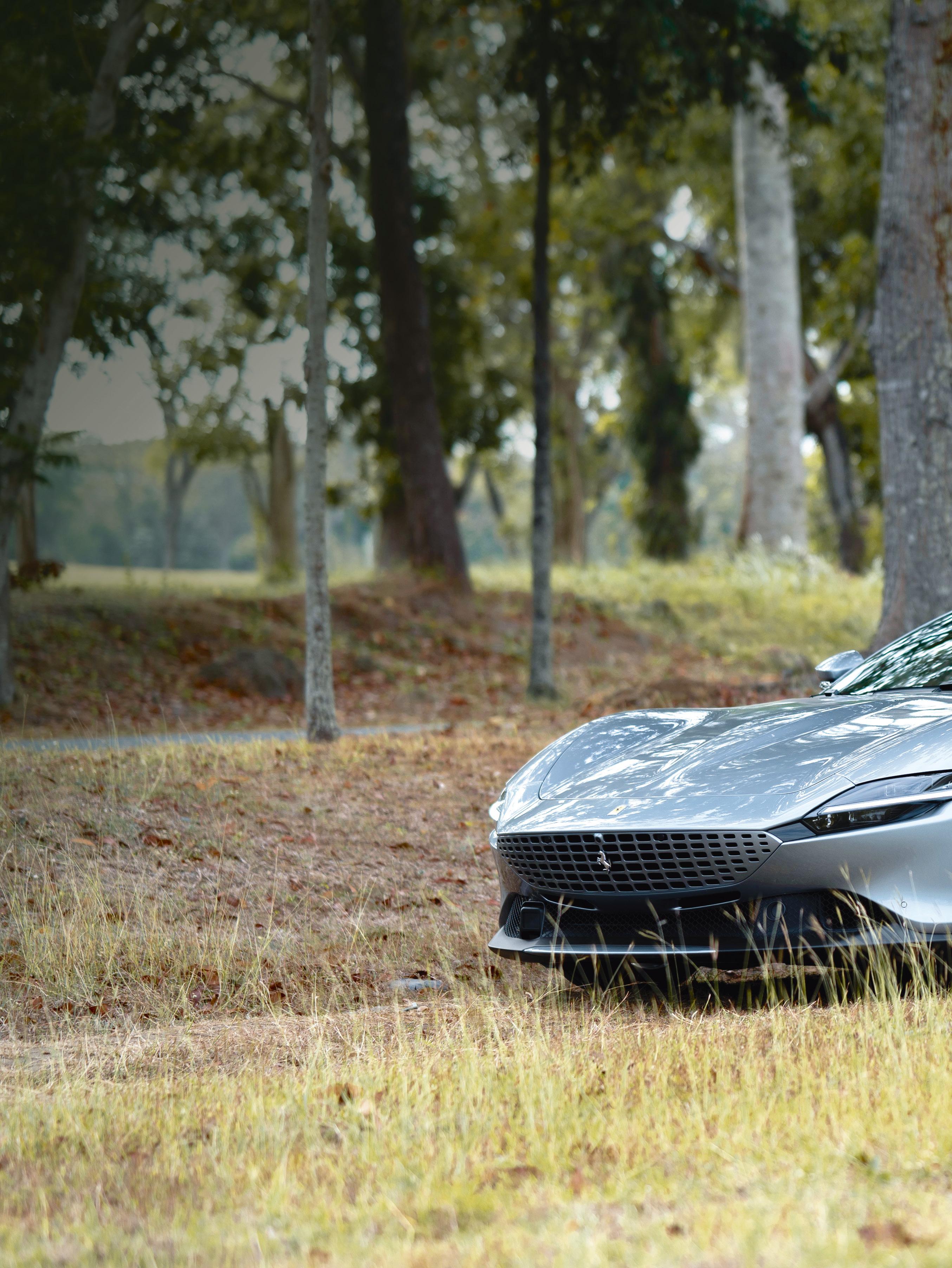
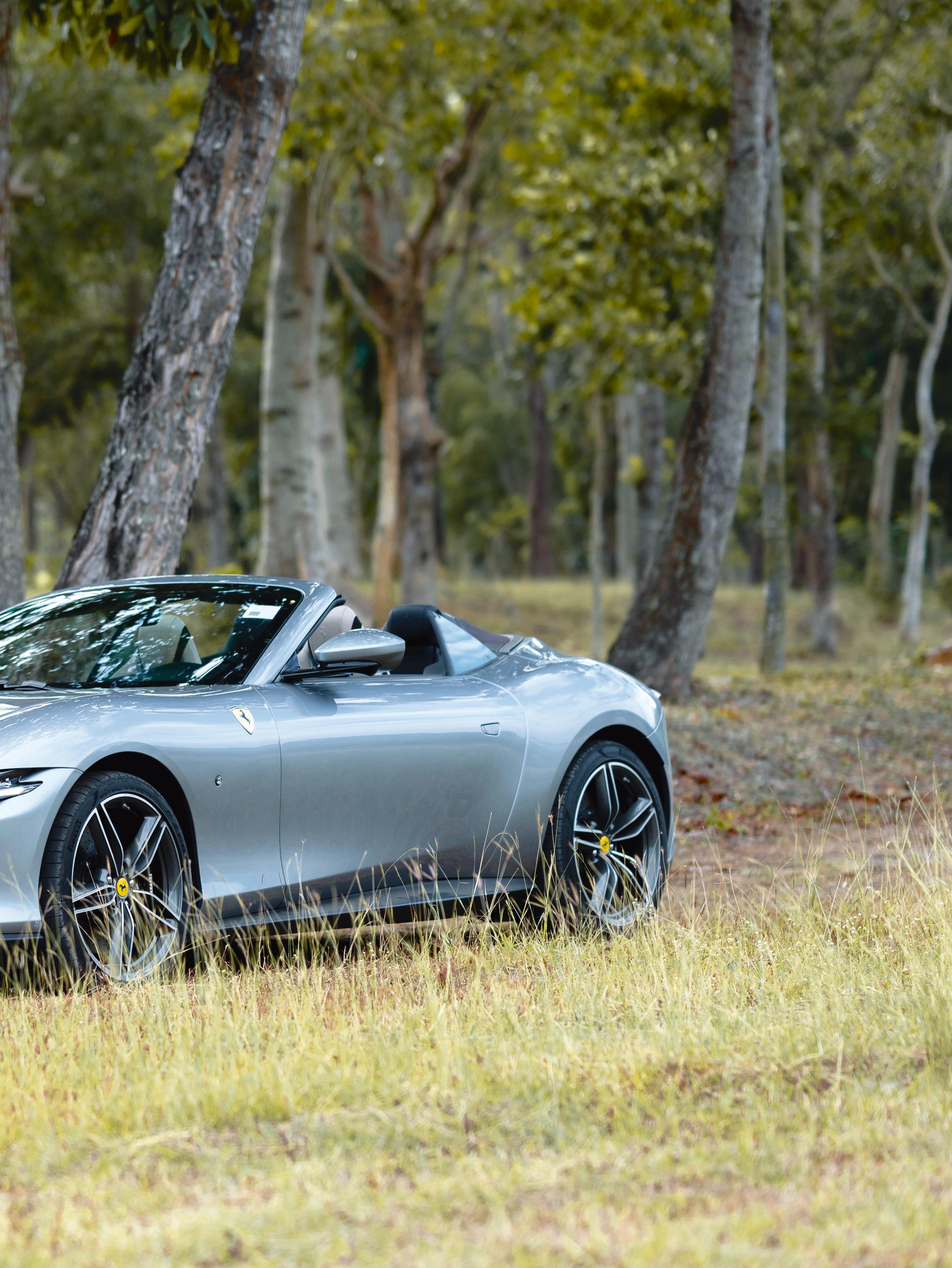
FEW BRANDS IN THE AUTOMOTIVE WORLD TRIGGER
MORE RAW EMOTIONS LIKE THE NAME “FERRARI”
INVOKING DAYDREAMS OF SCENIC DRIVES ON THE WINDING ROADS OF THE ROUTE NAPOLÉON WOVEN
ONTO THE MOUNTAINS IN THE SOUTH OF FRANCE.
Or in its homeland, tracing the Amalfi Coast in Campania with a view of the calm, crystal blue waters of the Gulf of Salerno.
Enveloped by the sultry shapes that are unmistakably Italian, accompanied by the emotionalistic aural experience of their high-strung engines reverberating off the mountain face – the daydreams themselves are enough to stimulate irrational thoughts on how you’d afford one. Might I suggest an “Italian Job” as a possible solution?
Invited by Velocita Motors, Ferrari’s local distributor under SMC Motors, we made our way to the Sta. Elena Golf & Country
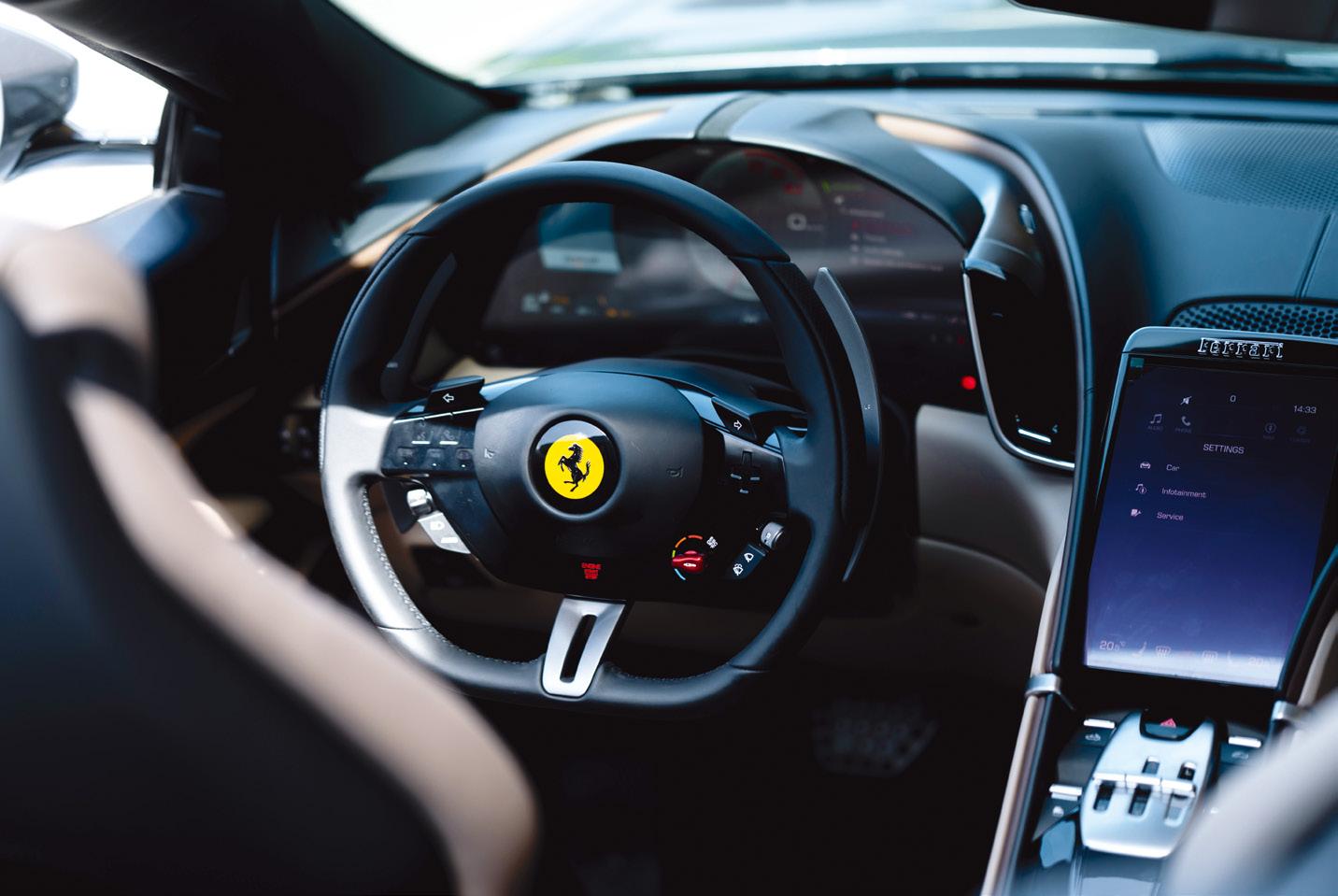





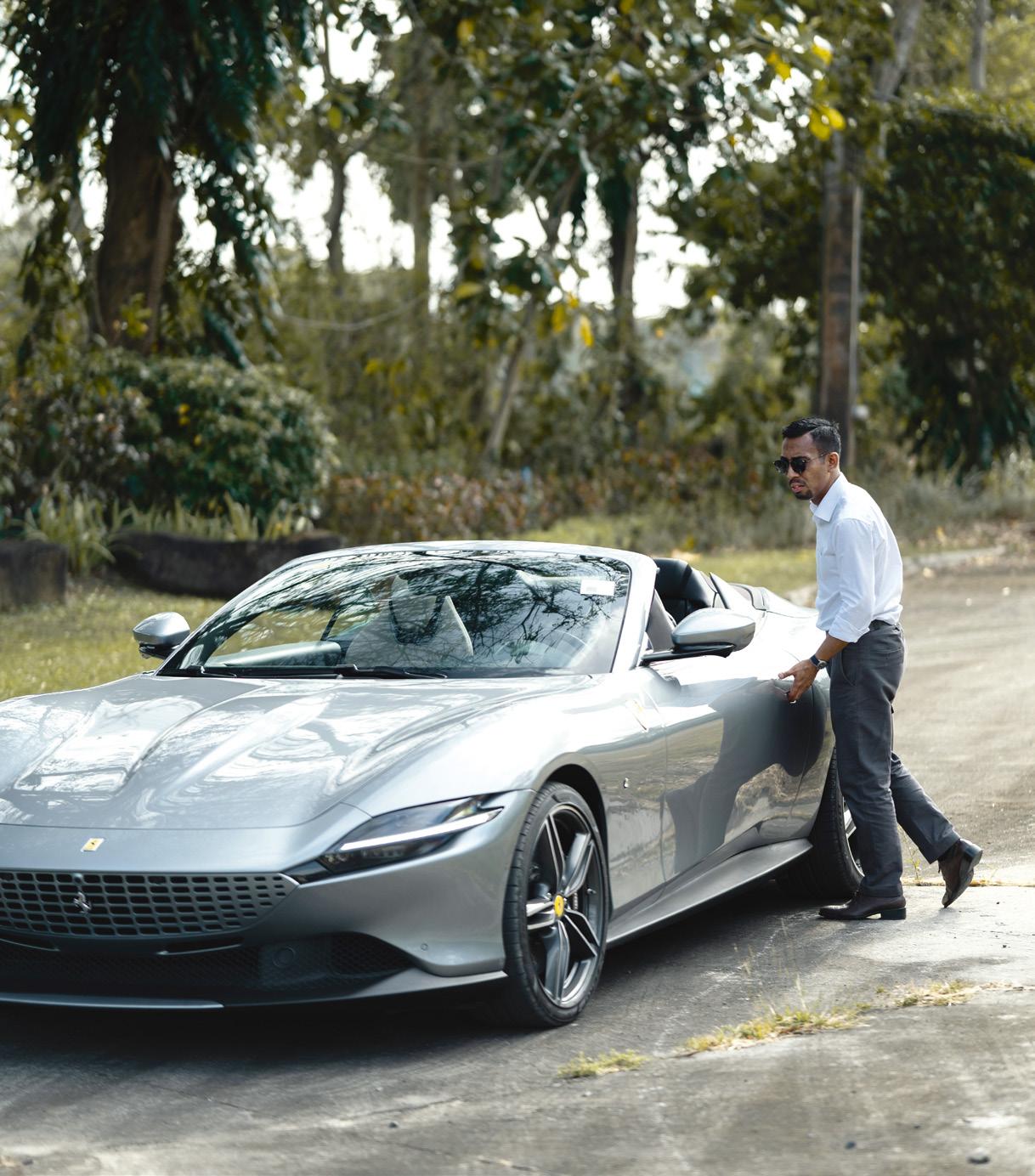
Club as the sun rose, unaware of the experience they had waiting for us. Somewhere along the pass-the-message chain, the translation was misconstrued. So I was under the impression that the event was a press launch for the newest exotic by Maranello’s finest. Man, oh man, was I very mistaken, but thankfully so.
Upon our arrival at the Lakehall of the Sta. Elena Country Club, the stunningly beautiful Ferrari Roma Spider sitting at the events place driveway greeted us. The Roma Spider’s sultry supermodel figure, finished in Grigio Titanio and paired with a black five-layer soft-top, exudes confidence and elegance reminiscent of the 365 GTS/4 “Daytona” from 1969. Its sharp nose, defined chin, and alluring eyes flow beautifully to its front fenders and lead into a steeply raked windshield. Its sides are neatly sculpted, free of the need for any large openings typical of mid-engined sportscars. And the hips on this Italian are as natural and shapely as any that one could assimilate it to. All in all, the styling of the Roma Spider is distinctly feminine, just as earlier Ferraris were. It’s a pleasant departure from the aggressive shapes of its mid-engine stablemates, which is aimed towards a different driving experience. Albeit no less aerodynamic and purpose-driven than its smaller siblings, the Roma Spider is decidedly more opulent and sophisticated, which fits its Grand Touring design brief. The location of the event was nowhere near the villas on the Amalfi Coast, but no doubt, it complimented the Roma’s breathtaking presence.
While the likes of the Ferrari 488 GTB/Pista are more performance-focused, and the 812 Superfast is maniacally just that, Ferrari takes a different approach with the Roma, and now, the Roma Spider as it takes the place of the Ferrari Portofino. With 612 horsepower and 531 foot-pounds on tap from the 3.9-liter twin-turbocharged V8, the Roma Spider is still blisteringly quick, shifting through eight paddle-shifted gears and sending all its power to the rear. But as a Grand Tourer, the Roma is less frantic, producing its power with more linearity and civility than the previous modern front-engined Ferraris. The bi-turbo V8 is still responsive and meaty but is more manageable even as
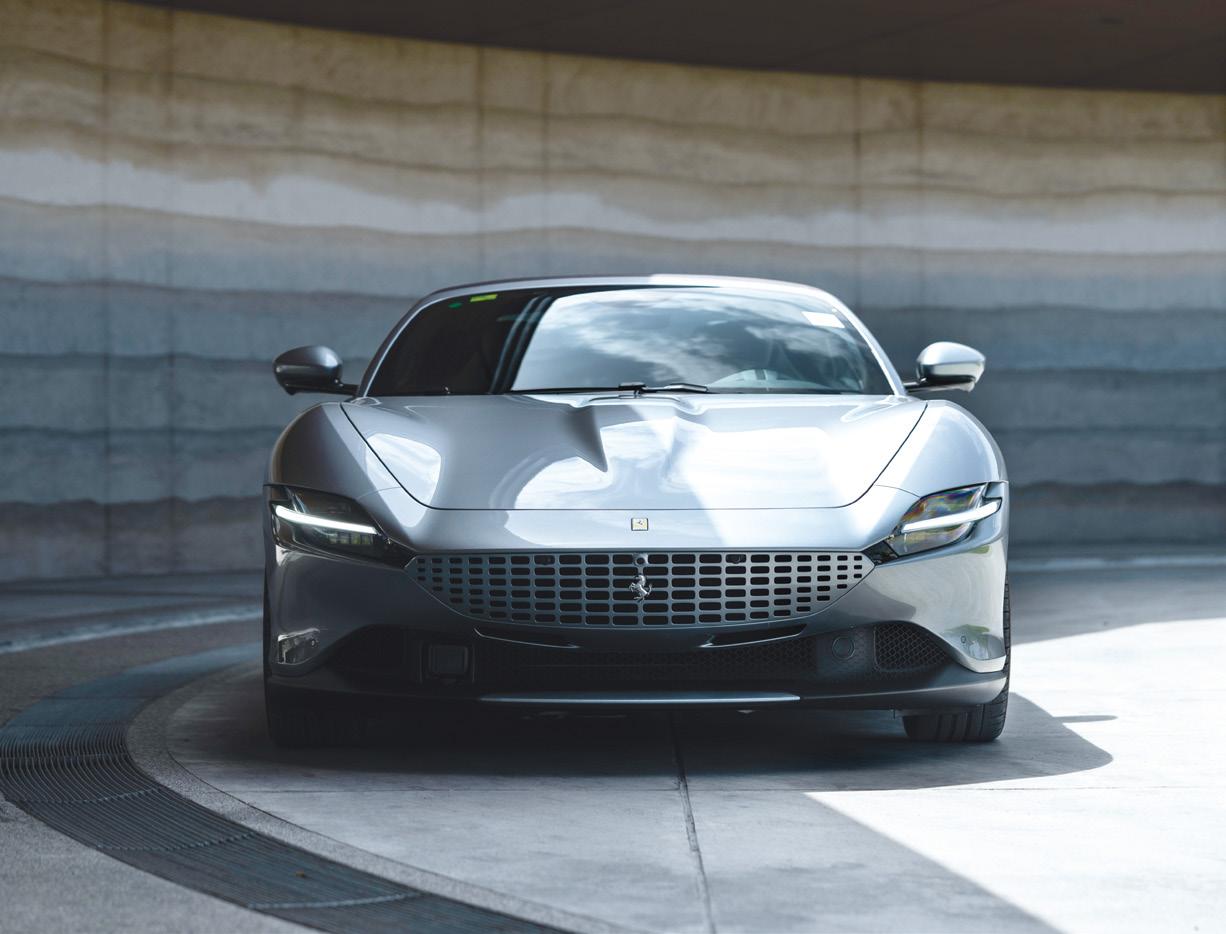
“Drizzled with touches of brushed aluminum bright work, save for the “Roma Spider” badge on the passenger side dash – a touch of extraordinary attention to detail…”
it makes do with a 7,5000 rpm redline instead of the magical eight of naturally aspirated prancing horses.
Settling into the newest Ferrari’s interior was straightforward and unintimidating. The specified interior of Velocita’s press unit was beautifully inviting, clothed in tan Italian leather edged by perfect stitching and intermixed with a luxurious hue of black. Drizzled with touches of brushed aluminum bright work, save for the “Roma Spider” badge on the passenger side dash – a touch of extraordinary attention to detail that calls back to its styling roots during the automaker’s younger days. The interior design is less busy yet doesn’t feel lacking, even when considering the features and tech. Touchscreen infotainment, easy phone connectivity, cameras, and parking sensors are all there, and they are presented much cleaner and more intuitively.
I’ve always acknowledged the allure and appeal of a Ferrari that captivates onlookers, but I have to admit, I never lusted after one. I’ve always leaned backward toward cars with history and pedigree in one way or another. I’d take a 1966 275 GTS over the Enzo any day and for any occasion, for example, even if it’s undoubtedly more challenging to drive. But in many ways, it feels like the Roma is a focused return to Ferrari’s golden era, not only in design but also in performance and driving characteristics. It’s more usable and practical, and I can’t help but recall the
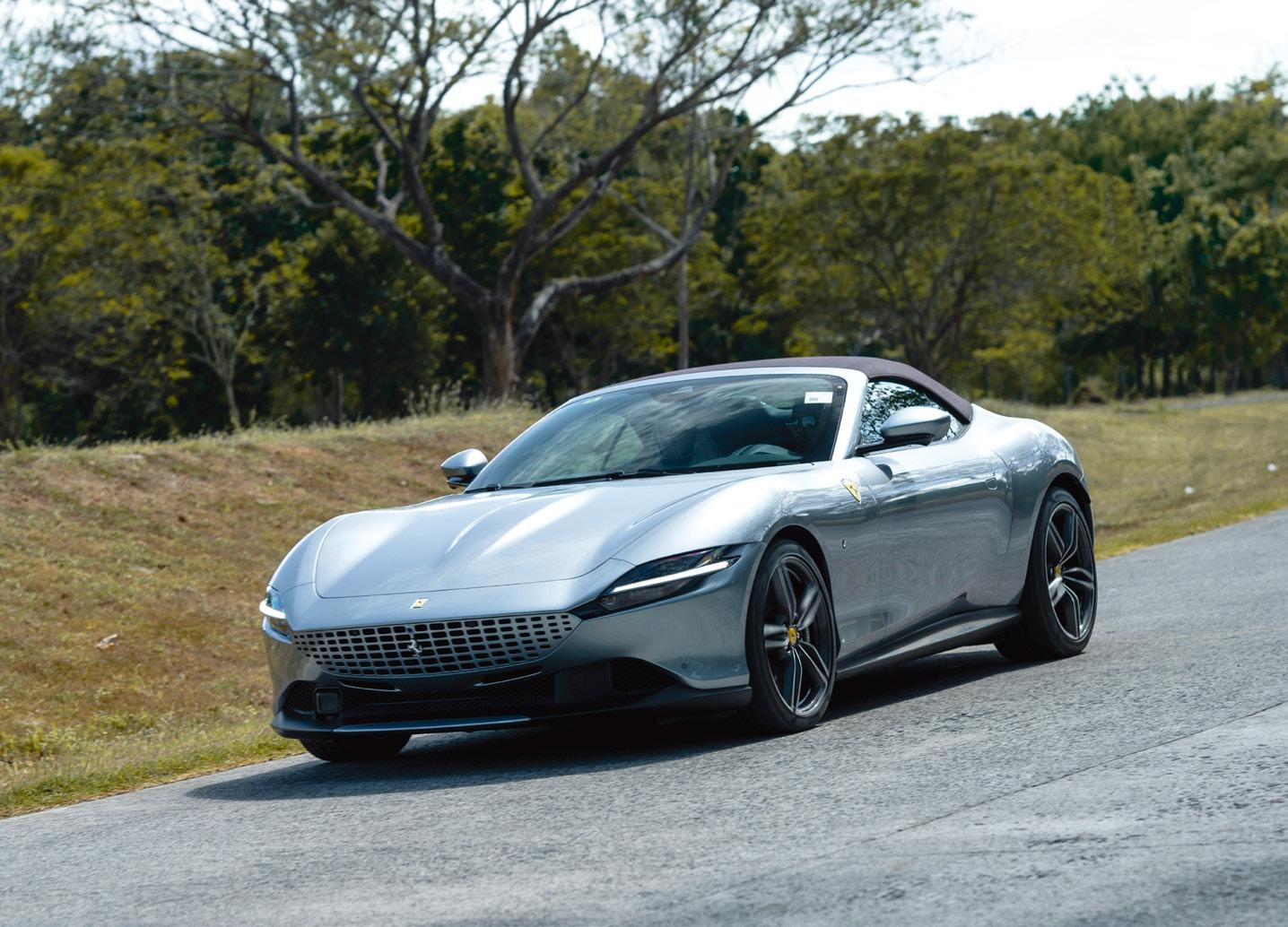

stories I’ve read in the past about how Ferraris were used back in the day. The days when gentlemen drivers would drive to the races in their 250 GT SWB Berlinetta Lusso and then take their wife out to a fancy restaurant for dinner in the same elegant shape, powered by the same sonorous engine that very same evening. Car guys would get it, owning something so versatile and capable, wrapped in a shape so captivating, you just can’t imagine driving anything else. Plainly, there’s just so much romance in that imagery.
At the end of our short time together, we painfully returned the keys to that gobsmackingly beautiful Ferrari Roma Spider. And as we piled on the distance between me and that stunning Italian, I found myself feeling hollow, like a sense of absence had just come over me. And that’s when it struck. It felt like a whirlwind summer romance often portrayed in Hollywood films – finding an unexpected connection and yearning, only to be cut short by circumstance. Those body lines, its character, that inviting personality once you get past the astonishing exterior looks. Then it drops its top quicker than you can clear a sector of the Fiorano circuit – whew! Snapping out of the daydream once we hit the expressway, I realize: performance figures, stereotypes, and money be damned, I’ve been unexpectedly seduced by a beautiful topless romantic from Italy.
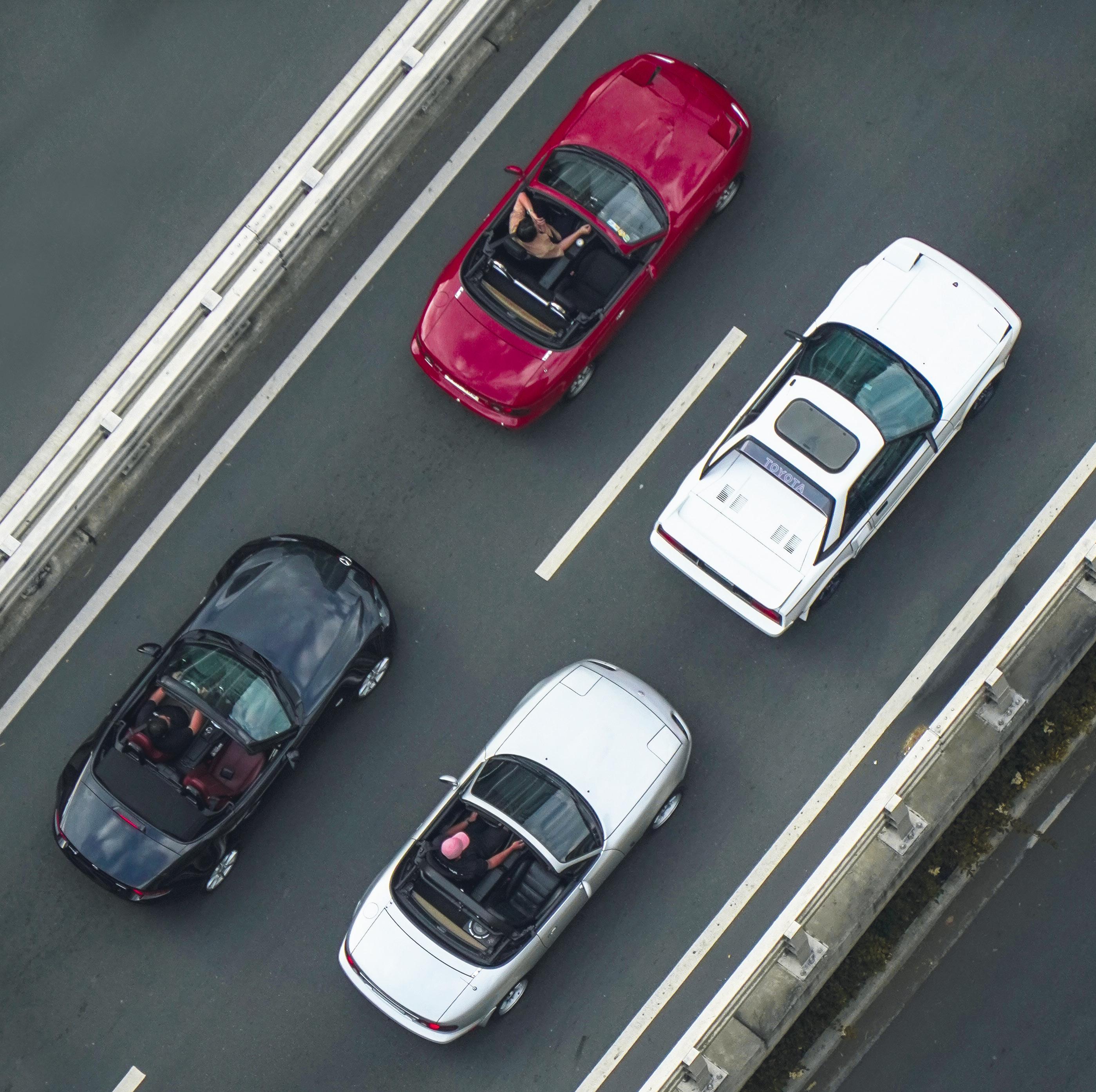

Words:
Photos:
Carl Murphy and Richard Tan
Practicality has always had a strained relationship with fun and engaging — at least in the automotive industry. Rarely do you come across a new car that perfectly blends the two opposing ideas. That’s why, on the rare occasion that an automaker builds and sells a car that comes close, it’s almost guaranteed to be an instant classic. That, or it’s another half-baked marketing strategy that tends to be one more failed attempt with far too many shortcomings on either end of the two spectrums.
The same can be said about the ideas of new versus old. Again, at least in the automotive enthusiast world, it does. And I get it completely: old cars tend to perform unpredictably. Flawless the day before, and the following morning, it wouldn’t care less if it functioned as a 2,500-kilo paperweight. But those old cars had character, a certain charm about how they went about doing the very same things we rely on new cars to do for us.
New cars, on the other hand, are dependable. They’ll start every time you twist the key or maybe push the button and rarely skip a beat when you ask something of it that’s out of the ordinary. But the majority of new cars are characterless. They lack the soul that comes with older cars and feel numb to drive. But if we could only let go of our apprehensions and ego, maybe, and not care what other people think, I believe the answer to the perfect fusion has already been designed, built, and gone out of production. While only one other alternative remains in production today.
Jarro Cabańes and Mick Santi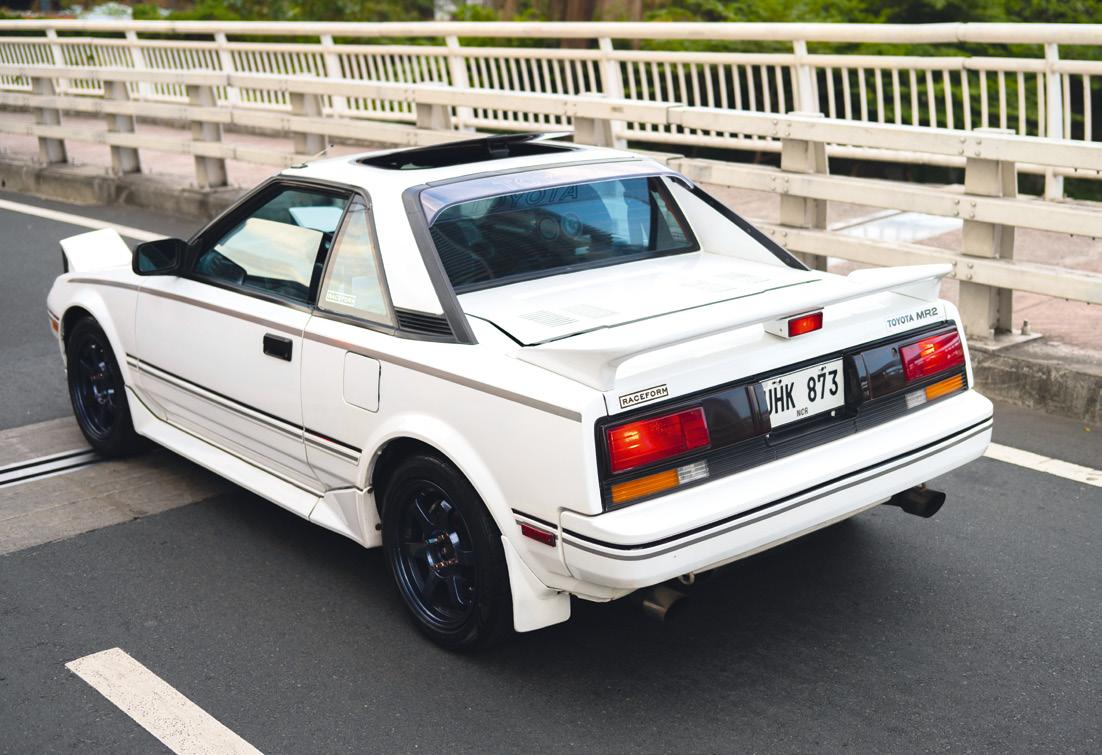
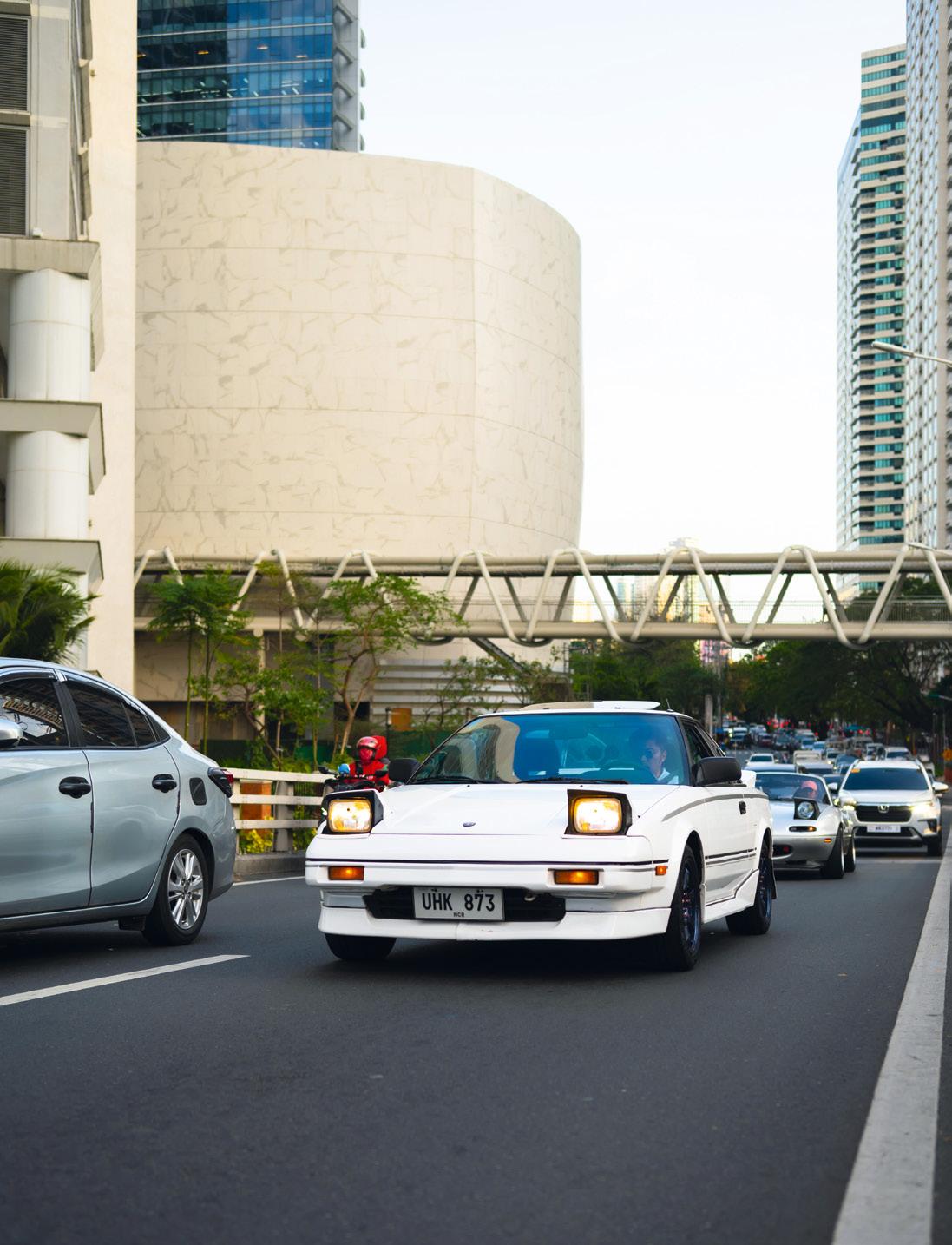
“Now, I’d be foolish to suggest that the Mk1 MR2 is and was the perfect compromise or even the perfect sports car. The Mazda Miata exists after all…”

Starting life in 1984, the Toyota MR2 was the Japanese automaker’s proof-of-concept that practical and fun could work. You could say it was the 80s version of their “waku doki” saying. The chassis was an all-new design that had balance and lightness in mind, which, of course, equates to fun. With a mid-engine layout, the handling was neutral and had good turn-in due to most of its weight being centrally located instead of over its front axle. Don’t push too hard around corners, though. This generation of Mister Two’s was notorious for swapping ends when driven too eagerly.
Powered by the same small and rev-happy 1.6-liter 16-valve engine found in the now legendary Corolla AE86, the engine itself didn’t weigh a lot either, much like the entire car that weighed in at a hair over a ton. With that 4A-GE engine making right around 125 bhp in naturally aspirated form, the MR2 wasn’t spectacularly quick, but it was quick enough. The mid-engine layout and independent suspension with disc brakes all around made it clear that handling took precedence over power, which was the original formula for a sports car, anyway. And after all, don’t they say “driving a slow car fast is more fun than driving a fast car slow”?
Another advantage of the MK1 MR2’s 4A-GE engine and low curb weight is running costs. Running and maintaining
“...the 1.6-liter inlinefour would still be more fuel efficient when compared to luxury sedans, both new and old…”
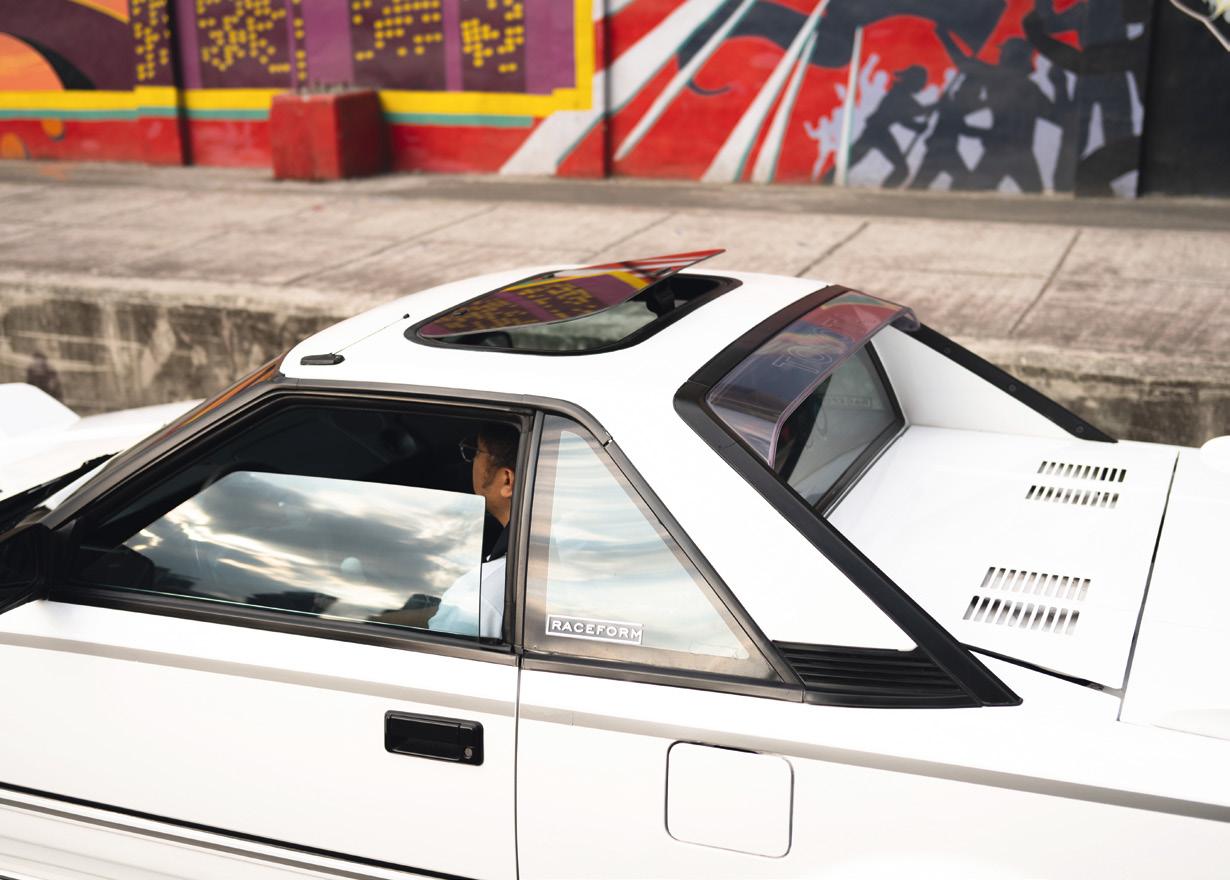
the car shouldn't cost too much if it’s properly taken care of. Even if you’re a lead-foot Larry, known locally as a member of the “bigat paa gang”, the 1.6-liter inline-four would still be more fuel efficient when compared to luxury sedans, both new and old. And, of course, its lightness translates to ease on suspension, brakes, and other underchassis consumables. Being a Toyota, it shares a lot of components with the ever immortal Corolla, which means parts are cheap and abundant. It may only have two seats, but it has a trunk front and rear! How many people are usually with you anyway in your giant SUV to and from work?
The MR2 isn’t by any means perfect. It has its fair share of issues, as with any other old car, regardless of make, like the prone-to-leaks T-top and moonroof-equipped versions. It’s endless panel gaps, corners, and angles that trap water and dirt, if seals are dried to a crisp from baking under the Philippine sun for years. It’s also plagued by rust issues. But I feel the benefits far outweigh the consequences, which is a rarity.
In this imperfect world we live in, with equally imperfect compromises, we seldom come across something that is just that. Perfect. Now, I’d be foolish to suggest that the Mk1 MR2 is and was the perfect compromise or even the perfect sports car. The Mazda Miata exists, after all, firing a similar arrow at the same target from a different bow. Opinions are split between love and hate regarding the angular shape and ruler-straight lines of the MR2. Others adore the seemingly origami-inspired styling that obviously date-stamps it to the Eighties, while others could swear they’d regurgitate whatever they had for lunch at the sight of it. I should warn you, though, that I may be a little biased here. Since I was a kid, I’ve been known as the child that time forgot. I’ve always liked things from before my own time: watches, movies, and yes, cars of course. But that’s because, to a certain degree, I believe things were simpler and clearercut back then.
Just as the Mk1 MR2 is. A small and fun sports car that, through good design and engineering, manages to be practical, fuel-efficient, bulletproof, reliable, and packaged in a shape that doesn’t present itself as anything other than what it is. Again, I admit I may be slightly biased, as this car is right up my alley. But even then, I don’t think the Mk1 Toyota MR2 is the perfect compromise or even the perfect sports car. But I believe it gets pretty damn close.



“...the newest old car you can buy while simultaneously being the inverse; the oldest modern one; the other a 21st century take on a recipe that can never go wrong…”
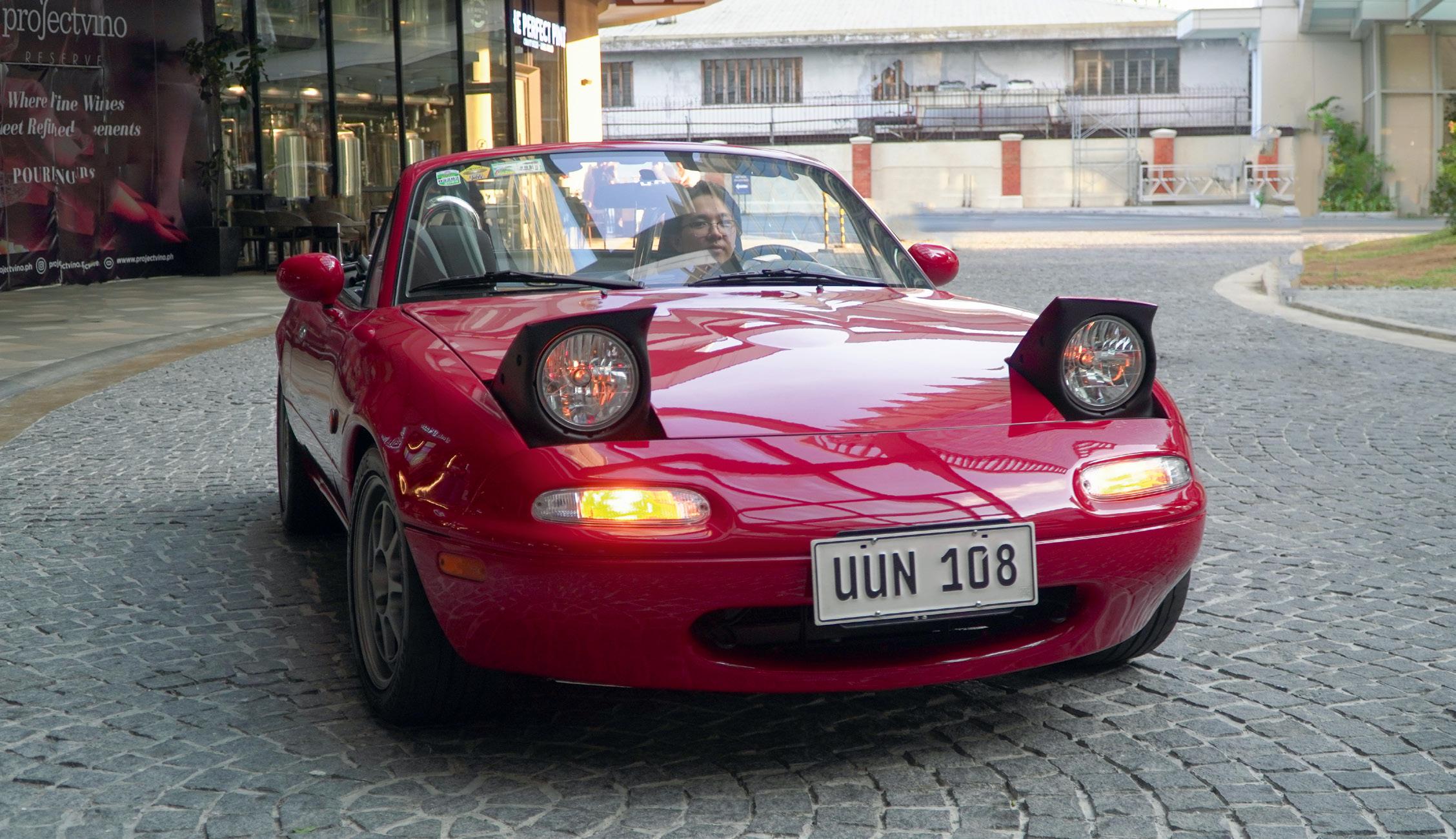
Being a college kid in the late 90’s, I was, like any other pimple-ridden school boy, a devoted follower of the temple of VTEC. But I had a secret. Behind all that fanboyism for variable valve timing was a guy happy to trade his sedan for a sports car. I was a closet Miata fan. A few cars and a couple of decades down the road, I came to appreciate that the MX-5 is perhaps one of the most irreplaceable sports cars money can buy. One can fancy an Italian that churns out operas for its exhaust note, and for that, there are many choices. Or perhaps a highpowered grocery-getter from Germany? Again, there’s more than one obvious answer. But if it’s topless fun you want, the kind that doesn’t overheat, leak oil, self-immolate, or get you into credit card debt, is there really an alternative?
I got my first Miata as a stand-in for when my other cars were waiting for parts from overseas. For about a decade, I was smitten by a pair of strong-armed sports cars from Stuttgart. They were a dream to drive, but that dream came with a price. It was almost a requirement to have in the garage, something Japanese, in case the twins woke up on the wrong side of the bed. Perhaps that’s just how it is with cars whose engines are on the wrong end. Wonderful as they were, I made a conscious decision to trim down my collection to something that actually tells a little bit of a story. My first-generation Miata wasn’t getting any younger, despite
my upkeep. In fact, she’s old enough to sell explicit content on a certain website you shouldn’t visit on company time — if Miatas are your thing, that is. Old enough to be scouring the netherworld of the web to find parts to keep it going.
I’ve always had a soft spot for classics. Adobo that’s been brining in the fridge for a few days, the original 911, especially one with no junk in it, the first edition Rolex Explorer with its famous 3-6-9 dial, and yes, the MR2 on the opposite page. It’s interesting how at first glance, the two are very different cars. And maybe they are. But dig deeper, and you’ll find they’re of the same intention, perhaps separated only by execution. Tempted to look at the classifieds, but I really needed something that could serve as my daily. When I learned that the new Miata could fit in its trunk my little boy’s school bag, those bulky ones with an integrated stroller, I knew it was time to head to the dealership.
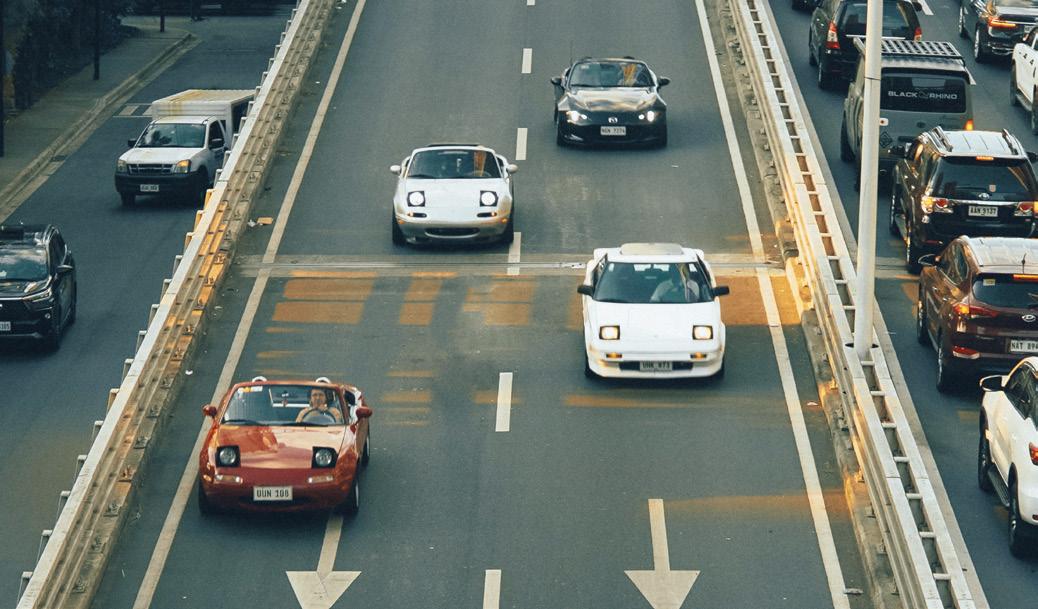
“...the two are very different cars. And maybe they are. But dig deeper, and you’ll find they’re of the same intention, perhaps separated only by execution.”
Fast-forward to ownership, I learned that what you’re paying for isn’t the many bells and whistles, not its direct injection Skyactiv engine, the well-appointed interior, or its four-star Euro NCAP safety rating. It’s the fact that this 1,000 kg design exercise has been built from the ground up to make you giggle at speeds as low as 60 km/h, and that’s just not something car manufacturers do these days. There are plenty of cars in the market that make more than 181 horses, but dare I say none that let you feel each and every pony on the way to fetch the kids from school. If that’s not enough reason to join in the fun, there’s a bunch of car guys who, in between attending beauty pageants and parading its participants with their tops dropped around the metro, talk about how their Miata is better than everyone else’s, including perhaps the one you’ll soon buy.
Driving the NA and ND back to back, the two become counterarguments to one another, allowing you to view each machine in the context of its time. One is the newest old car that you can buy while simultaneously being the inverse: the oldest modern one; the other, a 21st-century take on a recipe that can never go wrong. Familiar, but fresh. My youngest MX-5 isn’t going anywhere, and I believe I’ll be holding on to her for some time. What would I replace it with anyway? But I hear through the grapevine that a new special edition is coming out. While every so often I think about my time with the Sauerbratens, I’m now perfectly happy with a couple of hotdogs on a stick, simple treats that work every time and put a smile on your face for not a lot of money. When the meat is this good, you won’t need any bread. And sometimes, not even ketchup.

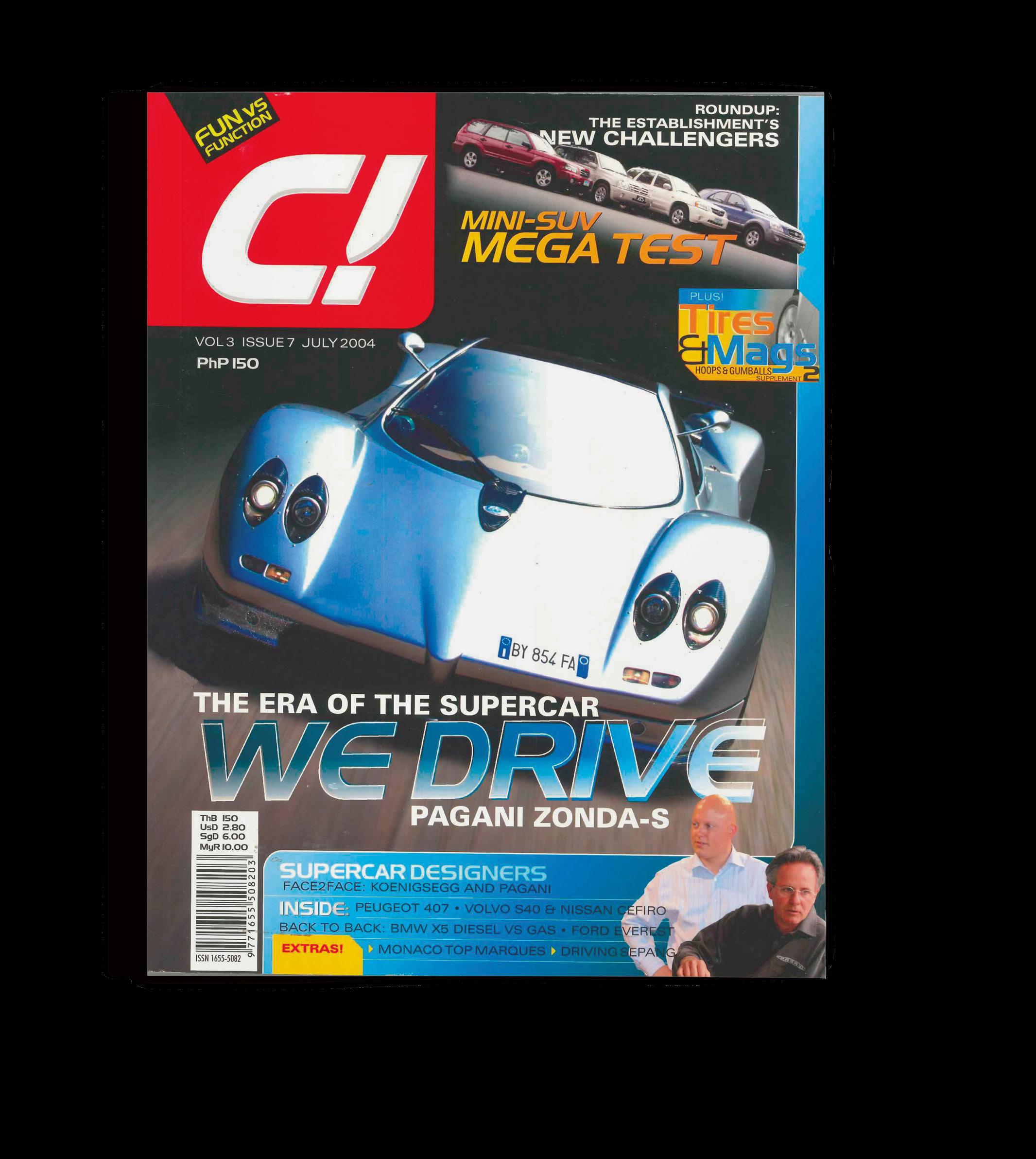
Before the internet became a thing, printed publications were one of the few ways to consume content about almost anything. And it was always a waiting game to see what the magazines you subscribed to were going to show and write about the following month.
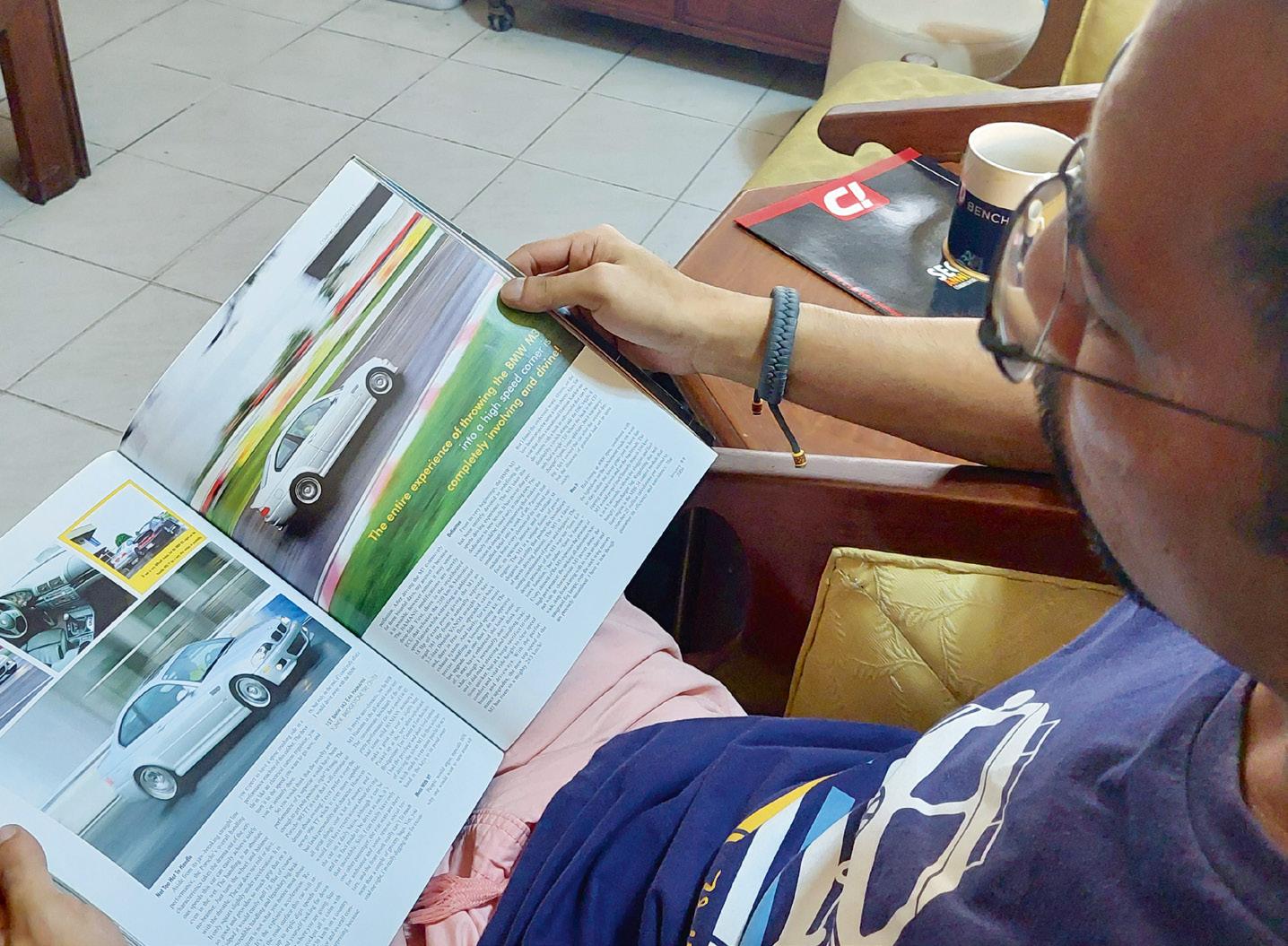
Nowadays, the only wait anyone needs patience for is dependent on how fast telcos can transmit internet data from their cell sites to the gadget in your hand. And we all know that doesn’t take anywhere near a month, even if it sometimes feels that way.
Growing up around cars with a dad who was a grease monkey and whose friends were equally car and motorsports crazy, it was inevitable that I’d turn out the same. So when I discovered C! on the magazine stands of National Bookstore amidst iconic international brands like Road & Track, Car and Driver, and EVO Magazine UK, you can imagine a teenager’s mind-blown excitement coming across a local publication with similar photo composition and writing quality as the magazines from abroad. You can say it was love at first sight, leafing through and reading about the cars that could be spotted on


our streets and were locally available, events that I, as a teenager, could watch and attend. I can recall several track shootouts of tuned and modified cars gracing the glossy pages behind a spectacularly photographed cover photo. It was enough to get a young, impressionable mind to become a fan of the magazine for life.
Exposed to a wide variety of race and rally cars from a young age, it was the performance cars that C! Magazine featured that linger in my brain to this day. One of those articles involved a photo that was seared into my mind from the first time I saw it on the magazine shelves — a rear tracking shot of a white GC8 Subaru Impreza WRX and the thennew “Bugeye” Impreza WRX in WRC blue, driving side-by-side in close proximity. These images are what stuck with me as a fan of the magazine from its earliest days.
Several years later, I was able to experience the behind-the-scenes of an actual track feature in Carmona Racing Circuit between the Emperor Motorsports Evo Club and the MR2 Club of the Philippines. I watched as the late, great Kookie Ramirez jumped in and out of each car, taking them
out on track, extracting the least amount of time possible to all be reported in the next issue. I still consider that day to be a core memory from my younger days. Sadly, I could no longer find my copy of that particular edition of C! Magazine.
But one that I did find a copy of contains a photo that I recall just as clearly. An assortment of Lancer Evos a Westfield kit-car, which was sold locally for a time, rounded off by a manual E46 M3 and Porsche 993 Turbo. Fanned out across the entry of Carmona Racing Circuit’s sweeping first corner, the image

 Photo credits to @aircooledph for the postcard photos
Photo credits to @aircooledph for the postcard photos
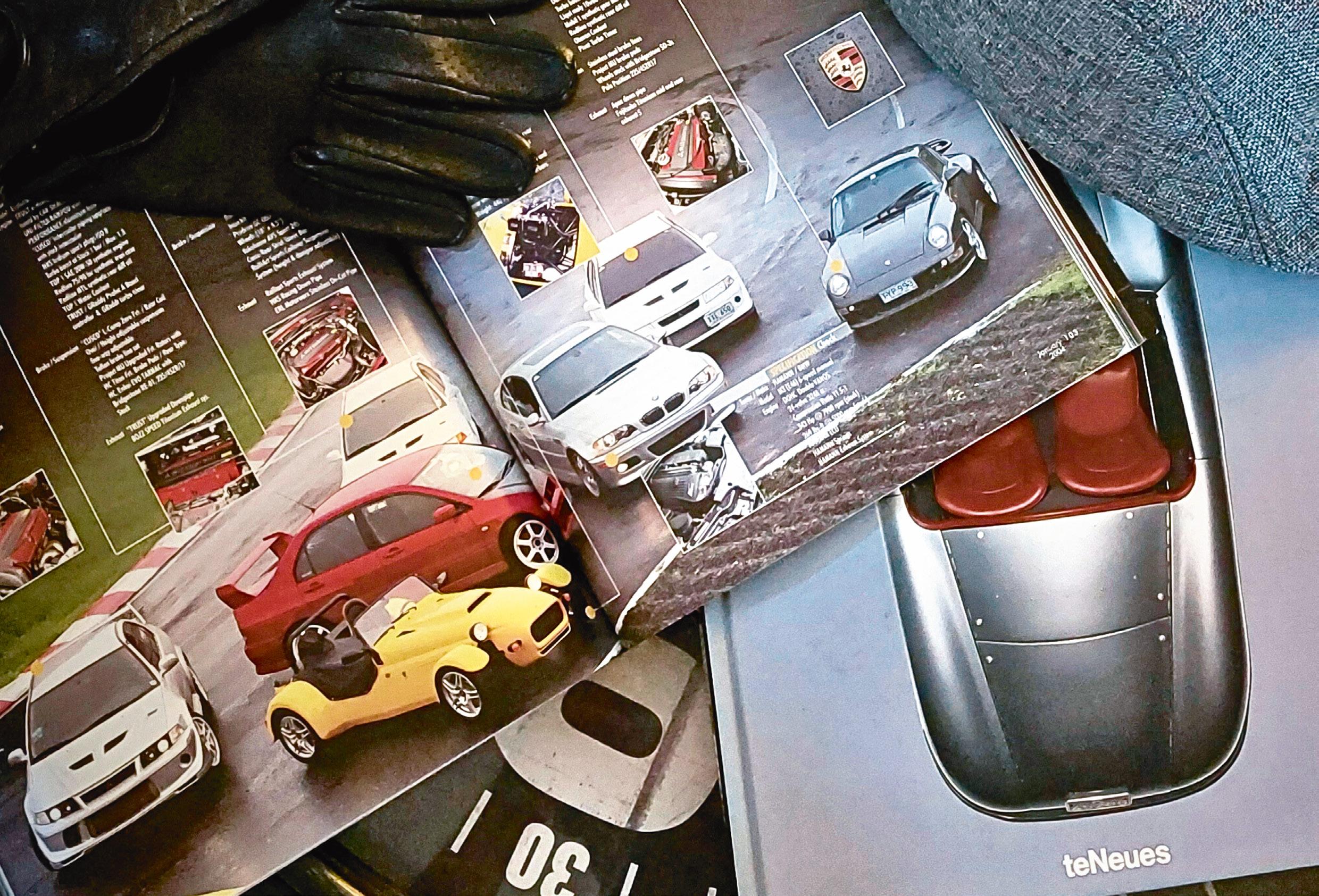

of that spread spurred a lot of daydreaming in the classroom while our algebra teacher defined what “x” was and its corresponding formula. Thus, my mathematical ineptitude.
C! in my mind, has always been the enthusiasts’ magazine, and what I believe is one of the most credible local motoring publications in the country.
Fast-forward to today, I find it scarcely believable that I’ve ended up on the opposite side of the very pages that I used to read end-to-end when I was younger. Having been in and around cars in varied capacities all my life, and yet it still feels surreal.
Even as I sit here writing this, I can barely believe that I am now part of the C! Publishing Team. To be completely honest, I feel out of my depth in many

“This is proof that you should never discount your passion.”
situations but cars, experiences, and adventures in cars… I love it all too much to ignore the possibility when it came across my plate. So I’m definitely in for the ride.
To quote my supportive mom’s post on social media when she shared the Facebook upload of C! Magazine about my first published work with the brand, I have been a follower of C! since I was in high school. But let’s not get into how many decades ago it has been. Just take my word for it when I say it's been a long, long time.
“Jarro has been a fan of this magazine as a little boy. He wouldn’t mind when I took a long time in National Bookstore because it just meant more time by the magazine stand browsing through this very magazine. So to be on the other side of the pages of C! Magazine, with perhaps another little boy, somewhere out there, browsing and reading his article is truly a proud, full circle moment.
This is proof that you should never discount your passion.”
- Stephanie Cabañes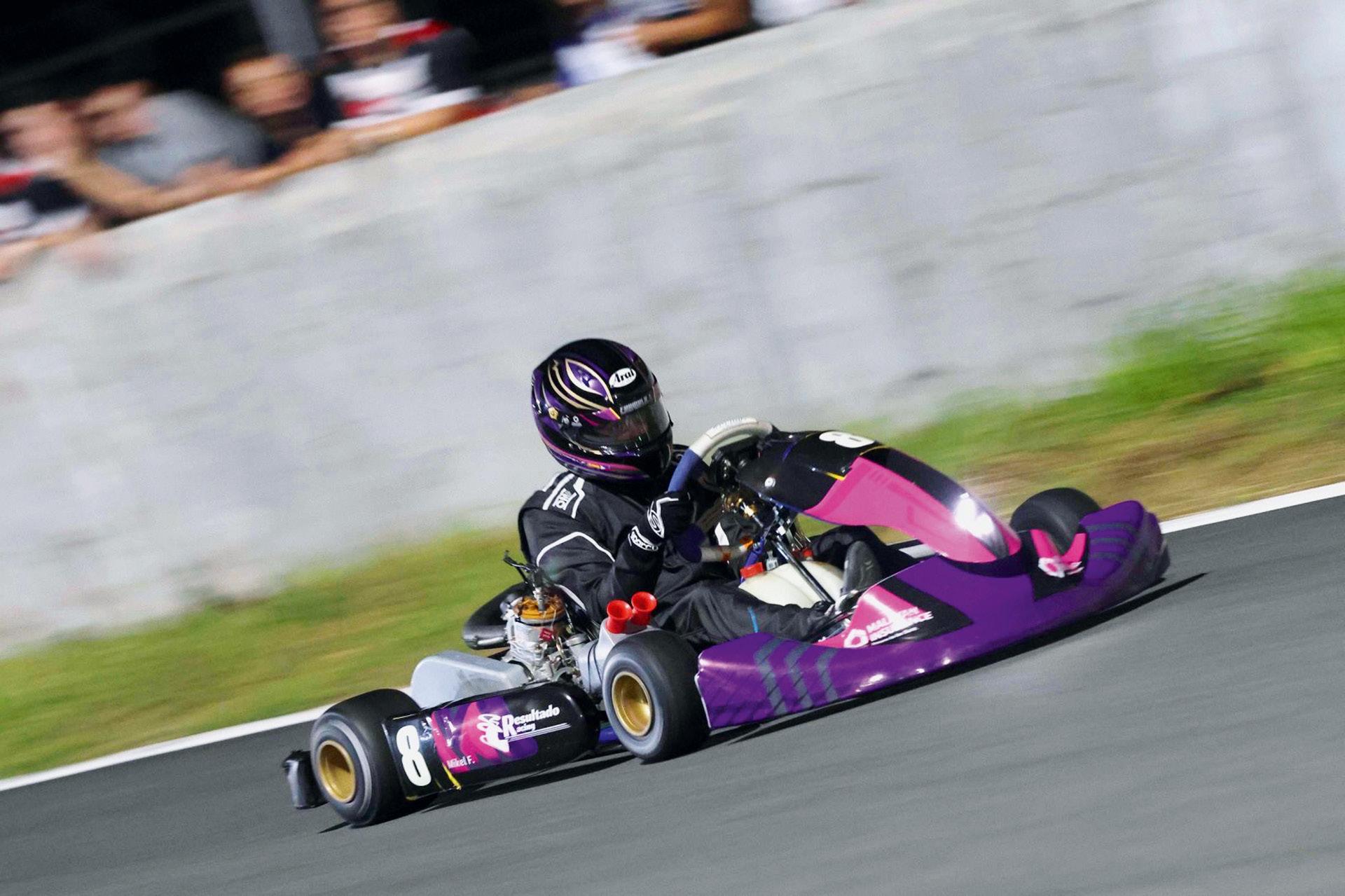
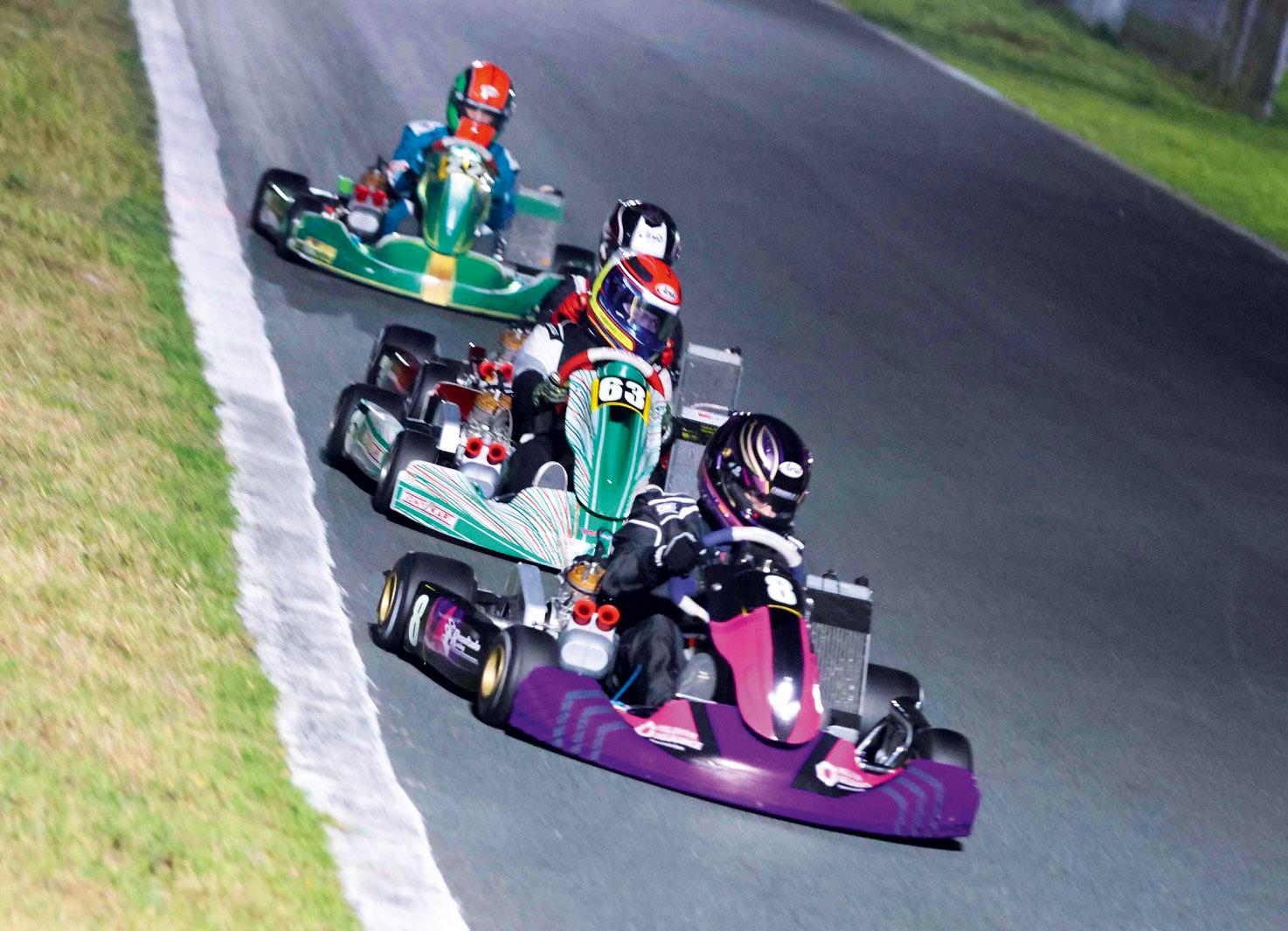
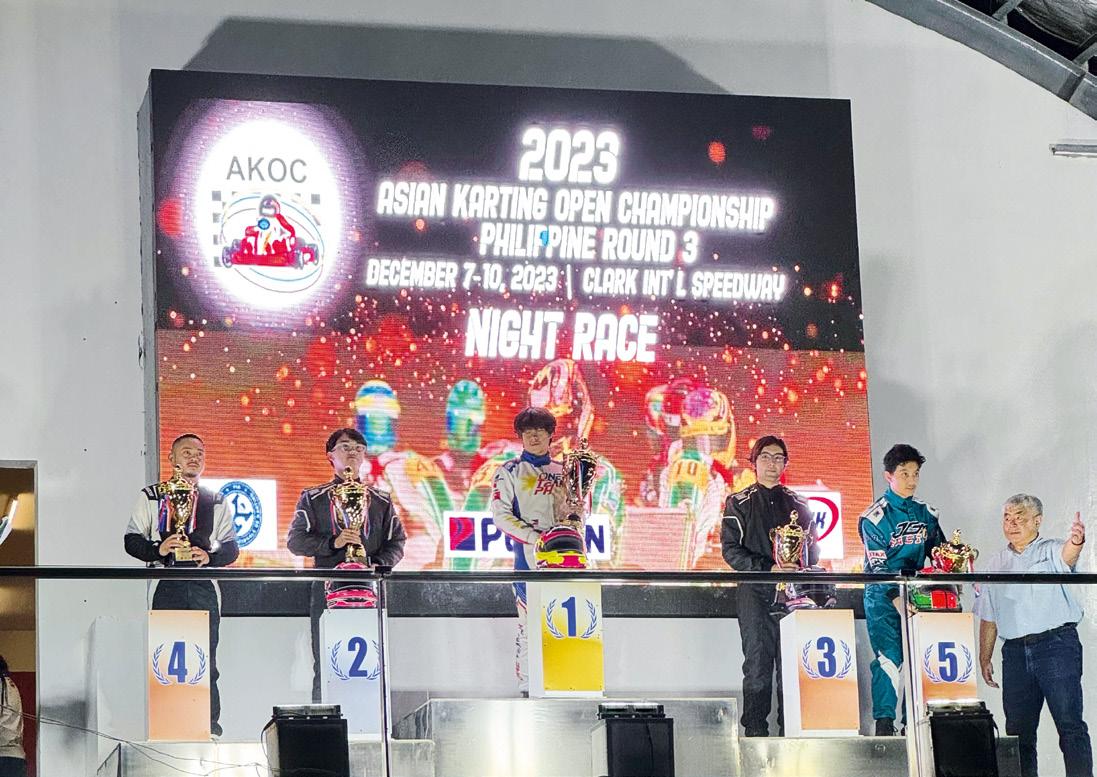 Rising Star in the Philippine Go-Karting Scene
Rising Star in the Philippine Go-Karting Scene

Mikel Fuentes has left an indelible mark on the Philippine gokarting scene following his outstanding performance in the recently concluded Asian Karting Open Championship (AKOC). Fuentes, a 17-year-old rookie karter, only began racing professionally this 2023, making waves in the local ROK GP Cup and the ROTAX MAX Challenge series within the Senior Clubman division.
With the guidance of Resultado Racing's Head Coach Milo Rivera and Assistant Coach Bern Corpino, Fuentes has unlocked his full potential, successfully competing at the expert level, going head-to-head with some of the country’s seasoned karters.
At the last leg of the International Asian Karting Open Championship, the pinnacle karting competition traditionally held in Macau, culminating at Clark International Speedway in Pampanga, Mikel proved his mettle, finishing P3 in both the Formula 125 Senior Open and ROK GP Senior categories. This podium finish was well-earned: on day one, Mikel started P6 on the grid for Qualifying Heat 1 but had to overcome a minor accident in turn three. Yet, despite a bent steering column that caused Mikel to drop to P11, he clocked a very competitive time and finished strong.
He further proved his dominance in Qualifying Heats 2 and 3, starting from P6 but finishing P4, setting the fastest time in both heats. He didn’t stop there and clocked the second-fastest time during the warm-up session on day two. In the Pre-Final, starting from P5, he diced with expert karters, dropping down to sixth and seventh at one point before making his way up to fourth, overtaking top karters like Miguel Quiñones and setting the fastest lap time of the race at a blistering 47.23.
Unfortunately, due to a dropped bumper, Fuentes received a five-second penalty and finished in sixth position on the Finals grid. Nonetheless, he refused to be restricted by this challenge and put up a fierce fight. Starting in P6, Fuentes slowly made his way past the other karters as his tires warmed up. He overtook Joshua Marquez, Quiñones, Gabriel Carag, and finally Kim Lagman, securing a spot on the podium at P3 (2nd Runner Up) in both the Formula 125 Senior Open and ROK GP Senior categories. Mikel’s hard work and patience have contributed significantly to his success. He acknowledges that none of his achievements would have been possible without the support of his team.
Today, as a member of Resultado Racing, the team's exceptional coaching, training, mechanics, and camaraderie among teammates have been instrumental in his win. The Asian Karting Open Championship has proven to be a litmus test of the team's capabilities, bolstering their confidence in this debut race. As the 2024 season approaches, Resultado Racing is confident Mikel can lead his teammates as Team Captain, promising a successful year ahead. Mikel has proven himself to be a rising star in the Philippine go-karting scene, and the future looks bright for both him and Resultado Racing, along with the support of Malayan Insurance and Resultado Gourmet Designs, Co.
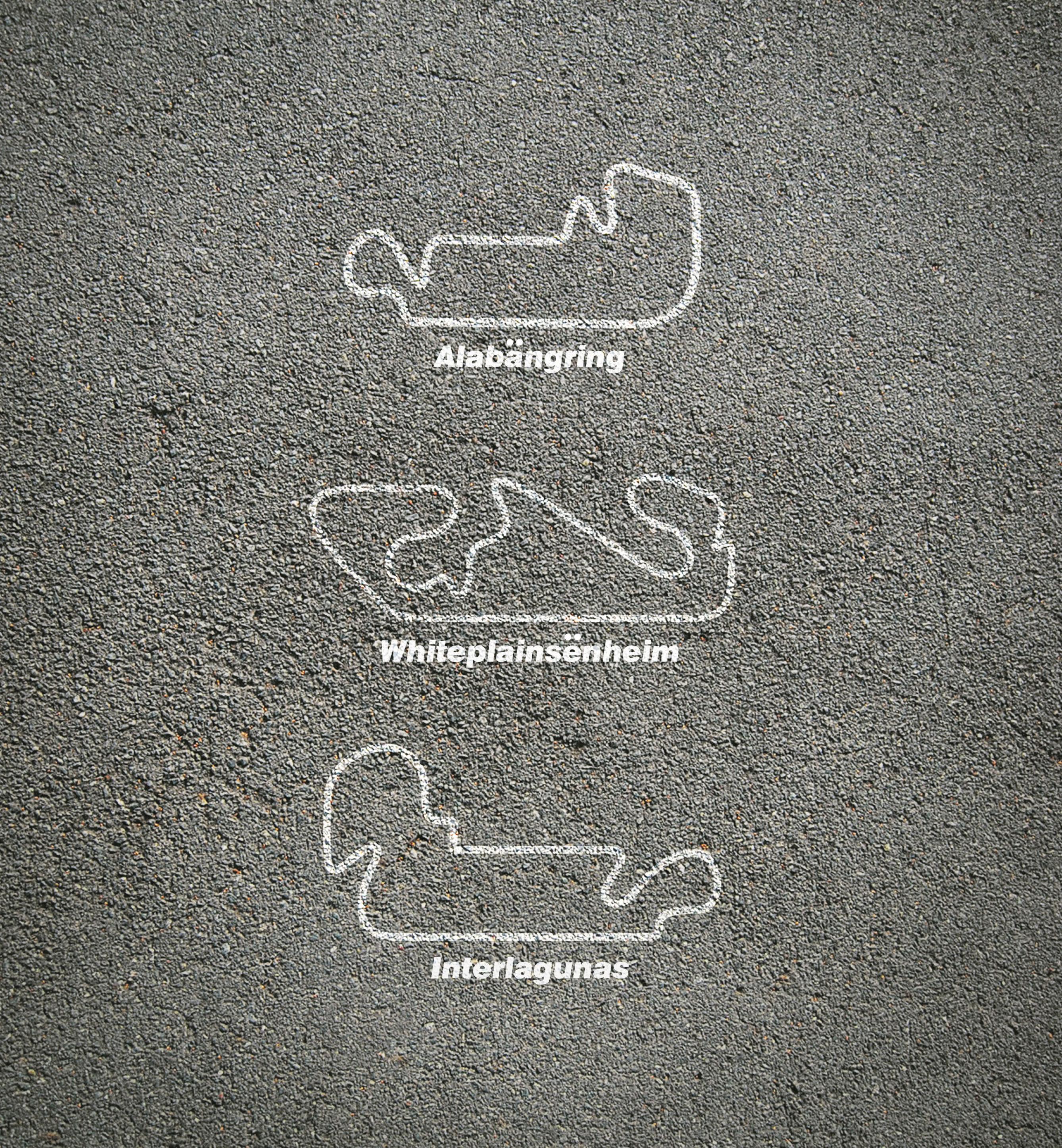
It sounds wrong because it is wrong.
Let’s not turn our public roads into racetracks.
A Safety Reminder FromTHERE IS MORE TO LIFE THAN JUST CARS, SO WE'VE GOT YOU COVERED ON THE OTHER THINGS THAT MIGHT INTEREST YOU.

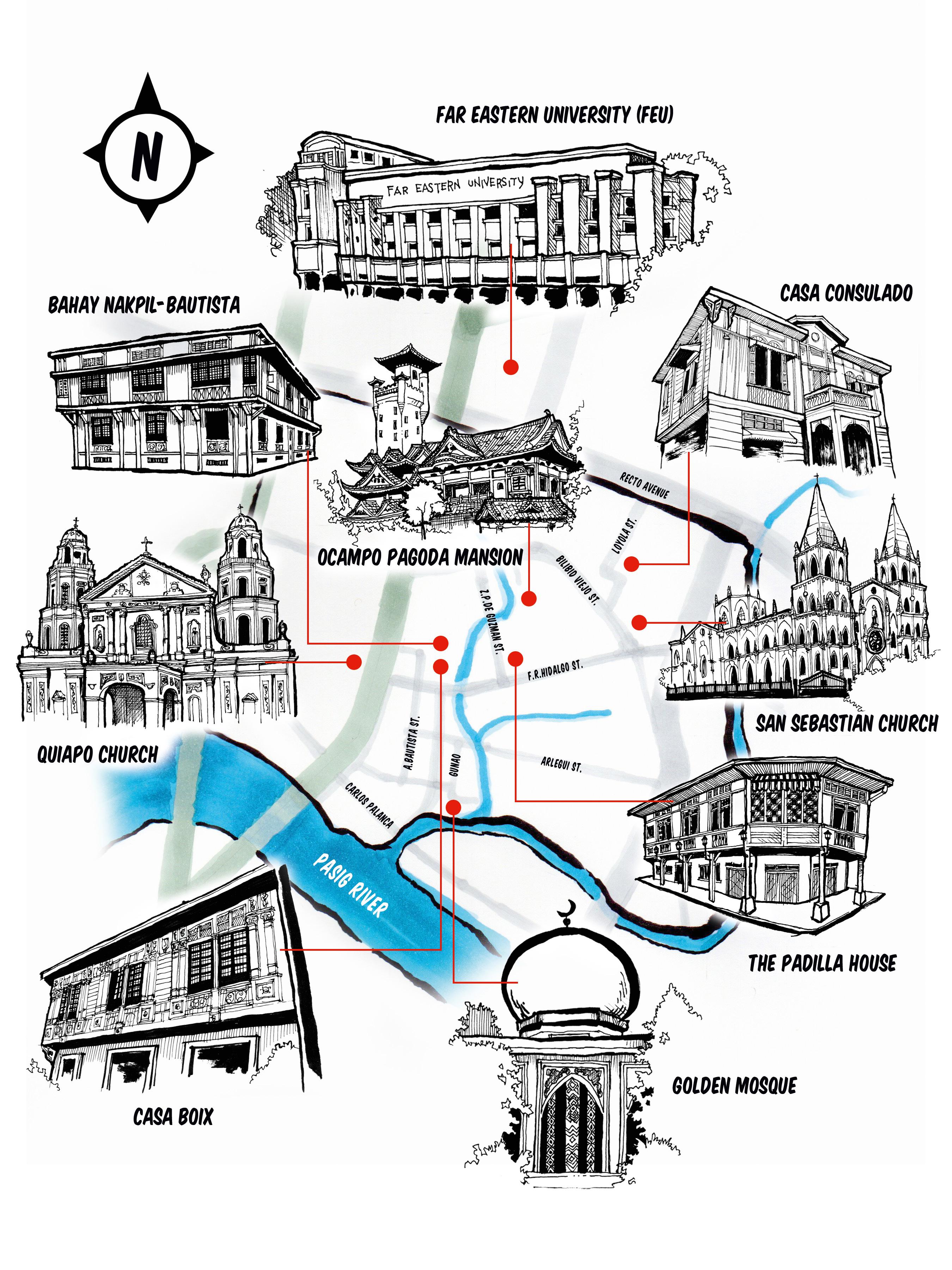




Istart and end my tours at Far Eastern University (FEU), a model of heritage preservation recognized not just around the Philippines with 6 of its buildings and 6 of its major artworks recently listed as National Cultural Treasures, but internationally as a UNESCOawarded art deco campus. We see well-preserved buildings made primarily by National Artist for Architecture, Pablo Antonio, Sr. and his son Jun, along with restored artworks by National Artists for Visual Art like Fernando Amorsolo, Vicente Manansala, Carlos “Botong” Francisco, and Napoleon Abueva. Having presented a basic introduction of preservation, why it is needed, and what it can do for a community, I then take tour participants off campus into Quiapo's rich and historic district.
Before setting foot in Quiapo, I often start with three questions.
First, how many here have been to Quiapo? Surprisingly, many of my guests, most of whom live in Metro Manila,


have never been to Quiapo. Not surprisingly, there are many misconceptions about the district, which leads to the second question.
When you hear the word Quiapo, what senses get tickled?
For some, Quiapo conjures images of a city in decay, sounds of traffic, and the scents of trash and stale water. These are all true!
Not to distort or apologize for reality, but there is so much more to Quiapo than what meets the eyes, ears, and nostrils.




Now for the third question: What comes to mind when you hear the word Quiapo?
Chances are, you will think of the Quiapo Church or perhaps the Golden Mosque. These are true, too! Religion plays a dominant role in the Quiapo of yesterday and today. These centers of worship have developed over time and, in turn, spawned bustling marketplaces around their perimeters and leading to their gates.
There is another important and even older church that merits attention. The 132-year-old San Sebastian Basilica as we know it today is an architectural wonder whose all-steel structure is being eaten by rust and an artistic jewel whose trompe l’oeil paintings are fast fading. The Save the San Sebastian Basilica Foundation is leading a multi-decade, multi-sectoral restoration involving Filipino and foreign experts and funders in addition to the local community. As can be imagined, restoring the San Sebastian Basilica is neither easy nor inexpensive. The Foundation continuously fundraises, including through “The Sponsor the Restoration” program, which is an open call for organizations, devotees, heritage enthusiasts, and companies to own the restoration as Sponsors. Tours like ours that go through official Basilica channels contribute to the program.
On a smaller but no less daunting scale, maintaining a heritage home also entails program development, fundraising, and community support. Another key ingredient in restoration is family consensus. Right by the perimeter of the Basilica is the Casa Iturralde of 1926, also known as Casa Consulado, as it was the first Consulate of Monaco in the Philippines, while Dr. Augusto Iturralde served as Honorary Consul. His son Paul was a staunch heritage advocate and fought an uphill and sometimes solitary battle to maintain and restore the house. He organized various activities, from art exhibits to lectures, to bring in people, interest, and much-needed funds. Unfortunately, he passed away, and the future of the house is in question now that it is for sale.


From Casa Iturralde, one can walk down either Bilibid Viejo or Calle Hidalgo. Taking the former route leads to The Quiapo or Japanese Pagoda, designed and built by Atty. Jose Mariano Ocampo between 1936 and 1941. The whimsical tower is all that remains of the sprawling estate. The heirs continue to find ways to fund the maintenance of the Pagoda, including making it a transient home for seamen.
Choosing the other route takes one down Calle Hidalgo, once Manila's most exclusive residential neighborhood, the equivalent of today’s McKinley Road in Forbes Park. Vestiges of the bygone era remain in the few mansions left standing in various stages of neglect and upkeep. Some of these stately homes stand proudly. The Padilla Home was beautifully restored and turned into a gallery by its owner. However, since Manny Padilla’s demise in April 2018, the house has remained closed with an uncertain future. Other homes in the area are in worse condition and beg for help. Some owners have given up on maintaining their heritage homes, with at least two now up for sale. On some lots that have already been sold, planned high-rise buildings threaten the future of those structures that still stand, including the Basilica.
Off of Calle Hidalgo on Bautista Street, formerly Calle Barbosa, two heritage homes represent different phases of the restoration spectrum.
The Bahay Nakpil Bautista was built in 1914 by Arcadio Arellano for Dr. Ariston Bautista Lin and his wife Petrona Nakpil as a “traditional city house bahay na bato while adapting Viennese Secession” elements. Per Maria “Bobbi” Nakpil Santos Viola, a descendant who helps manage the Bahay, “the realization of the importance of the Bahay styled with unique interpretations of the
"Getting more people involved from the local community can lead to a greater awareness and appreciation of the heritage sites around them, which in turn may translate to pride of place, and then, hopefully, a commitment to preservation."
Viennese Secession in its early form but more importantly that we are descendants of active participants in the 1896 Revolution has committed us to preserving and maintaining the house.” To generate awareness and income for the house, Ms. Santos-Viola and her team of volunteers have developed a wide array of programs and activities, such as hosting tours to give a special experience of exploring a significant and historical heritage house in the heart of Manila, round table discussions by recognized historians and writers on the teachings of the Katipuneros (revolutionaries), visits from students and hands-on activities and lectures, such as on baybayin, palaspas for Palm Sunday and traditional parol-making. For social advocacies and good neighbor outreach programs, the Bahay hosts mentoring and reading sessions for the neighborhood’s children, free acupuncture, inter-faith harmony events, and activities for refugees and migrants.
Beside the Bahay Nakpil Bautista, the Casa Boix, built in 1895, was donated to the Society of Jesus or the Jesuits. Of her next-door neighbor, Ms. Santos Viola quips: “Inheritance issues prevented the Jesuits from claiming the house,” which is literally about to fall apart for a variety of reasons including but not limited to neglect and its consequences like infestation, leaks, and illegal settlers.
Our tour ends back at FEU to uplift the sagging spirits and show that heritage structures can be preserved and adaptively re-used in a 21st-century society.
Getting more people involved from the local community can lead to a greater awareness and appreciation of the heritage sites around them, which in turn may translate to pride of place, and then, hopefully, a commitment to preservation.
Getting more people to tour these heritage sites will hopefully get them to take pride in heritage structures and communities like Quiapo and be aware of the need to preserve them for future generations.


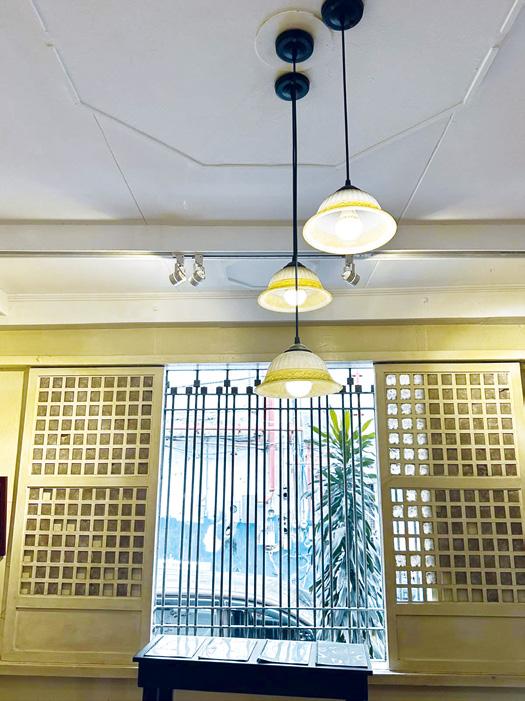




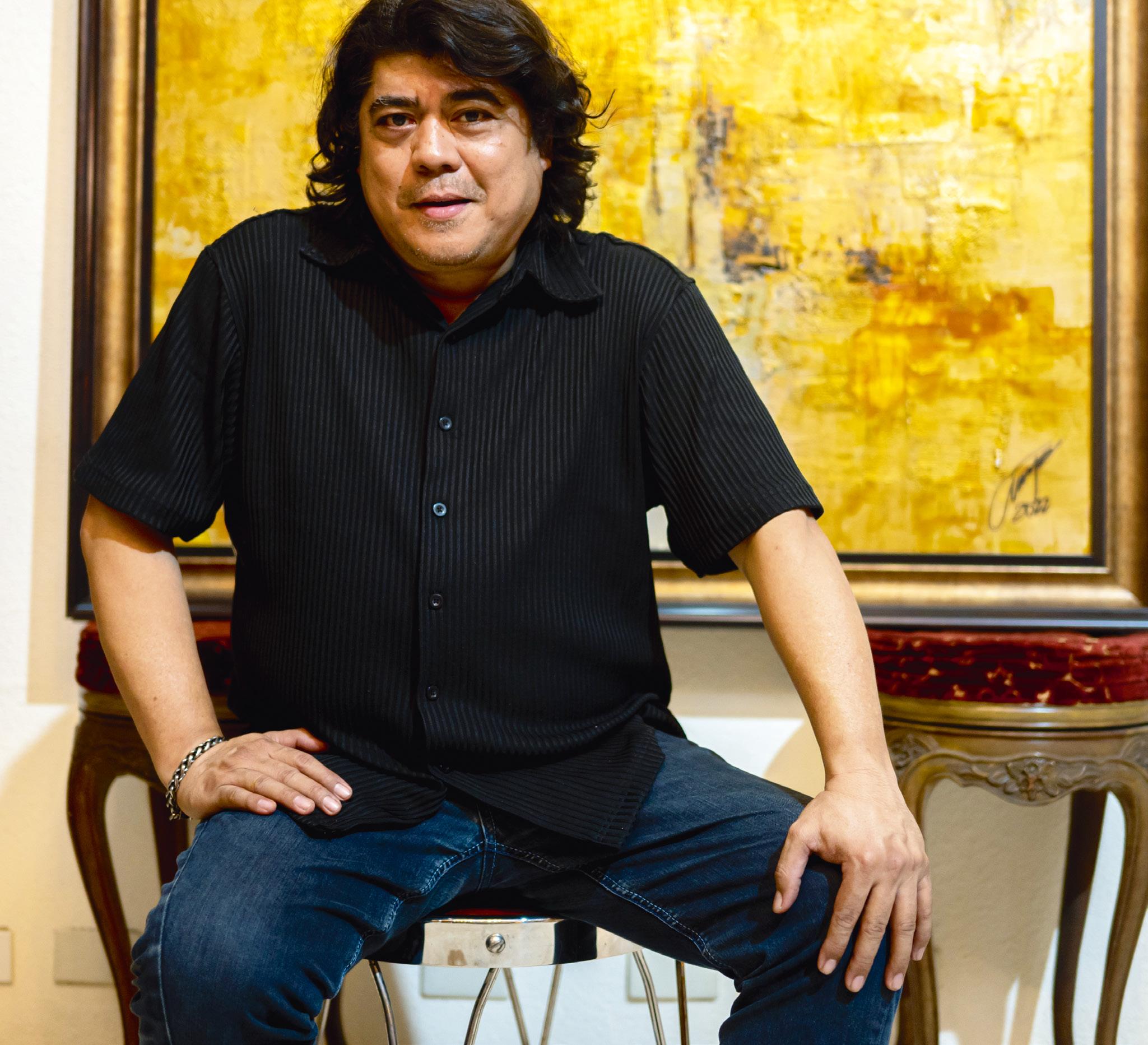
AS SOMEONE WHO ENJOYS PHOTOGRAPHY AND BEING ABLE TO CAPTURE EMOTIONS AND HAVE THE OPPORTUNITY TO KNOW THE STORIES AND LIVES OF OTHER PEOPLE, I find this story one for the books. As a young writer, meeting such an esteemed and renowned artist like Ivan Acuña was a precious and golden moment for me. Meeting his family and witnessing the presence of his artwork and collection is a privilege worthy of sharing. But first, who is Ivan Acuna anyway?
Ivan, born in Manila on August 23, 1966, pursued Fine Arts at the University of The Philippines and participated in art workshops in Brisbane, Australia. During his youth, Ivan frequently visited the home of Alan Baldovino, who was his classmate at the time and also the son of the esteemed photographer Dick Baldovino and the nephew of Jose Joya. This exposure ignited his passion for the arts. His artistic style draws comparisons to the works of Willem De Kooning and Joan Miro, both of whom greatly influenced him. Initially starting
Advice to anyone who is struggling to find their own sense of art style?
You can find yourself in it, or you can lose yourself through it. Express yourself, and no matter how mundane you think it is, it's a story to be seen, to be felt, to be had.

as a professional photographer, Ivan transitioned into becoming one of the Philippines' beloved contemporary artists. As a non-traditional artist, Ivan prefers his artworks to be integrated into collaborative designs rather than displayed solely in art galleries. The diverse cultural backgrounds of his clientele underscore the international appeal of his paintings.
Over the years, Ivan has held numerous exhibitions, with notable showcases including a sold-out solo event at Prestige Motors BMW in Makati in 2004 and this year’s Rustan’s Essences Show at upscale Rustan’s, also in Makati. Currently, his artworks are on display at Livingstone on La Cienega Blvd. in West Hollywood, California.
In his artistic pursuits, he finds joy in spontaneity, reveling in the vivacity of life. He embraces the liberating expression found in abstract adventures through painting. His passion for life serves as the driving force behind his art, particularly evident in the Metalscapes series. Inspired by the galvanized aluminum sheets known as "yero" roofs commonly found in impoverished areas of Paranaque City, he channels this inspiration into his creative endeavors.
Being an artist for decades, Ivan continues to source his inspiration from the simple act of his love for life. To Ivan, everywhere is a source of creativity; “Lately, I’ve been fond of old places like Binondo and San Miguel, Bulacan. Aside from that, the morning presence and the way sunlight shines over the buildings in the cities of BGC and Makati have been serene to me.”
“Family is everything,” Ivan said. In my short time between meeting his family and having a short tour around his house, I managed to meet his two sons, Chino and Iñigo. It was not a surprise that the two of his sons were remarkable painters as

 Color Collage By Chino Acuña
The Cobblestone Series
Color Collage By Chino Acuña
The Cobblestone Series

What are some of the most memorable or rewarding experiences you have had as an artist?
In my line of work, I meet with so many people, often much older than I am. I enjoy hearing their stories and advice. Being in such a position is one of the most enriching parts of my work.
— Iñigo Acuña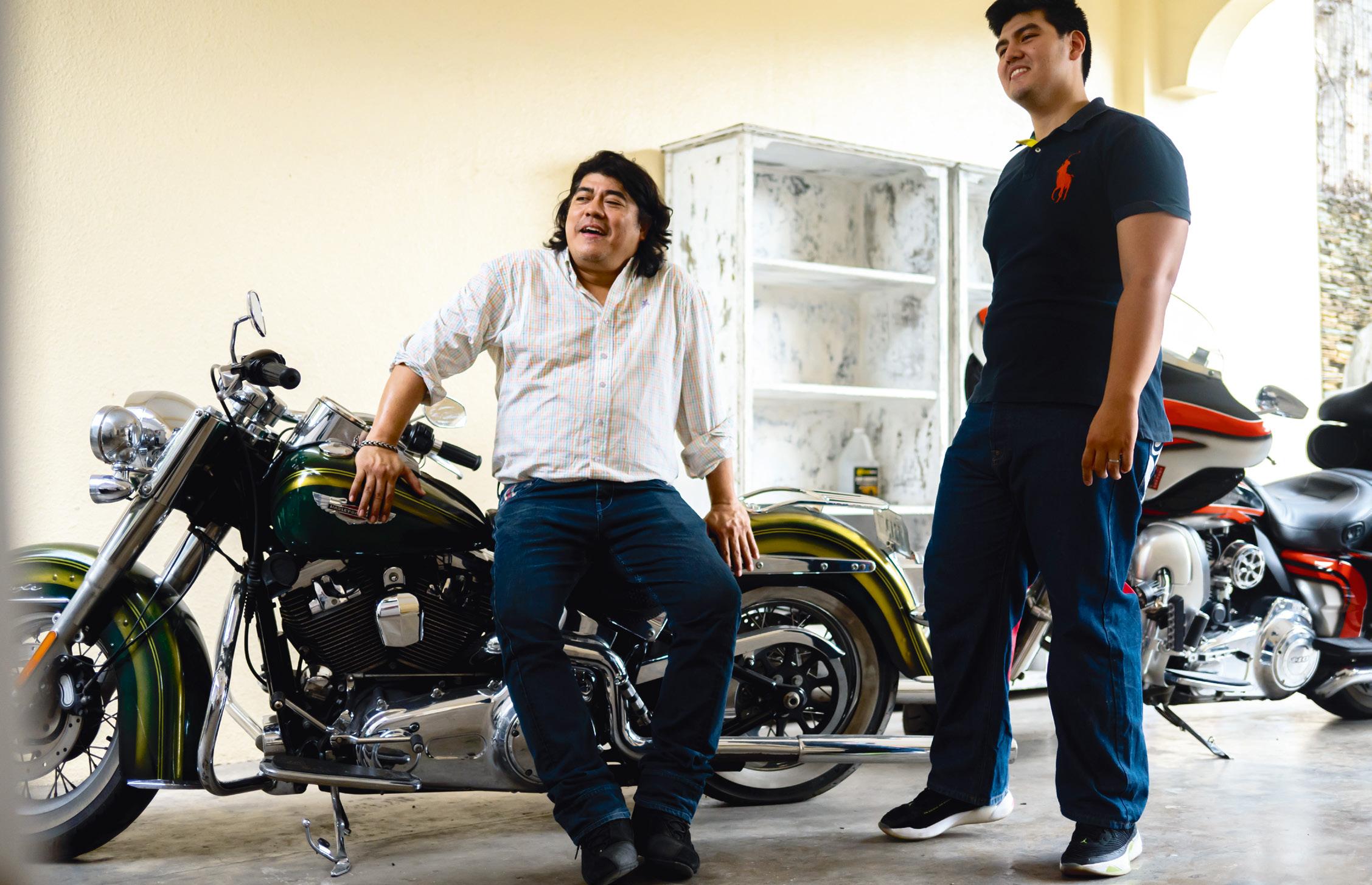
well. In fact, Ivan did not influence or push them in any sort of way to pursue painting. “I did not particularly push my sons into the art world, but just by observation, they, on their own, wanted to paint, willingly, without any strong push from me and Peaches, their mother,” Ivan said. Let's delve into a few details about Chino and Iñigo.
Chino, the eldest son of Ivan, was keen to discover the smallest details while growing up. He had an eye for little trinkets, noticing objects that might otherwise pass as mundane. He would delve into their facets and envision their beautiful possibilities, finding interest in everything with a story to tell.
His art embodies layers, strokes, shapes, colors, and facets—each with its own story to tell, a journey to embark on, people to encounter, friendships to forge, conversations to spark, flavors to savor, and emotions to feel. Chino hopes that those who view his art are stirred into a whole new world or simply allowed to exist in the moment. His art is dynamic, alive with every brushstroke, never static. He desires his collectors to experience sensations and movements, to find new narratives within his creations each time they engage with them.
Inspired by the works of his father and also the likes of H.R. Ocampo, Takashi Murakami, and Mr. Yanen. Iñigo pursued a career in painting, making
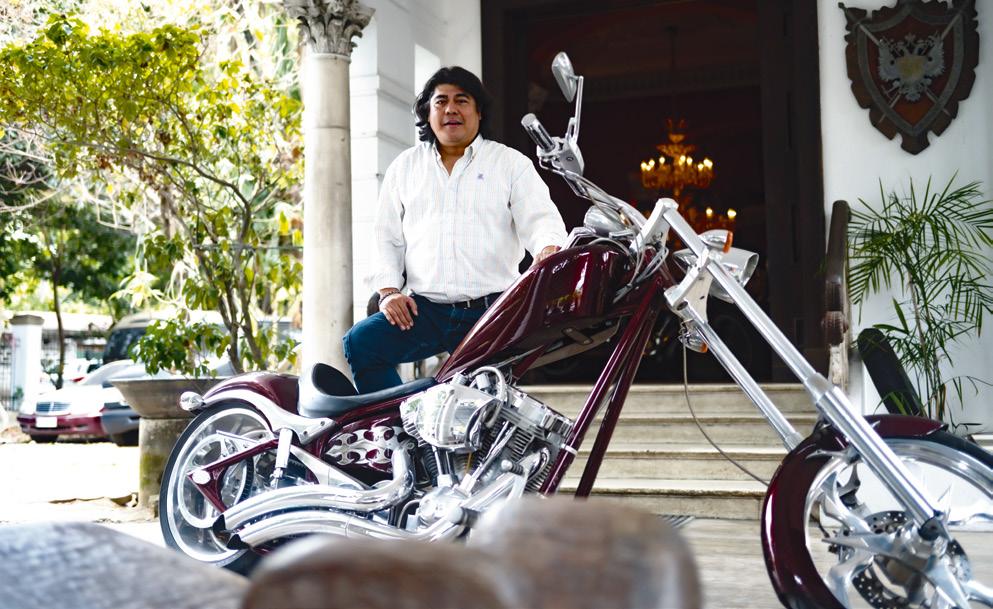
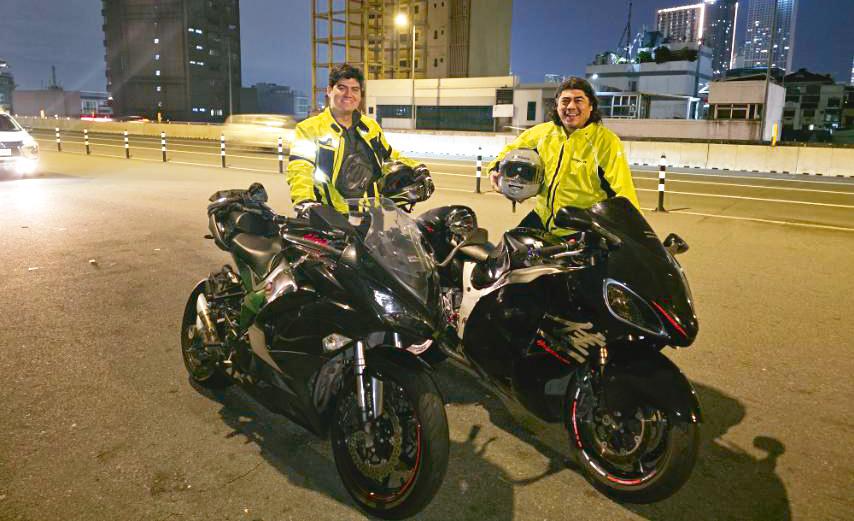

made-to-order works using a collaborative process with clients, from size to color palette to texture. His foundation of art relied upon the heritage that stems from his family.
When asked about the themes or messages he wants to convey through his artwork, he answers: “I find peace in the process of creation and enjoy working with different methods to innovate my style. My goal is to create pieces that convey a human feeling and a sense of balance in the composition.”
Aside from collecting different forms of artwork and collectibles, Ivan also considers himself an avid motorcycle enthusiast; together with his son, Iñigo, the two of them share a tremendous and unique collection of Vintage Harley Davidson and custom-built bikes altogether with other modern motorcycles. Ivan and Iñigo were gracious enough for us to have a look at their collection up close, even allowing me to have a seat on one of his special Harley Davidson bikes. Throughout the afternoon, they shared some short stories of the trips they had together, one, particularly in Bicol, where they rode at night all the way from Manila and almost got themselves involved in an accident. “There was a pothole around sixteen inches deep, and the rider

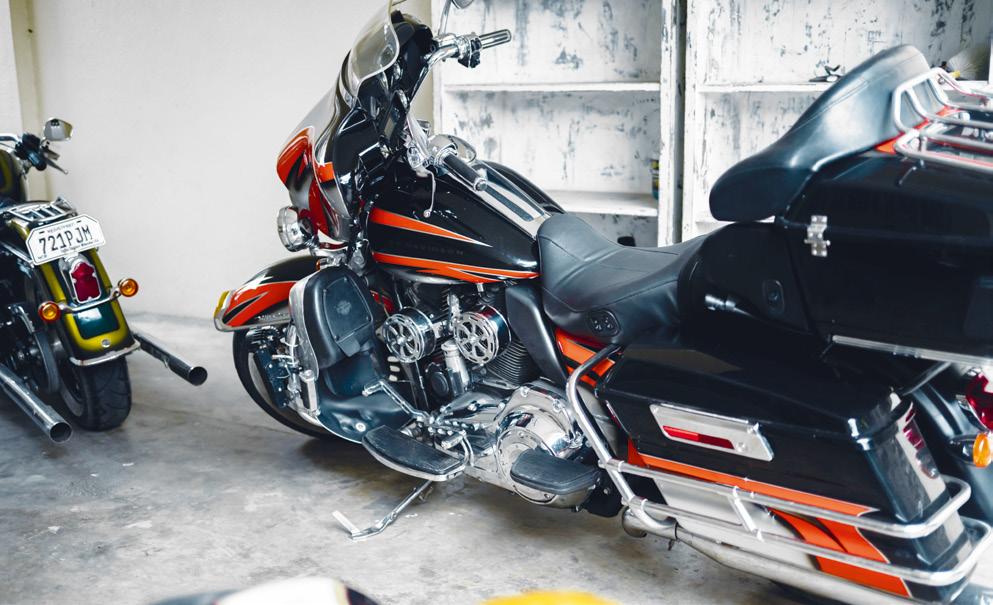

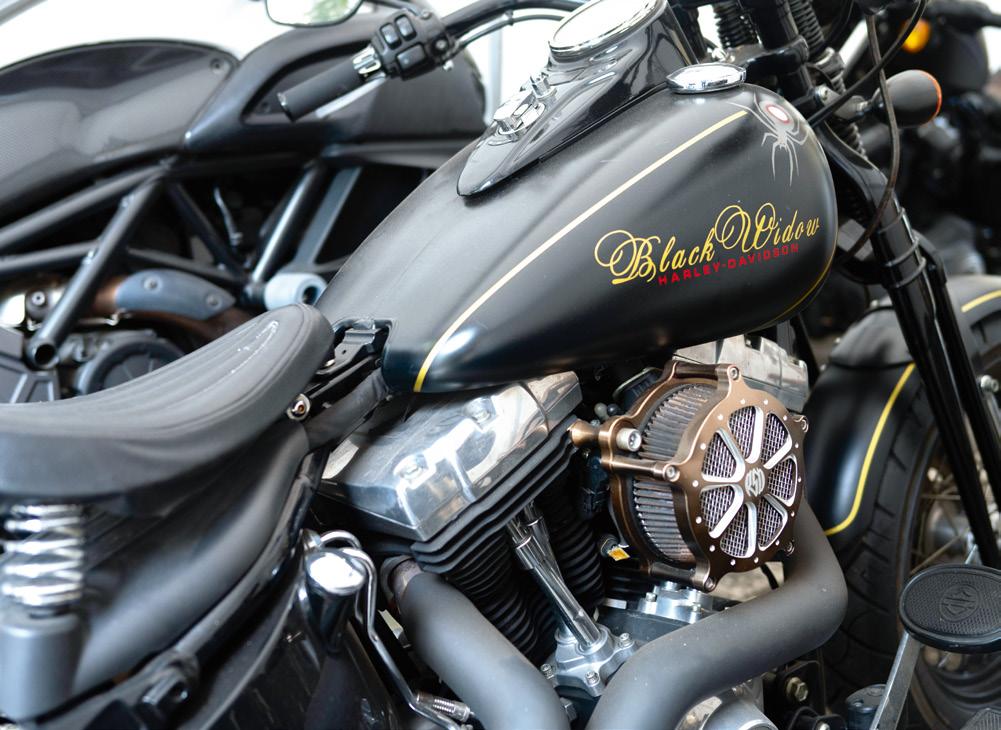


in front of me I thought nagyayabang. I thought he was doing a wheelie. Akala ko nag whe-wheelie siya tapos nakita ko tumilapon na siya and yung motor niya tumilapon na nang pa ganun, so yung wife ko who was my backrider, we dodged him very quickly and we were so close to him. So we stopped on the side of the road, and thankfully, the rider was okay.” Iñigo shared.
Being the one who always uses this bike, how is the bike special to you? Asked to Iñigo.
“I've been on a couple of trips with the bike. Manila to Bicol, Manila to Baguio, Manila to Aparri, Manila to Batangas, and a lot of Marilaque. I feel like I've had enough saddle time to say that the motorbike is heavy. Really heavy. But it's due to that weight that grants it such grace and stability on the highway-it balances like a paperweight. With a motorbike this bulky and low, you can easily drag peg long before your knee scrapes the ground. I often drag the bottom in corners effortlessly, even more so with my wife onboard.”
“Ivan started buying or collecting Motorcycles as a hobbyist around twenty years ago. He loves the sense of freedom that comes along with riding a two-wheel machine.”

“I feel that it is one of the more refined Harley Davidsons wherein it isn't as loud, but it retains its beauty and comfort for touring. Still a head-turner of a motorbike and a giant on the road. That bulk is mainly because of its baggage capacity and styling. A motorbike that is really meant for touring, but I feel that it is unexerted on the straights of the Philippines. It needs runway-like highways with no obstacles and smooth roads to truly shine. Unfortunately, roads like that are far and few in our country. It overheats in heavy traffic and burns my thighs in bumper-to-bumper traffic. Its metal-age technology with air cooling is inefficient in our daily transit. Nevertheless, the bike has found a special place in our garage, and it has made memories for my family along the way. A square peg in a circular hole-it doesn't fit, but that's alright.”
Ivan started buying or collecting motorcycles as a hobbyist around twenty years ago. He loves the sense of freedom that comes along with riding a two-wheel machine. He enjoys the guttural sounds of big bikes and admires the design, especially that of choppers. While he was showcasing his bikes to us, we could clearly feel the passionate tone of enthusiasm he had. The reality of his collection was not born out of the fact that he can afford those bikes, but rather, the fact that he is genuinely passionate. Looking forward, clearly, Ivan’s motorcycle collection doesn’t end here. He mentioned in particular that choppers are his favorite kind of bike. So, we can expect more of those in his collection sometime soon.
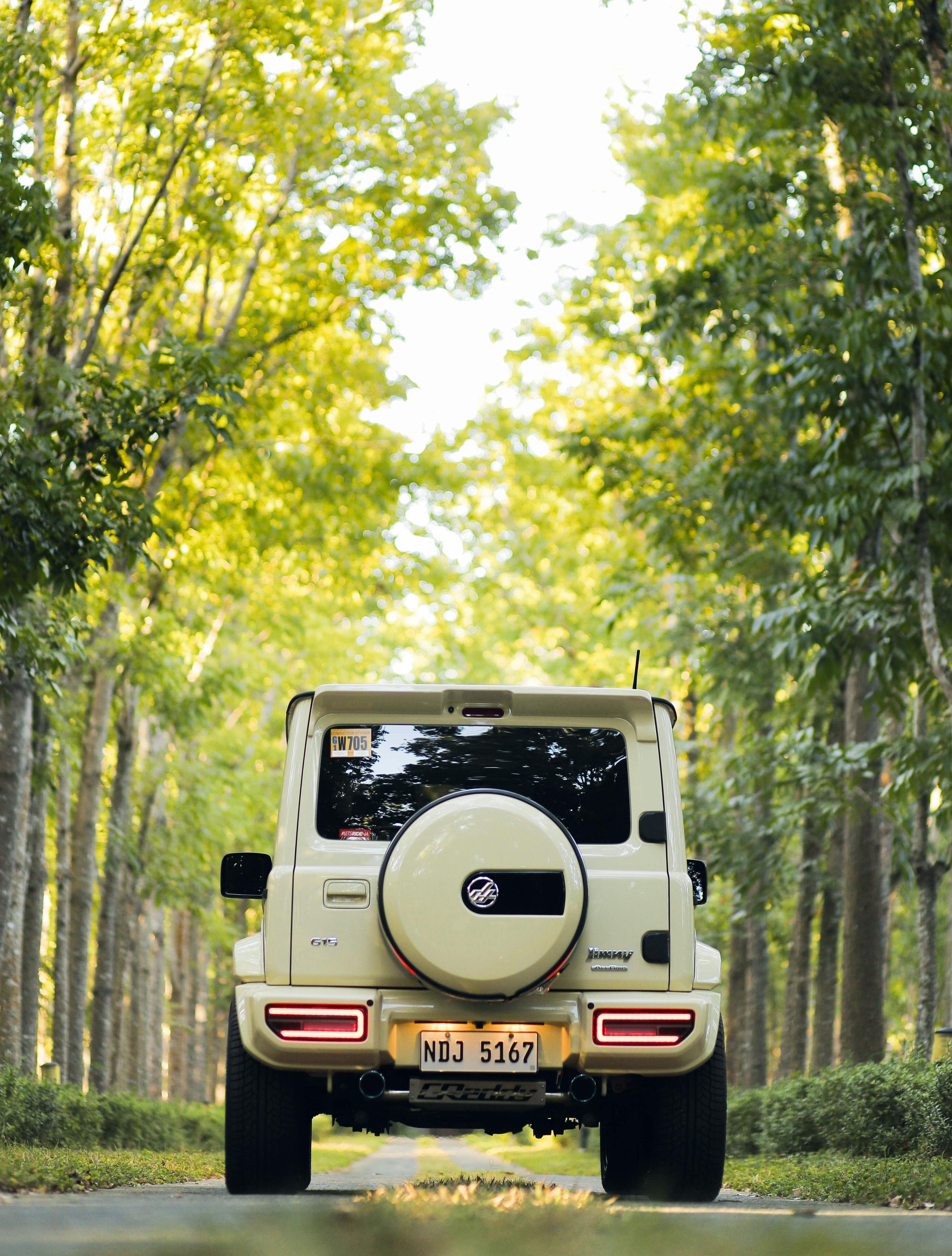
Dude, where’s my autonomous car?
Watched a movie re-run the other night about a robot and as to be expected, Hollywood never ceases to amaze the movie goer. Their mastery in producing special effects and computer-generated images really captures one’s imagination. At one point the movie clearly depicted how life might be in presence of these things, which are supposed to make our lives much easier. But being a self-confessed car nut, I couldn’t help but notice the working details of the robot such as the actuating linkages and mechanical bits as he went about doing all kinds of stuff that humans do. In a way, it reminded me of the current crop of automobiles being produced and developed by and Europe and other countries. No, it’s not one of those hybrids or fully electric vehicles. What I’m referring to are the autonomous or self-driving cars. I mean, it’s no secret that major car manufacturers have been developing and testing autonomous cars for years. These include Audi, BMW, Ford, Google, General Motors, Tesla, Volkswagen and Volvo.
Here in the Philippines, they may not be on our roads yet. But did you know that autonomous or driverless vehicles traveled nearly 3.3 million miles in California last year? According to studies, that’s over five times the previous year's total. If you happen to be in the San Francisco area, don’t be surprised to see taxi’s with empty driver’s seats as this is pretty normal. The path toward self-driving cars slowly began before the year 2000 with standard automation features for safety and convenience with features such as, cruise control and antilock brakes.
“If you ask me, I don’t want to wake up to the day when what I have inside my garage becomes a boring thing with a supposedly mind of its own that can take me to a predetermined destination at the push of a button and all I have to do is sit.”
After the turn of the millennium, advanced safety features, including electronic stability control, blind-spot detection, collision and lane shift warnings, became standard in some vehicles. This progressed into advanced driver assistance capabilities, such as lane-centering assistance and the ability to self-park.
Seems scary for someone like me who actually likes to drive and is into mechanical things. But perhaps this is what the car manufacturers predict as the future of the automobile. A lot of stuff that’s heavily reliant on AI technology and purely automatic. From what I’ve read, benefits include passenger safety and comfort. But we have to draw the line somewhere between laziness and the act of sheer driving. With autonomous driving we would now leave everything, including our lives to the computer who will do all the decision making and driving. Imagine what it felt like during the first few weeks or months that you were driving? An important part of it was the thrill of making your own decisions with the possibility of making a mistake.
 Francis G. Pallarco TUNER EDITOR
Francis G. Pallarco TUNER EDITOR
Given that scenario might already be cast in stone for the future, I hope car manufacturers should focus more on their best-selling conventional car platforms in the meantime. Just make sure that the basic requirements are met and refined. The average person just wants a simple automobile that looks good without taking styling cues from Star Wars, gets good mileage, can hold up well on the corners and equipped with a responsive engine. If you ask me, I don’t want to wake up to the day when what I have inside my garage becomes a boring thing with a supposedly mind of its own that can take me to a predetermined destination at the push of a button and all I have to do is sit.

An ounce of prevention is better than a pound of repairs
Every new car has a periodic maintenance schedule that lessens the need for repairs in the future. So it pays to follow the schedule.

Words: Francis G. Pallarco Photos: Mariony Dela Cruz


Aside from being in a segment where it has no rivals, the most attractive feature of the Suzuki Jimny has to do with its compact “box-like” dimensions. Add a dash of retro-inspired exterior style cues with the right bits and pieces and you have the makings of a fun on and off road machine. But what really accounts for the Suzuki Jimny’s continued mass appeal towards enthusiasts and the general car buying public is the huge amount of aftermarket parts available for it. The selection of wheels, suspension, body kits and more is totally mind numbing. In fact, you can say that it’s all up to one’s imagination and budget.
Just like our featured Jimny here that’s been modded by Wahlen Pangilinan of Cabspeed as he explains, “This build was commissioned by my best friend who happens to be the owner of Suzuki Cabanatuan. It was one of the very first released units of JImny’s on the market. The Jimny was very cute from the onset, and its size, cuteness, reliability and toughness made it very popular as all walks of people want to have one. Very light to drive, easy to park and fuel efficient blessed with a good ride made it a very good daily driver.”
“The aftermarket crowd went crazy in producing parts, having seen its potential. A very rare reception for a small SUV to be received by the
aftermarket tuners as a popular car to be modded. It so happened the popular DAMD tuning house in japan released its body kit that resembles the AMG G63 SUV on a smaller scale.”
In addition, The DAMD "Little G." is a special exterior upgrade made specifically for the Jimny. It’s an extremely high quality custom tribute to the iconic Mercedes AMG G63 SUV that has been affectionately nicknamed the "Baby G."
Sure enough, they were smitten with the kit and wasted no time in getting one landed on our shores as Wahlen adds, “It was love at first sight and demand was also high for the kit but we are lucky enough to secure one at the time. The install took almost a week since the panels have to be finished to match the exterior of the Jimny. It was a simple straightforward install
as the fit and finish was excellent.”
Aside from the body kit, they also changed the taillights with a pair of Jimnysport taillights to make the AMG G63 theme more complete. Overall, the exterior upgrades has totally transformed the looks of the Jimny.
Something that’s done in a subtle and clean look, especially with the color matched panels creating a seamless monochrome effect. The black accents greatly gives it a distinct look that’s found on the wheels and the roof.
Opting to keep the suspension stock for the meantime, they did however install their favorite aftermarket wheel. What else? It’s the iconic Volk Rays TE37 wheel in dark gunmetal finish that contrasts greatly against the paint color. But they hit a stumbling block because the particular style that they wanted wasn’t available in the Jimny’s


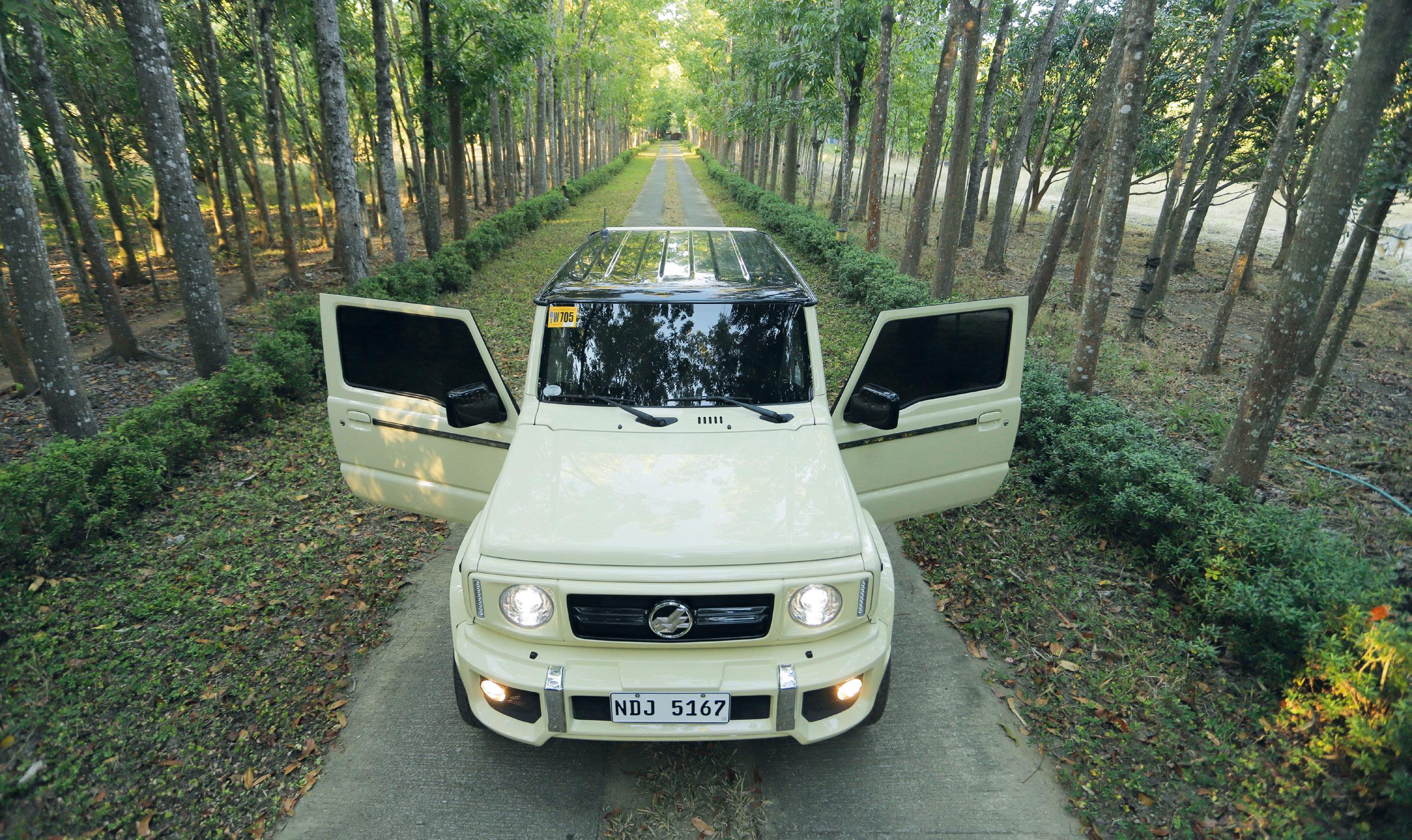

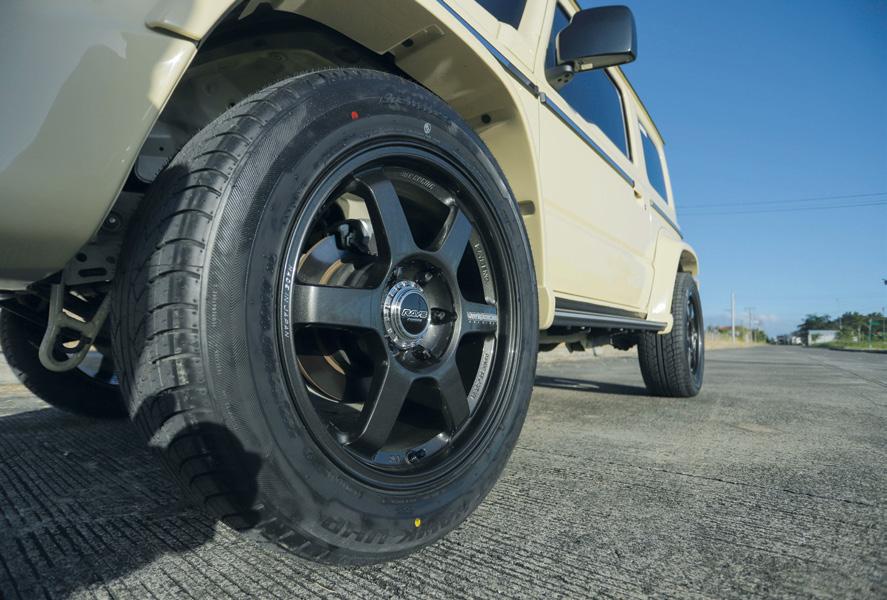


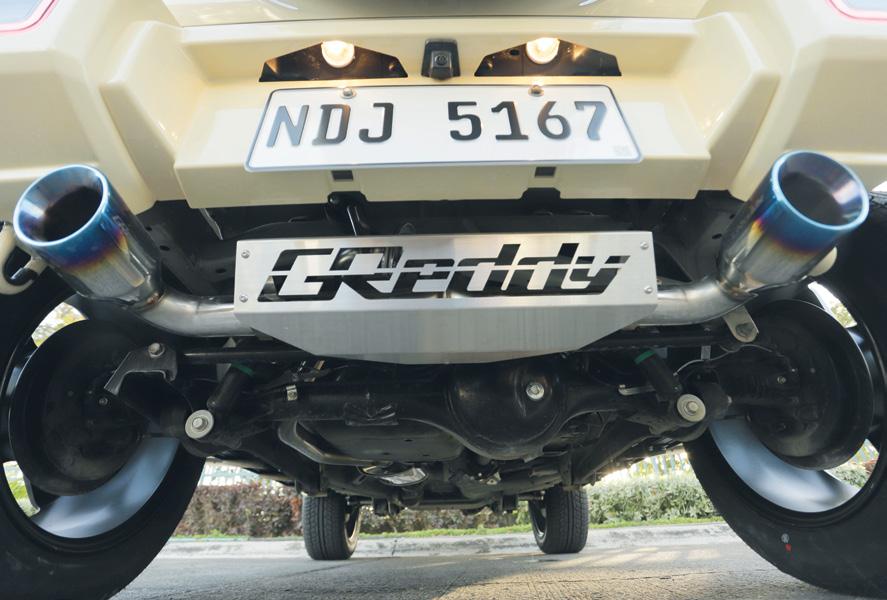
“TAKING INSPIRATION FROM STYLING CUES FROM A G63 AMG, JAPANESE TUNING HOUSE DAMD COMES UP WITH ITS OWN INTERPRETATION OF WHAT A JIMNY SHOULD LOOK LIKE.”
5x139.7 bolt pattern. The solution? A PCD lug converter from SR that simply converts the bolt pattern from 5x139 to 6x139. The offset of the 18-inch rims was just right that it didn’t poke out of the aftermarket DAMD fenders. What’s great about a tire and wheel upgrade is that not only does it look good, but it also makes the vehicle handle better and gain more traction.
Other notable mods include a Geddy XROSS catback exhaust system with its distinct dual exhaust pipes. Made specially by Greddy, this upgrade would perfectly match the Greddy turbo kit for the Jimny that would bump up the power output to around 130 horsepower. To keep the AMG G63 look and feel flowing throughout the cabin, the seats were rewrapped with custom made quilted leather that closely resembles the exterior color. Overall, the final result of the entire transformation process is this eyecatching Jimny that closely resembles an AMG G63 at a fraction of the price.
 G. Pallarco
G. Pallarco
 Francis
Photos: Timothy Dayawon
Francis
Photos: Timothy Dayawon
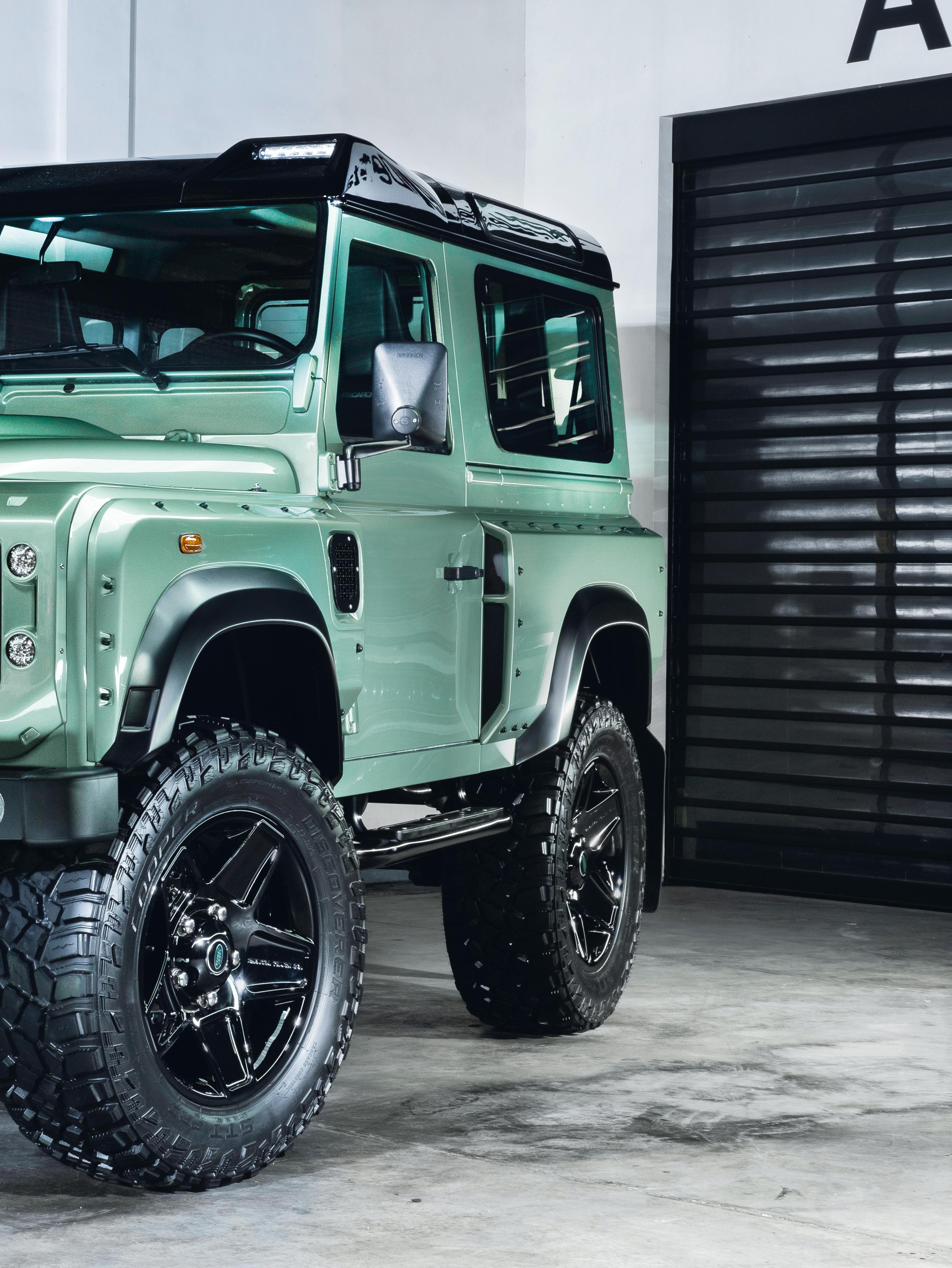


The first thing you realize about this Land Rover when you come across it in person is its size and how high it is. All I can say is that it’s downright commanding. But what strikes me most is that it’s not your typical 90 Series Defender. Judging by those wide fenders and those 20 inch wheels with gnarly off road tires, it certainly conjures up images of pulling away on a dirt road in a back country somewhere in England. While that rightfully puts it into its element, it does accomplish this with loads of style. It’s the result of the amount of work put into it and staying
▼ KAHN DESIGN
The all-too familiar Defender 90 Series silhouette, upgraded with Kahn Design’s exterior treatment using exceptional standards of craftsmanship allows this modded Defender to make a definite and lasting statement whether its driven on or off road.
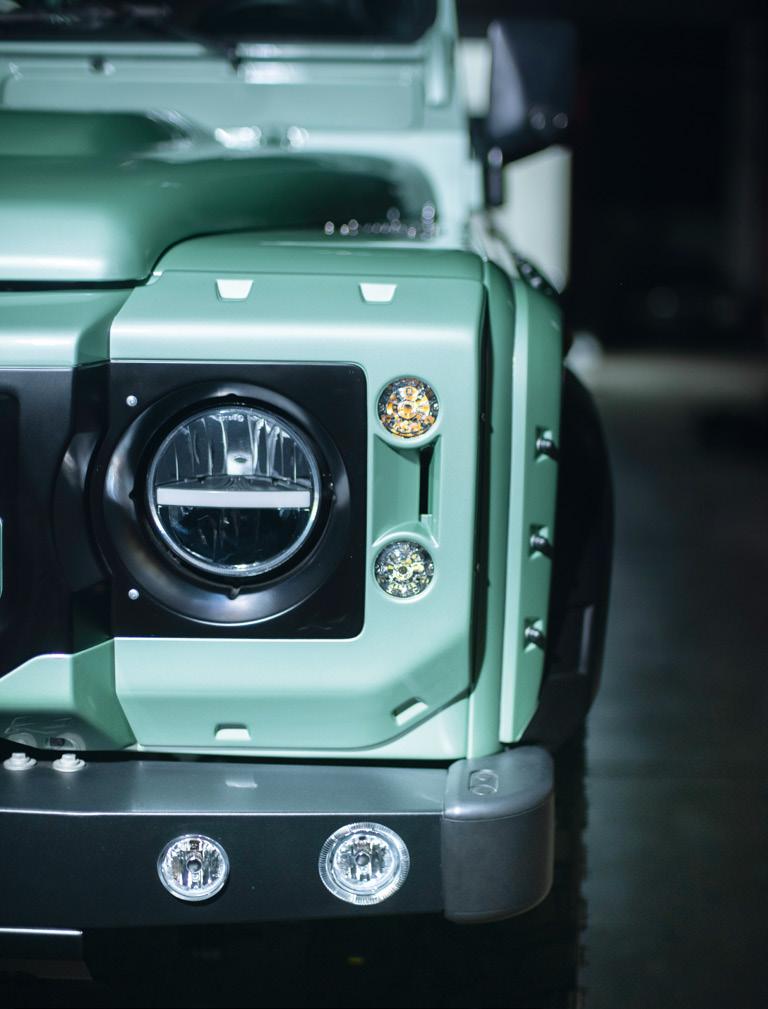
committed to the project by completing all the necessary parts to make it a catalog build just like the what the styling company had envisioned.
The transformation of this 90 Series comes courtesy of British design house Kahn which presents a new take on the iconic body style by coming up with a wide track body kit. The majority of the exterior upgrades were made by Chelsea Truck Company, which is one of Kahn's sub-brands for off-road vehicles. Kahn is a British luxury automotive fashion house specializing in bespoke collections of body kits, wheels, accessories, clothing and even merchandise by chief designer Afzal
Kahn. Exclusively catering to high end SUV’s such as Land Rovers, Bentayga, Urus and cars such as Rolls Royce, Kahn Design is backed by years of experience working with an in-house creative team of product designers, graphic artists, coachbuilders, re-upholsterers and material engineers. At Kahn they believe in redefining the spirit and aesthetic of each vehicle, always placing sophistication before ostentation, and originality before convention.
Dubbed as the Defender
Project Kahn, Keith Bryan Haw of Importhookup recently unveiled this custom build during the Manila Auto Salon and Sport Truck Show as he explains, “I always find the Project Kahn program the best looking exterior styling upgrade for the old school Defender. It retains the classic look and feel, but makes it beefier. The compact and straightforward exterior design of Defender lacks width and the Project Kahn body kit completes it. That and the classic 5-spoke wheel design suits the car so good. Perfect timing as I’m the authorized distributor for it now in the Philippines.”
The Kahn Design by Chelsea Truck co. wide track body kit conveys a unique look, while adding an extra amount of width to the bodywork. But in order to successfully pull it off, it needs to have
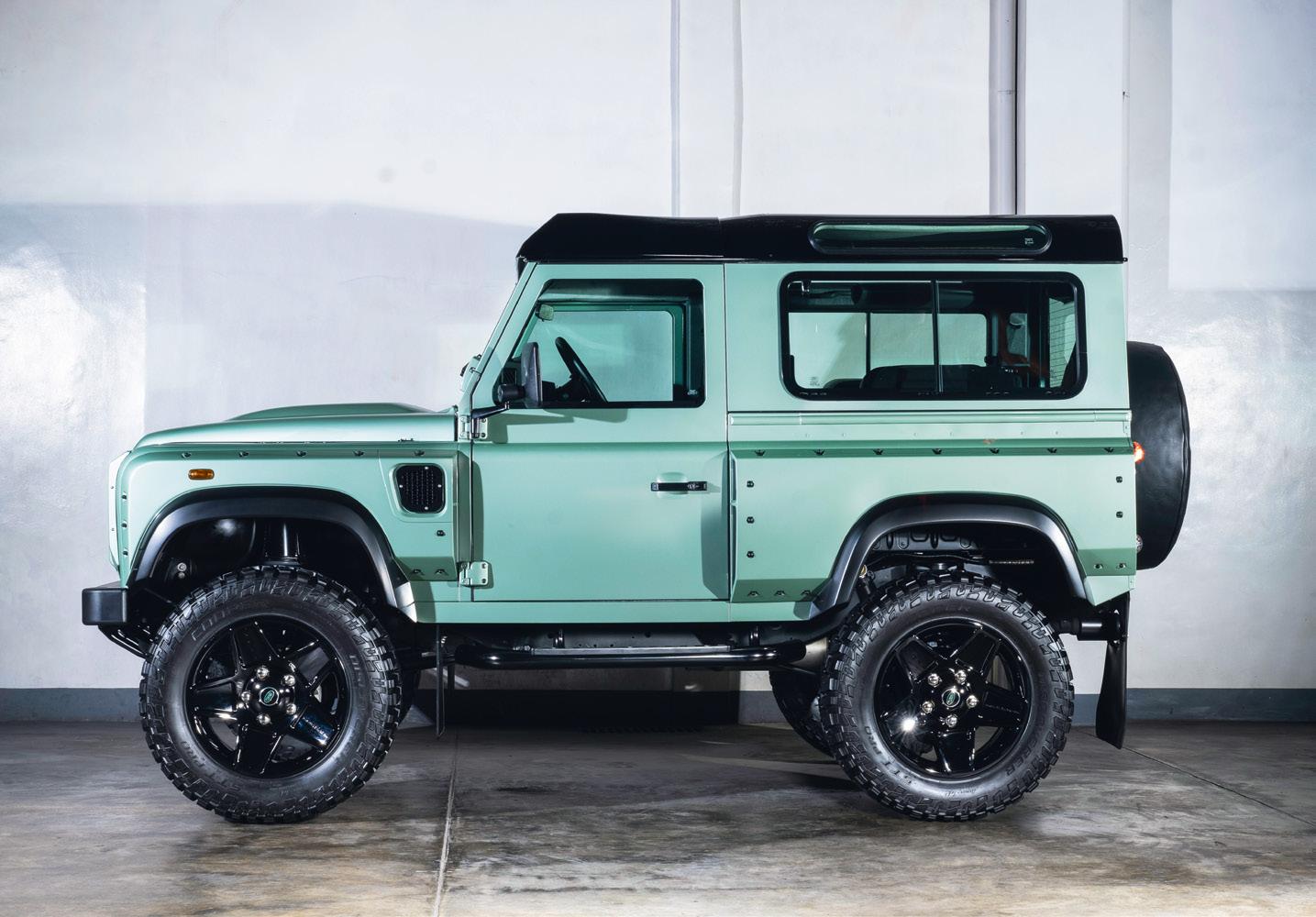

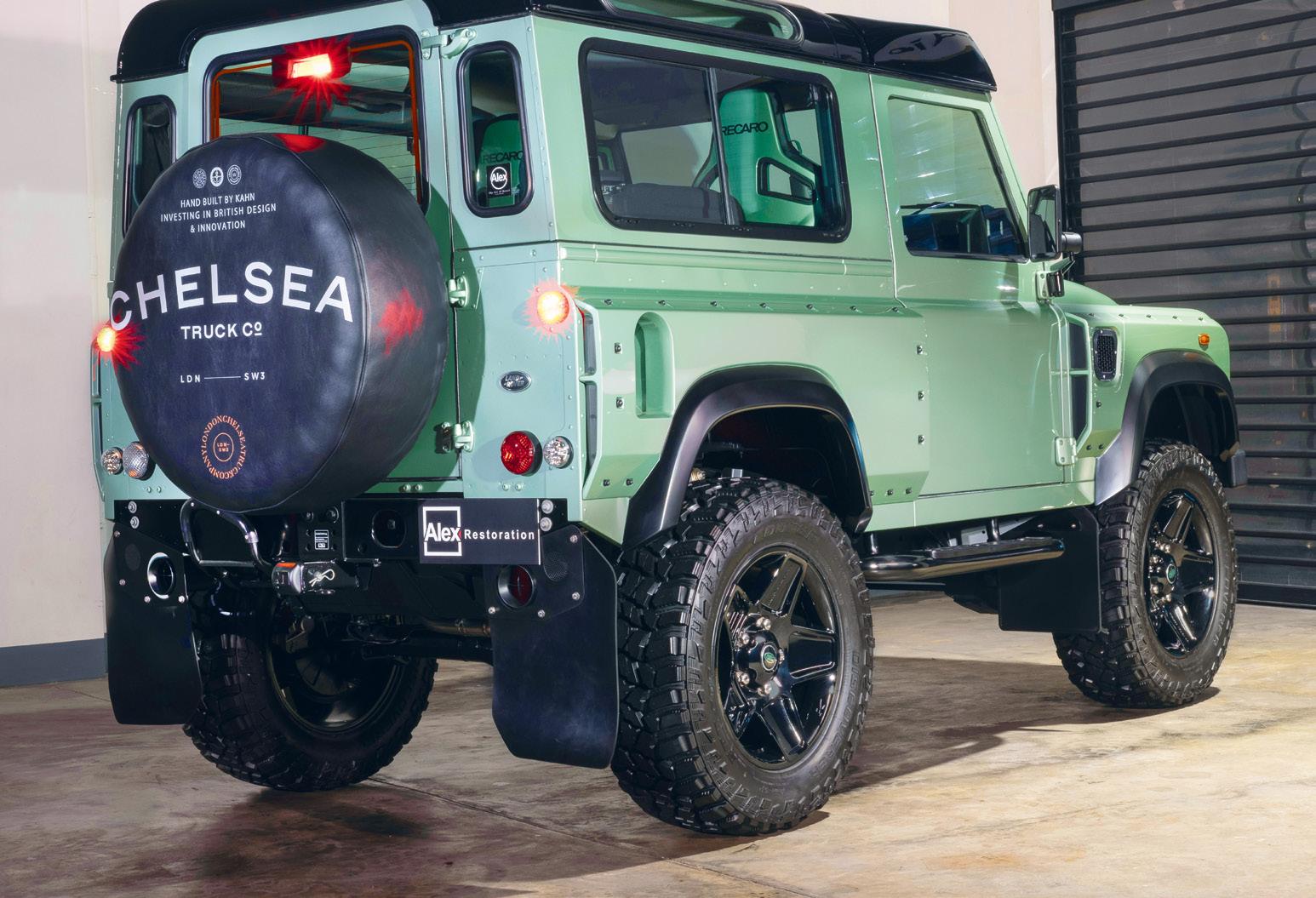

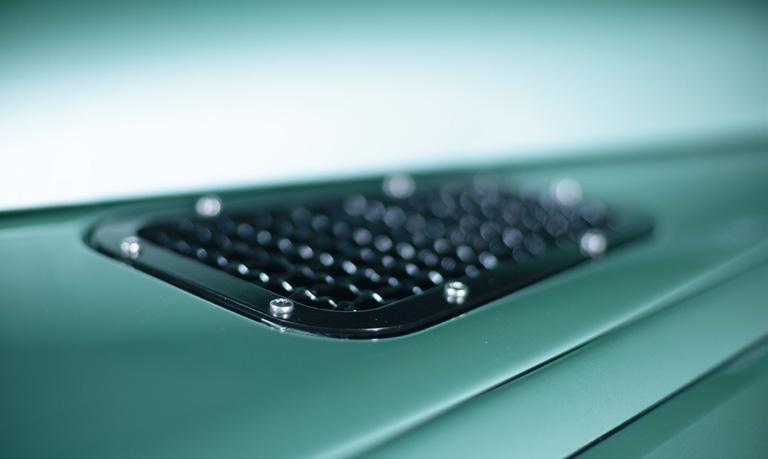



everything specified by Kahn like this one does. Adding even more girth from the wide track body kit are composite fender flares. Up front, it sports the new Kahn design front grille with upgraded LED headlamps and indicator lights which have been aligned strategically to ensure the front end of the vehicle resembles the iconic Defender. The minimalist front bumper is also by Kahn that comes with integrated driving lamps. Then there’s the roof shield with LED lamps that’s been finished with contrasting satin black like the rest of the accent pieces that include the front grille protectors, side steps, bumpers, and the Kahn design alloy wheels.
If the exterior color looks familiar, it’s because they chose a particular shade of green that closely pays homage to the basic Land Rover colors as Keith quips, “For the color we picked the classic green that the Land Rover is known for in the lighter shade to also show the body lines. Retro modern is the approach so we also updated the seats and as much as we can to make the car feel modern but look retro.”
As for the wheels, these are Kahn Design, 20-inch Mondial Retro light alloy with Cooper Discoverer tires. Enabling it to sit high and mighty is a Kahn suspension kit that comes with a set of matched coil springs and shock absorbers. Finally, a twin crosshair exhaust system and a Chelsea Truck Co. Soft black wheel cover lend a rugged look to this Project Kahn Defender.
The all-too familiar Defender 90 Series silhouette, upgraded with Kahn Design’s exterior treatment using exceptional standards of craftsmanship allows this modded Defender to make a definite and lasting statement whether its driven on or off road.
Words:
Mark Anton David
Photos:
Jordan Aparicio
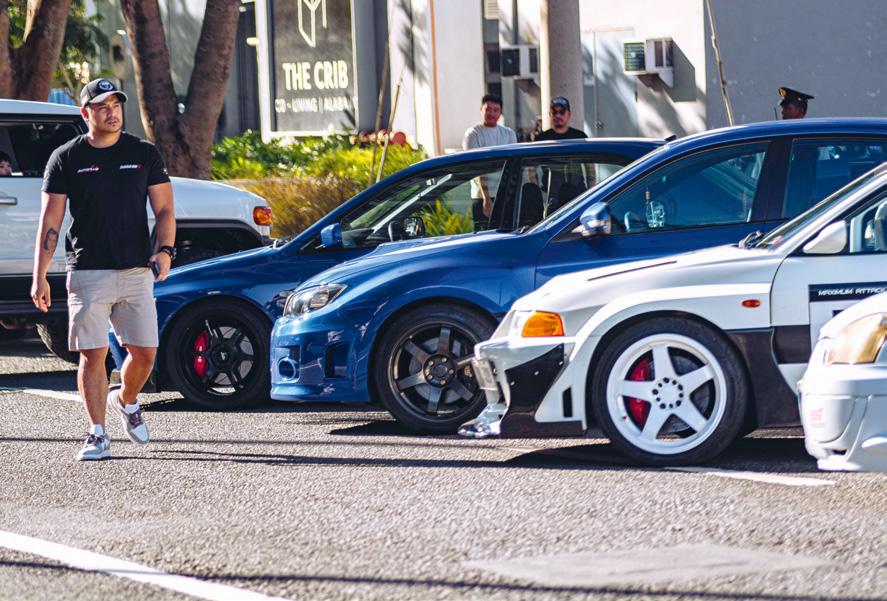
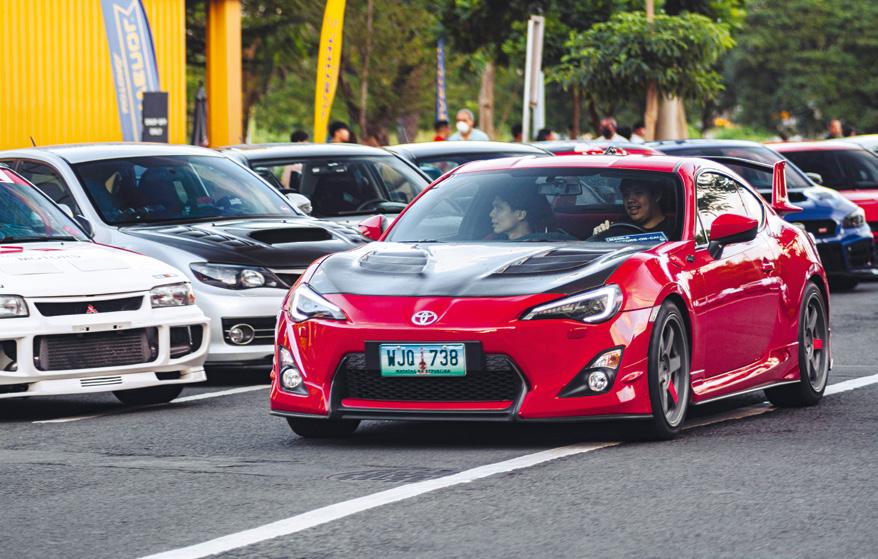
On a crisp Sunday afternoon, November 26, the Karrera Showroom Cafe played host to a remarkable automotive spectacle – the "Rivals" Cross Meet. This collaborative event brought together enthusiasts from the WRX STi Club Philippines and Evolution Club Philippines, showcasing the timeless rivalry between Subaru WRX/STi’s and Mitsubishi Lancer Evo’s from various eras. The groundbreaking event not only celebrated the distinct characteristics of these iconic Japanese sports cars, but also emphasized the sense of unity within the automotive community regardless of car make.
Car enthusiasts and onlookers alike gathered to witness a mesmerizing display of power, precision, and passion.
The Karrera Showroom Cafe, with its sleek and modern ambiance, provided an ideal backdrop for this clash of automotive titans. The unmistakable rumble of Subaru's boxer engines and the high-pitched whine of Mitsubishi's turbocharged powerplants created a symphony that resonated throughout the venue. The WRX STi Club Philippines and Evolution Club Philippines spared no effort in ensuring a diverse representation of their respective models. From classic iterations to the latest releases, the showroom floor became a time capsule of automotive evolution, highlighting the rich heritage of both the WRX/STi and Lancer Evo lineups.
Enthusiasts engaged in lively discussions, sharing insights about their beloved machines. The camaraderie that unfolded at the
"Rivals" Cross Meet underscored the shared passion that transcends brand rivalries, uniting individuals under the umbrella of automotive enthusiasm.
One of the highlights of the event was the parade of cars, where the WRX/STis and Lancer Evos formed a mesmerizing procession, their distinct colors and designs creating a visual spectacle that captivated attendees. The convoy through the streets surrounding Karrera Showroom Cafe not only showcased the prowess of these performance vehicles.
As the sun set on the "Rivals" Cross Meet, the sense of achievement and fulfillment was felt among the participants and organizers. The event has successfully stood as a testament to the power of collaboration and the enduring bond that unites car enthusiasts. Beyond the horsepower and different set ups, it was the shared experiences and mutual respect that made this event a resounding success.
Evolution Club Philippines and WRX STi Club Philippines would like to thank Karrera Showroom, Autoplus Sports, Ravenol Motoröl PH, Project Mu Philippines, Autoclinic Group Philippines, KW Suspensions Philippines, ST Suspensions Philippines, Yokohama Tire Philippines, Station Five Automotive, NanoPro Surface Solution - Philippines, MGD autocraft, Anzahl Urethane Paint, VB WorkX, Carbon Detailing Studio, Garage69 Auto Restoration, Otosthetics Automotive Productions, Figure 8ight, C! Magazine, Top Gear Philippines and Ramon Bautista for their support!
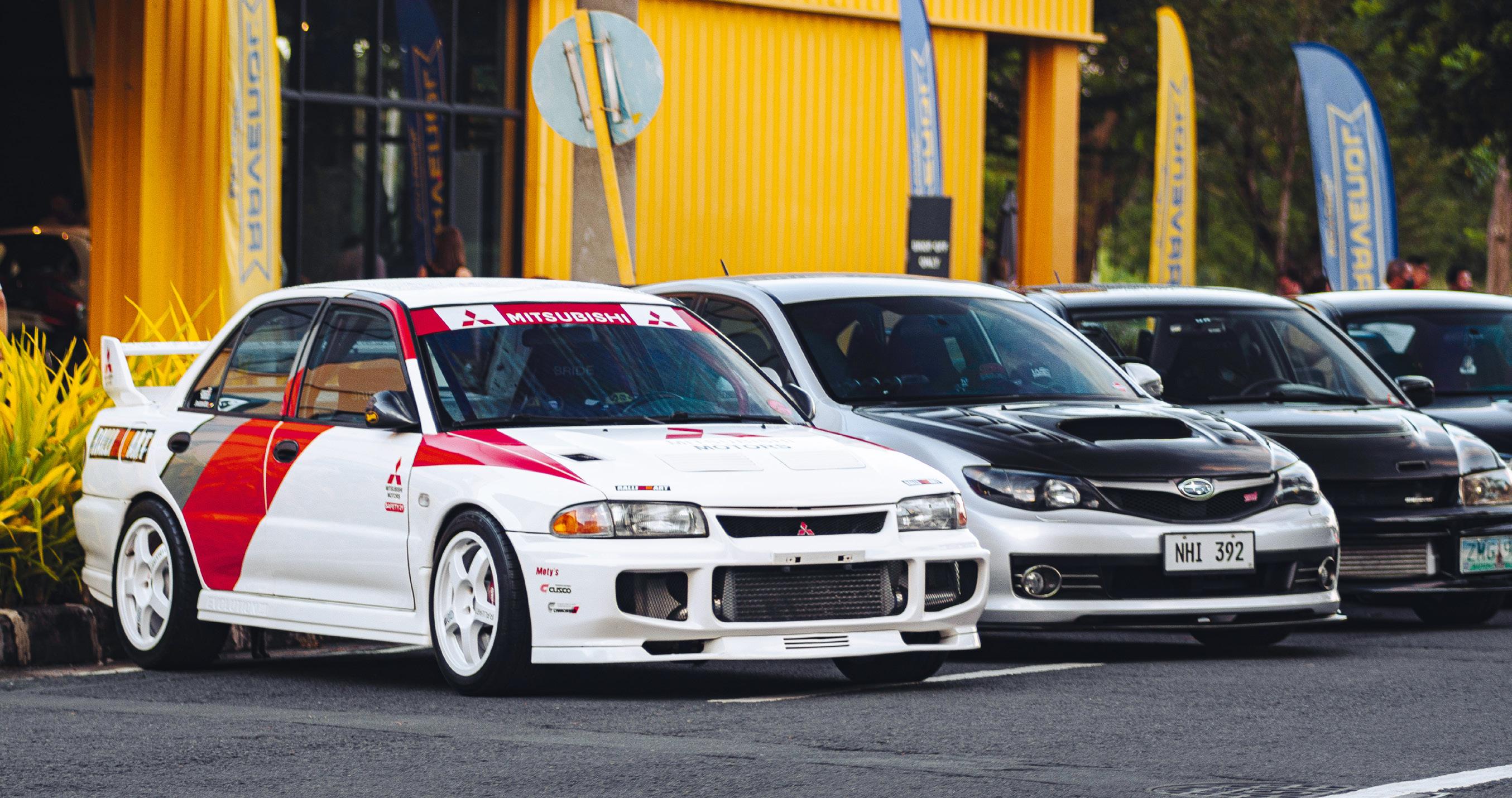
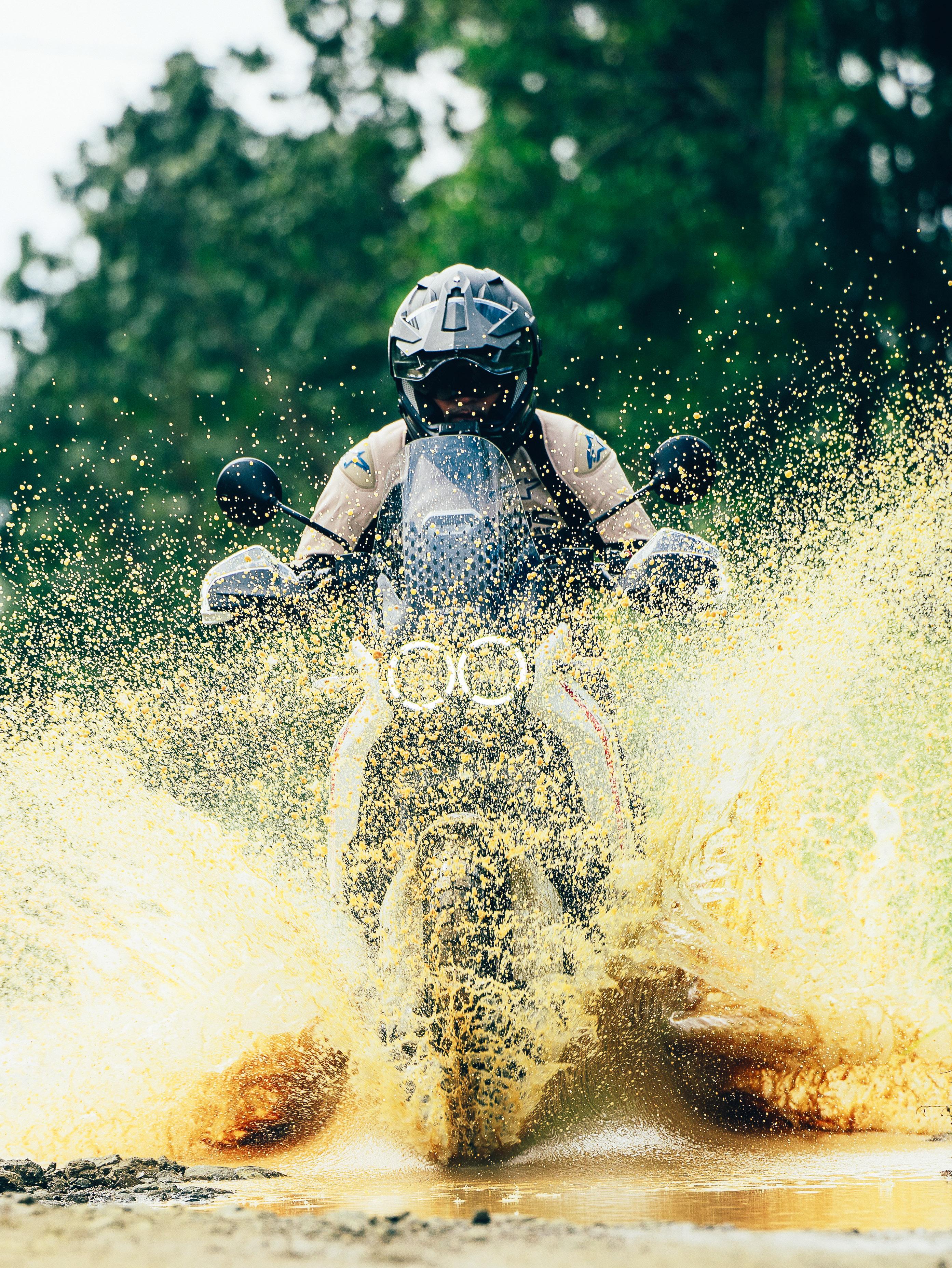
This is one of the most capable motorcycles in the middleweight adventure segment, find out more in the next few pages.
Almost every year since 2009, the BIMC has claimed the lives of several bystanders, and participants. There is now a congressional hearing set to investigate the event. Some of my colleagues in the motoring media have been campaigning to have it stopped.
While I do understand where they are all coming from, I do however have a different point of view. As a finisher of both the old school BIMC and this latest one in Mindanao, I would like to share what this challenge was originally all about.
The BIMC seed was planted when some of the Mad Dog MC members started to take on the challenge of joining the Iron Butt Association where in order to become a member, you need to do a certified long distance ride, the shortest of which being the “Saddlesore 1000” or 1,000 miles in 24 hours or less. Usually sporting just skull caps, leather vests, and open finger gloves, some of the more safety conscious and non-Harley Davidson riding members of the Mad Dog MC like Francis Rivera decided to step out of the group and form the BMW Owners Society of Safe Riders (BOSS).
What you know now as the BIMC was the brainchild of one Francis Rivera who was the president of BOSS from 2000 to 2007.
The original idea was to create an event similar to the Iron Butt Association membership process only shorter by a few hundred kilometers. Since the Iron Butt Association was already an existing entity for motorcyclists, Mr. River thought of Ironman to be the name of the challenge.
2005 was the year that the road connecting Sanchez Mira in Cagayan, to Laoag Ilocos Norte was opened and the very first Ironman Motorcycle Challenge was born with only 12 participants. It was a fun ride from Manila to meet friends in Tuguegarao who prepared food and refreshments for them then on to
the eastern side with another group of friends preparing another meal and fellowship before heading back to Manila completing the North loop. This was all before GPS devices became common and before the advent of phone applications. The only expressway up north was the NLEX so what made it tough were the navigation, and strategizing for fuel stops. Those days, there were less traffic and certainly fewer motorcycles on the road. It was really a fun adventure that challenged not only one’s riding skills, but also one’s organizational and navigational prowess.
In 2009 an aspiring participant came into the BMW showroom and asked for the fastest motorcycle they had and bought it specifically for the BOSS Ironman Motorcycle Challenge. Clearly, egos started to get into play and that participant was the very first fatality in BIMC history. As the years went by, participants started to balloon in number wanting to prove their mettle. The north loop route became more and more familiar along with new technology making navigation easy.
For these reasons, what the BOSS Ironman Motorcycle Challenge originally was, transformed into a whole different animal. Now the challenge became how fast one could finish it as compared to the original challenge of just completing it.
In this day and age of self promoting motovloggers, the BIMC has become so hyped up that even newbies take it on thinking they are ready for it.
My first BIMC participation only had fewer than 300 riders as compared to today's almost 2,000 participants in Luzon alone. I didn't even join the BIMC until I was certain that I had the skills down with several years of riding experience to back myself up.
That volume of adrenalin-fueled riders, all competing to brag about how fast they completed the challenge on open public roads is just a recipe for disaster no matter how much the organizers try to remind everybody that the BIMC is not a race. Even the rules regarding overspeeding are vague when the national speed limit for provincial roads is only 60 km/h. If we were to follow that, I doubt anyone would be able to complete the challenge. The call for the BIMC to stop is totally valid, but as a motorcyclist, I’d hate to see it go. It is for me, a sort of right of passage for motorcyclists. The only way for the
BIMC to continue is to dial it back to what it originally was. I call for the BIMC organizers to please consider these points:
01 Put a cap on the number of participants. Let's say a maximum of 500 riders.
02 Participants should have at least 5 years of big-bike riding experience with a training certificate from any proper riding school.
03 Change the route every year, and only reveal the checkpoint locations in succession to each one.
04 Ban auxiliary lights.
05 Ban electronic navigation devices including phone apps.
06 Make the challenge 24 hours of actual saddle time with pauses for fun activities and rest between checkpoints with a maximum allowable completion time of 3 days from start to finish. So everyone can ride at their own pace and enjoy the sights and culture of each place they visit but the challenge doesn't stop until the participant has actually completed at least 24 hours of saddletime. This way, the challenge would be more about navigation and time-management, and less about outright speed. It for sure would be a tougher, yet safer challenge. The problem with the current BIMC is that it's no longer as daunting as it used to be. All one needs to do is to plot the route on the GPS and follow.
I hope that the BIMC organizers find a way to continue on with these kinds of changes. Let's make BIMC the true road rider’s test of endurance that it once was. Bring back the fun, safe, yet formidable challenge where camaraderie and adventure is the theme. Riding around with 10 of your buddies on an adventure to create beautiful riding memories to cherish for years to come.
 John O. Mendoza
John O. Mendoza

Share the road. Ride safe. Stay alive.
Check your mirror for motorcyclists.



The Triumph Trident 660 may be Triumph’s entry level model, but don't let the PhP 516,000 price tag fool you, this bike is capable and is packed with features more commonly found on bikes twice its price.
It was during the Wheeltek Trackday at Clark International Speedway in Pampanga that I first swung a leg over the Trident. Having ridden the Trident’s impressive bigger brother, the Street Triple 765 RS around the track a few months back, I was eager to find out how well the more budget friendly Triumph would stack up against its more expensive sibling.
The engine layout is based on the old Daytona / Street Triple 675 engine.
Triumph’s unique T-Plane crank configuration gives a wider spread of power pulses. What that
translates to is that the tire has more time to recover, gaining back its form in between power strokes allowing it to keep traction better than the standard crossplane Triple configuration.
While 80 hp may seem weak compared to the triple’s inline 4 100+ hp supersport counterparts, the Trident’s engine puts out 90% of its maximum torque from as low as 3600 rpm all the way to 9750 rpm giving you the power where you need it most on the street. Believe me, the Trident has enough umph to keep everybody entertained out on public roads. The Trident is equipped with a ride by wire throttle system that feels crisp and direct. The ride by wire system also allows the Trident to be fitted with an optional up and down quick shifter/ auto blipper.
The Trident handles like a dream! Far from what I was expecting from this price point. The non-adjustable Showa 41mm upside down separate
function forks (SFF) and preload adjustable rear shock RSU, are well tuned for my body weight of 170 lbs without gear. The tubular steel frame with its 24.6º rake and 107.3 mm trail geometry equating to a 1401 mm wheelbase gives the Trident a very sporty and agile handling characteristic.
Riding the Trident 660 around CIS was an eye opener for how a well sorted motorcycle can perform even with non-premium components. Triumph really knows how to dial in a bike, that's for sure.
The Nissin two-piston calipers mated to twin 310 mm discs up front and Nissin single-piston caliper paired with a single 255 mm disc at the rear, both ends with ABS provides good braking power, never leaving me wanting for more. The slip and assist clutch lets the bike ease in when downshifting abruptly into frantic corners. The clutch pull is light and easy while the 6 speed gearbox is buttery smooth.

“I was reaching the Trident’s maximum lean angles limited only by the stock foot pegs without any drama.”
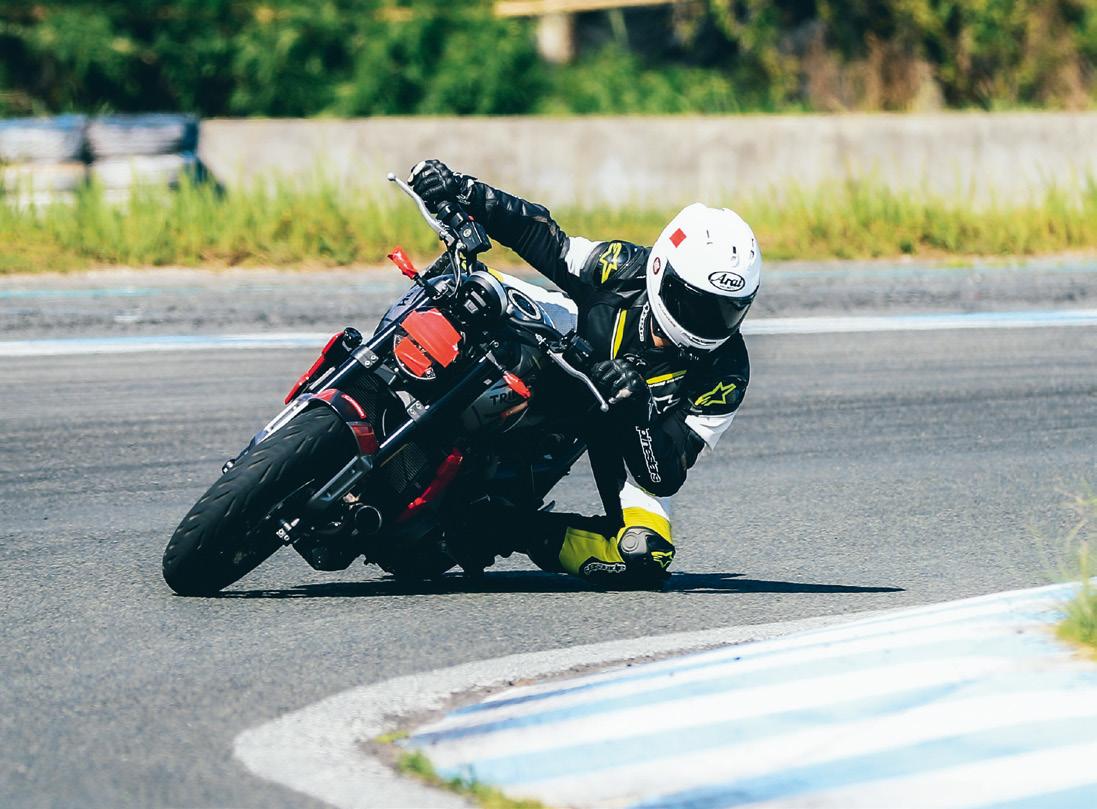

The Trident corners spectacularly well, giving me confidence at every turn. The stock Michelin Road 5 tires are very impressive! This pair of 120/70R17 and 180/55R17 tires grip the tarmac more than any road tire has the right to do so. I was reaching the Trident’s maximum lean angles limited only by the stock foot pegs without any drama. It was only after 8 laps of hard riding that I would feel the front tire push with such a controlled movement, not enough to snatch any confidence in me.
The Triumph Trident 660 has a light curb weight of 189 kgs. and a friendly seat height of just 805 mm making it a great choice for vertically challenged riders and new riders alike. The riding position is very comfortable and the wide bars give the rider much leverage to steer the bike. The Trident’s tastefully appointed TFT instrument panel displays all pertinent information quite clearly under all lighting conditions.
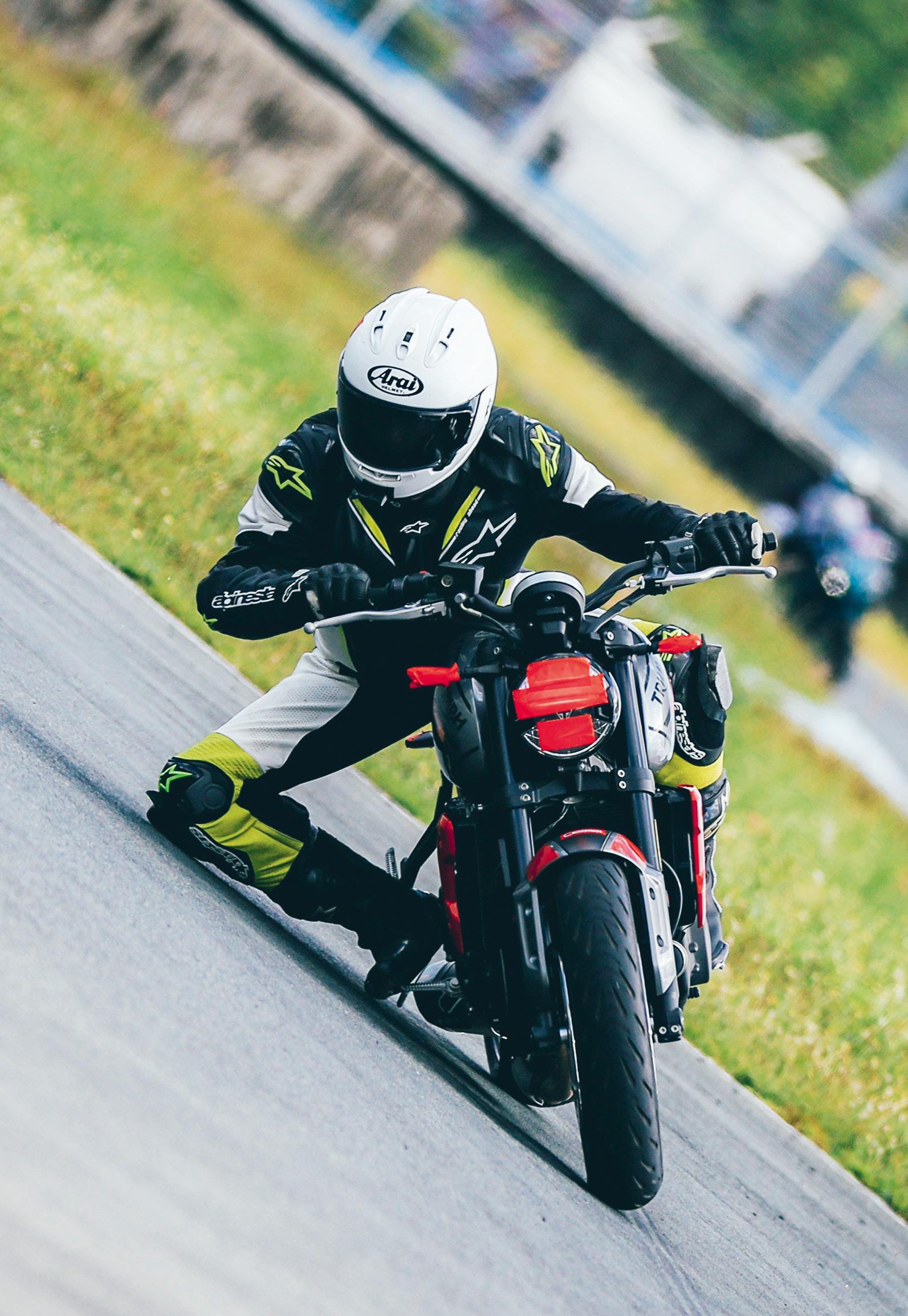
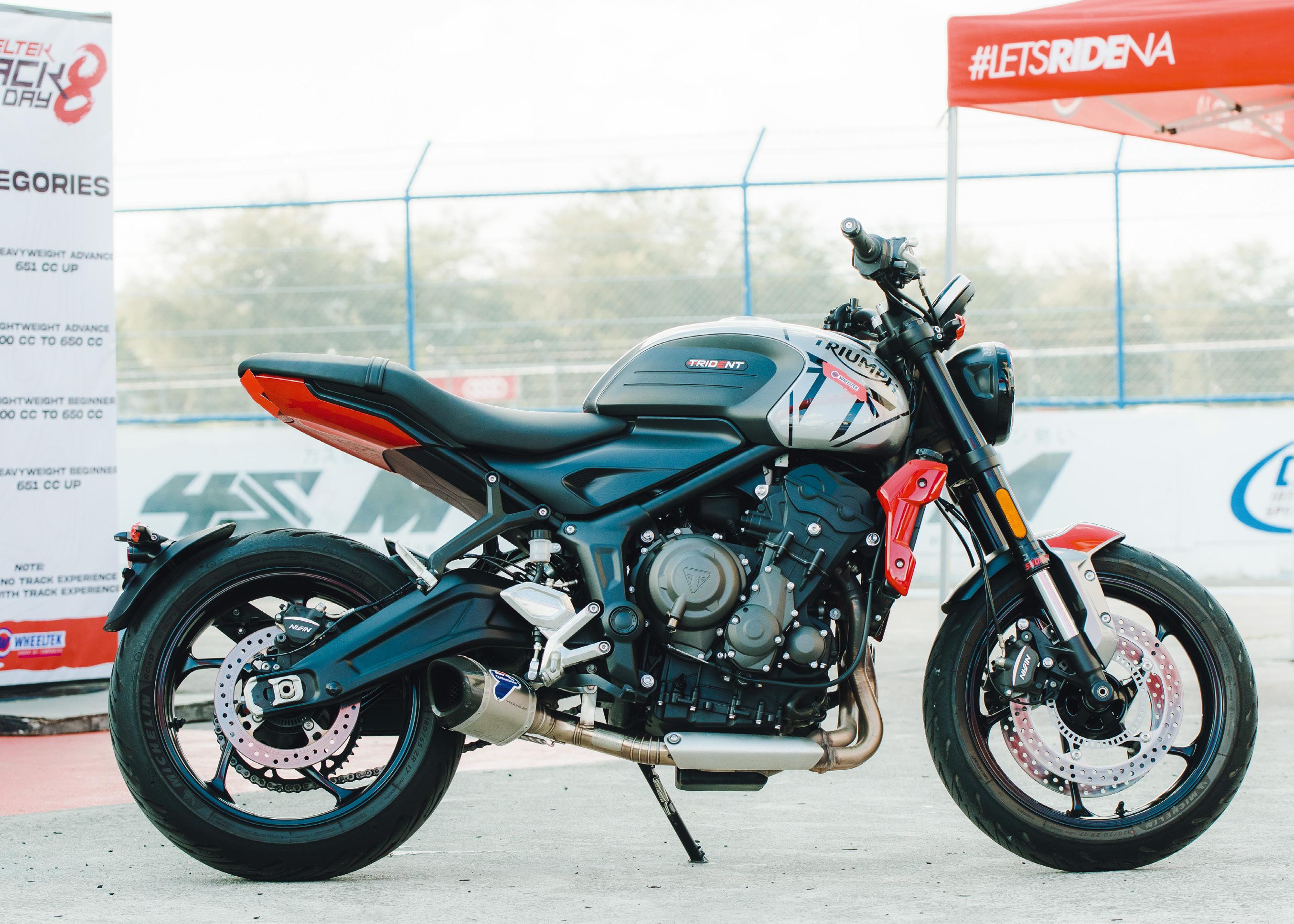
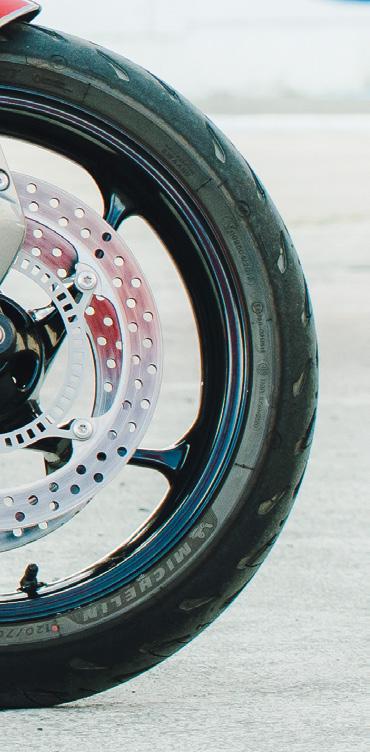

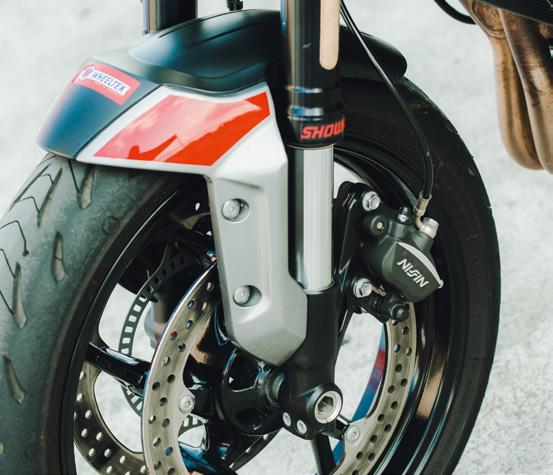
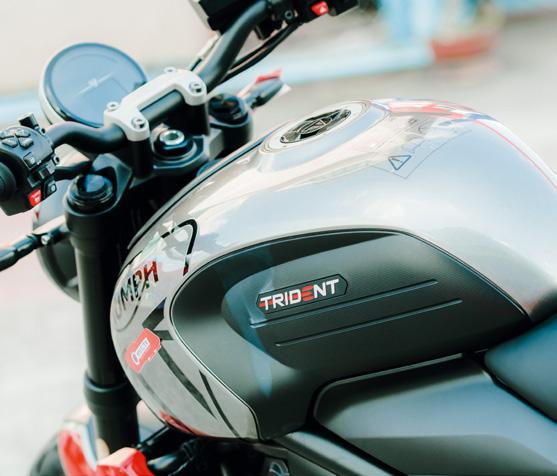

There are only 2 riding modes, rain and road. I wish Triumph gave it a track mode shutting off all rider aides to make it more fun on the track.
The aesthetics are quite pleasing, combining elements of past muscle bikes with its bulbous 14 liter tank and round headlight with modern construction like its perimeter frame, single rear shock, and gull-arm looking swing-arm giving it a nice neo-retro look.
With a service interval of 16,000 kms, or every 12 months, whichever comes first, the Trident 660 is not only easy to purchase, it is also very economical to run.
The Triumph Trident 660 is probably the best motorcycle at this price point. It is well appointed, handles very well and is capable of outpacing lesser riders on faster and more expensive bikes. This is not a bike that one would outgrow; a perfect blend of affordability, performance, and style.
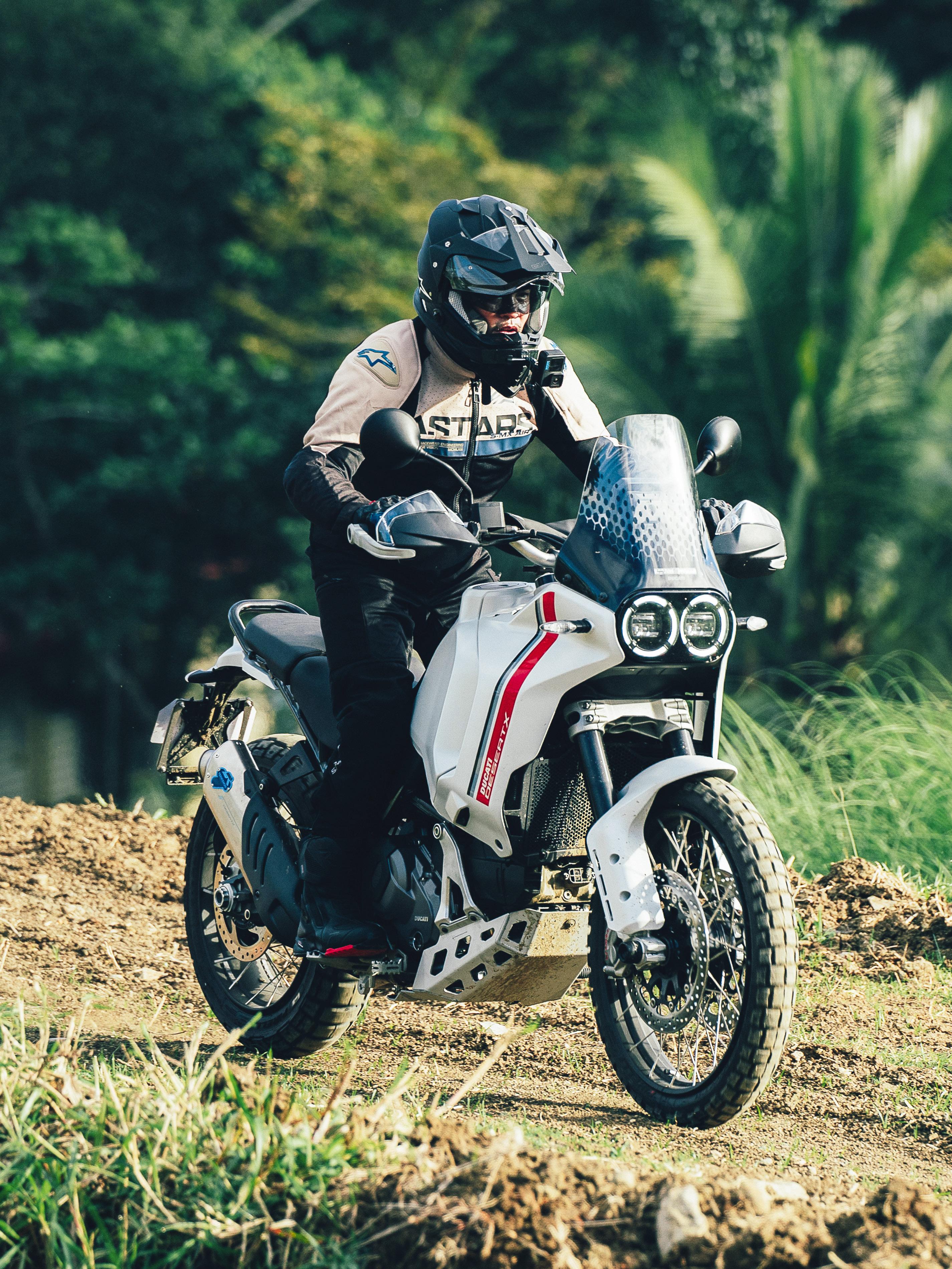

The Ducati DesertX looks like something that came out of the era of Paris to Dakar rallies. This neoretro adventure bike doesn't only look the part, it performs at the top of its class by a good margin over its competition.
I admit, I may not be the best candidate to test an adventure motorcycle and split hairs to tell you which one is the best out there, I can only offer my experience and my insight into this whole shebang. I am of a road and track riding background, and have never had any love for ADV riding. I mean, I'm a short 5 ft, 6 inch framed guy; I just don't get along with tall-heavy bikes.
Over the last few months, I’ve received some adventure bike training from coaches Mel Aquino,
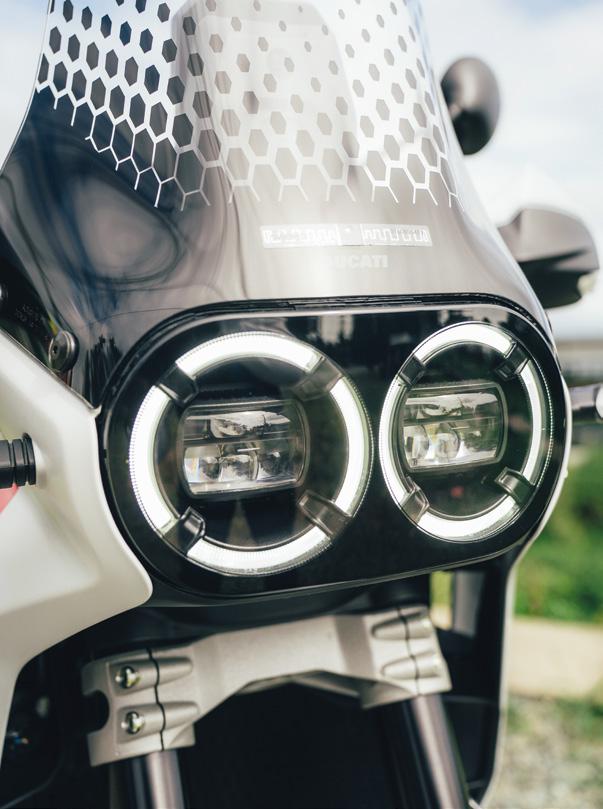
Toto Villanueva, and Jacob Orbe. I’ve also ridden all the other bikes in the DesertX’s category so I'm not going into this blindly.
One thing I noticed right away was how light the DesertX felt. My ride home from Ducati Katipunan was easy even though traffic was bad.
Even with its tall and wide bars, I had a great time filtering through, and weaving in and out of traffic. It felt light enough that even with just my toes touching the ground, I felt quite at ease.
I took the DesertX to the KRB dirt track to practice a few ADV riding drills. Just to see how well I could handle the DesertX. Last time I did those was on a small 250cc ADV bike, and surprisingly, I found the drills easier to do with the DesertX. I got so confident that I decided to take
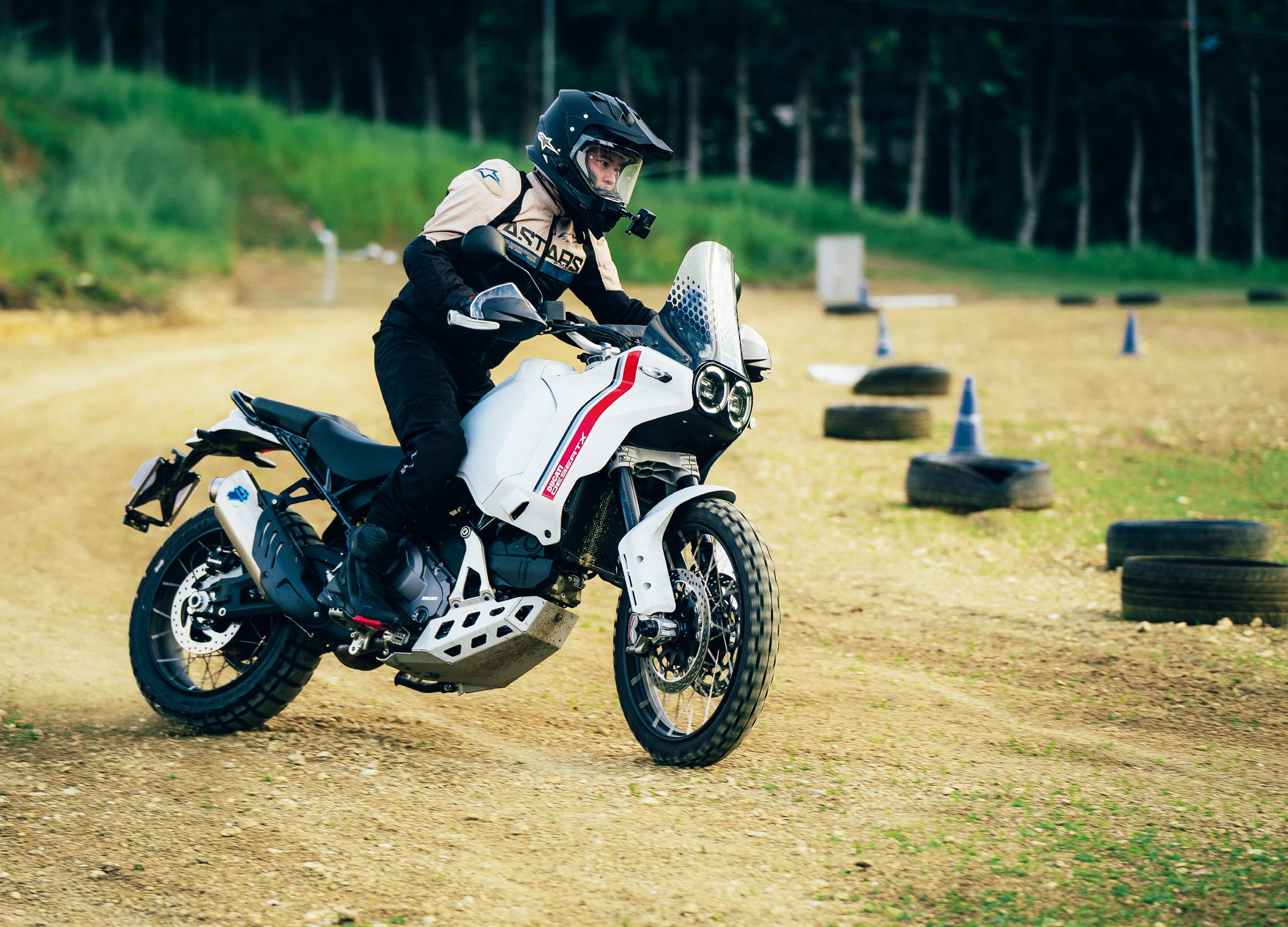


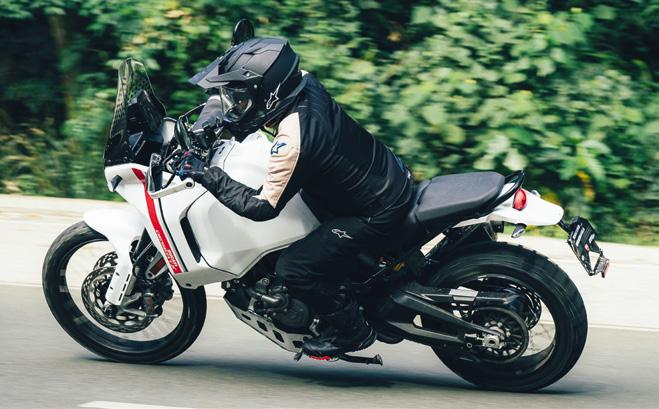
it inside the motocross track. It cornered through the burms and even got some airtime over the jumps. While it wasn't as easy as riding a proper dirtbike, the DesertX performed pretty darn well that I had a great time with it on the MX track.
Riding the DesertX on the twisty mountain roads of Tanay was a revelation. I couldn't wrap my head around how this tall adventure bike with a skinny 90/90/21 front and 150/70/18 rear Pirelli Scorpion Rally STR tires could handle so well on road. It doesn't feel cumbersome, and holds a line quite well. Compared to the other bikes that I've tried in this category, I felt most comfortable cornering on the asphalt with the DesertX.
In true ADV riding fashion, I took it to the AFP/ Maarat trail. I have ridden there before but on a small dirt bike. Somehow, the terrain was much worse this time around and was extra muddy due to rain the evening prior. I may have bitten more than I could chew but the DesertX made me feel quite confident and at ease. While I did drop it one time while celebrating too early after going through the toughest part of the trail, the DesertX was prepared to take a beating. I mean everything from the shifter lever, to the pegs were foldable, there is a bash plate in-place underneath the engine, and the tank is big and robust to take blows from the sides. The DesertX has a generous 250 mm ground clearance and an offroad frame that is designed to take this kind of abuse.
Power from the 937cc Testatretta engine is extra potent. I loved it so much in the Monster 937+ and it is still awesome in this package with a different gear ratio for a more dirt oriented set-up. The spread of power is quite perfect from the low end grunt to the top end growl getting you out and around obstacles with ease.
Service intervals are every 15,000 kms for the ordinary PMS and every 30,000 kms for the Desmo service so you can rest assured that you would be spending more time riding than waiting in the workshop.
The DesertX is a technologically sophisticated motorcycle with a full electronics suite with several customizable rider modes, and a complete slew of rider aids including cornering, adjustable ABS, and adjustable traction control. A TFT dash, displays all the information you need and more while full LED lighting illuminates your way. Cruise control also comes as standard so you know this bike will spoil you on long arduous journeys.
As with any Ducati, the brakes are phenomenal with twin radially mounted Brembo M50 calipers up front, and a two piston Brembo caliper at the rear. The ergonomics are perfect for both sit-down and stand-up riding. It is super comfortable, and
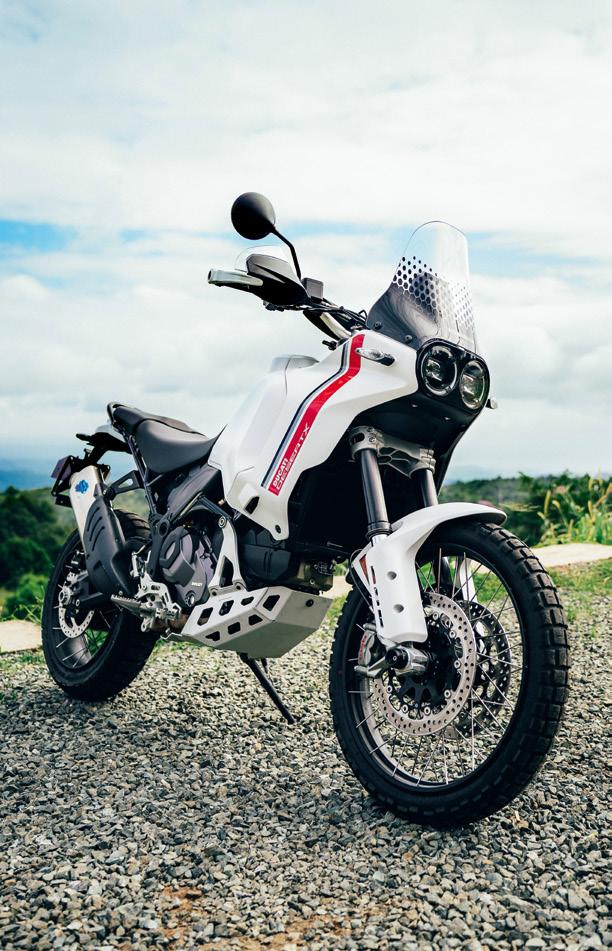
gives a commanding view of your surroundings. The seat height is 875mm but the suspension compresses enough for it to be manageable for short guys like me. The fuel capacity is a huge 21 liters which is good for approximately 374 kms, and is expandable with an 8 liter accessory tank.
Out of all the ADV motorcycles from other brands, it is only the Ducati DesertX that has made me appreciate messing around in the mud. It is truly an enjoyable experience! So much so that I am now gearing up for more dirt rides, getting lost and wandering around on the mountain trails. Unlike other ADV bikes that feel awkward cornering on road, and cumbersome and heavy off-road, the Ducati DesertX offers true adventure experience with total control, poise, and finesse even under the hairiest of situations. Indeed, the Ducati DesertX made me dream wilder, looking forward to more adventures out in the wilderness.
“Compared to the other bikes that I've tried in this category, I felt most comfortable cornering on the asphalt with the DesertX. ”
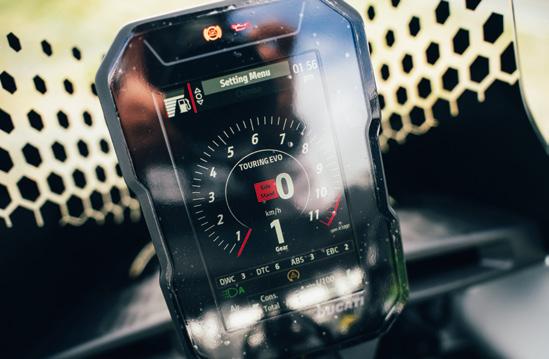

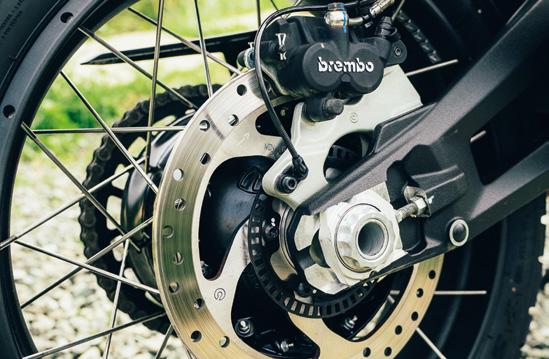
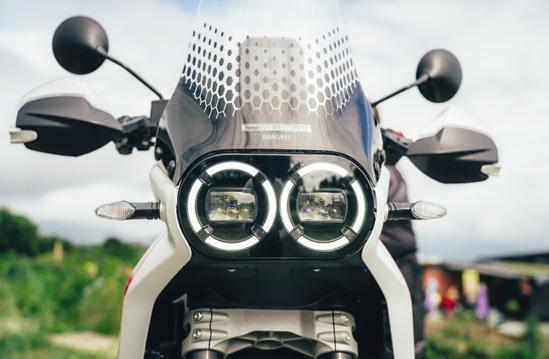




Guys like me who were teenagers back in the second half of the 1990s would remember the original Italjet Dragster designed by Leopoldo, and sons Massimo, and Alessandro Tartarini. It had three 2-stroke variants: a 2.4 hp 49cc, a 14 hp 123.54 cc, and a 20 hp 175.75 cc that were every kid’s dream smokers back in the day. What made them so unique was the Dragster’s Hub-Center-Steering system in place of conventional forks.
The latest Italjet Dragster 200 designed by Leopoldo’s son Massimo Tartarini, is a great tribute to both the father’s design of the original Dragster, and his legacy. The new version keeps the very essence of what the Dragster was and takes it to a whole new level of performance and sophistication.
The idea here is to isolate the steering function from suspension, and braking. This system makes use of a front swingarm and a longitudinally mounted shock absorber to smooth out bumps without being influenced by braking forces and steering inputs. This takes out alterations on steering geometry under braking, maintaining the amount of suspension travel entering a corner, and keeping the bike as stable as it is designed to be at all situations by maintaining the same wheelbase. It also eliminates the problem with stiction on conventional setups.

The Hub-Center-Steering set-up or as Italjet calls it, Independent Steering System (ISS) takes some getting used to. It feels awkward at first, but give it time, and soon your confidence will buildup to it. It feels different from conventional forks at slow speeds, and when braking into a corner as there is no brake dive and no change in the bike’s geometry as you turn in. The new Dragster was developed with the help of MotoGP rider Andrea Dovizioso, so you can bet it handles well through the high speed stuff.
The Brakes are Phenomenal!
The Dragster 200 is equipped with real Brembo calipers mated to wavy discs; a 240 mm rotor and 2 piston caliper on the front and a 175 mm rotor and a single piston caliper at the rear, both with steel braided brake lines and ABS. Not a Brembo owned brand or entry level subsidiary, these are real Italian Brembos! These brakes have much stopping power for this scooter and modulates so well.
“Independent Steering System (ISS) takes some getting used to. It feels awkward at first, but give it time, and soon your confidence will build-up to it. It feels different from conventional forks at slow speeds, and when braking into a corner as there is no brake dive and no change in the bike’s geometry as you turn in.”


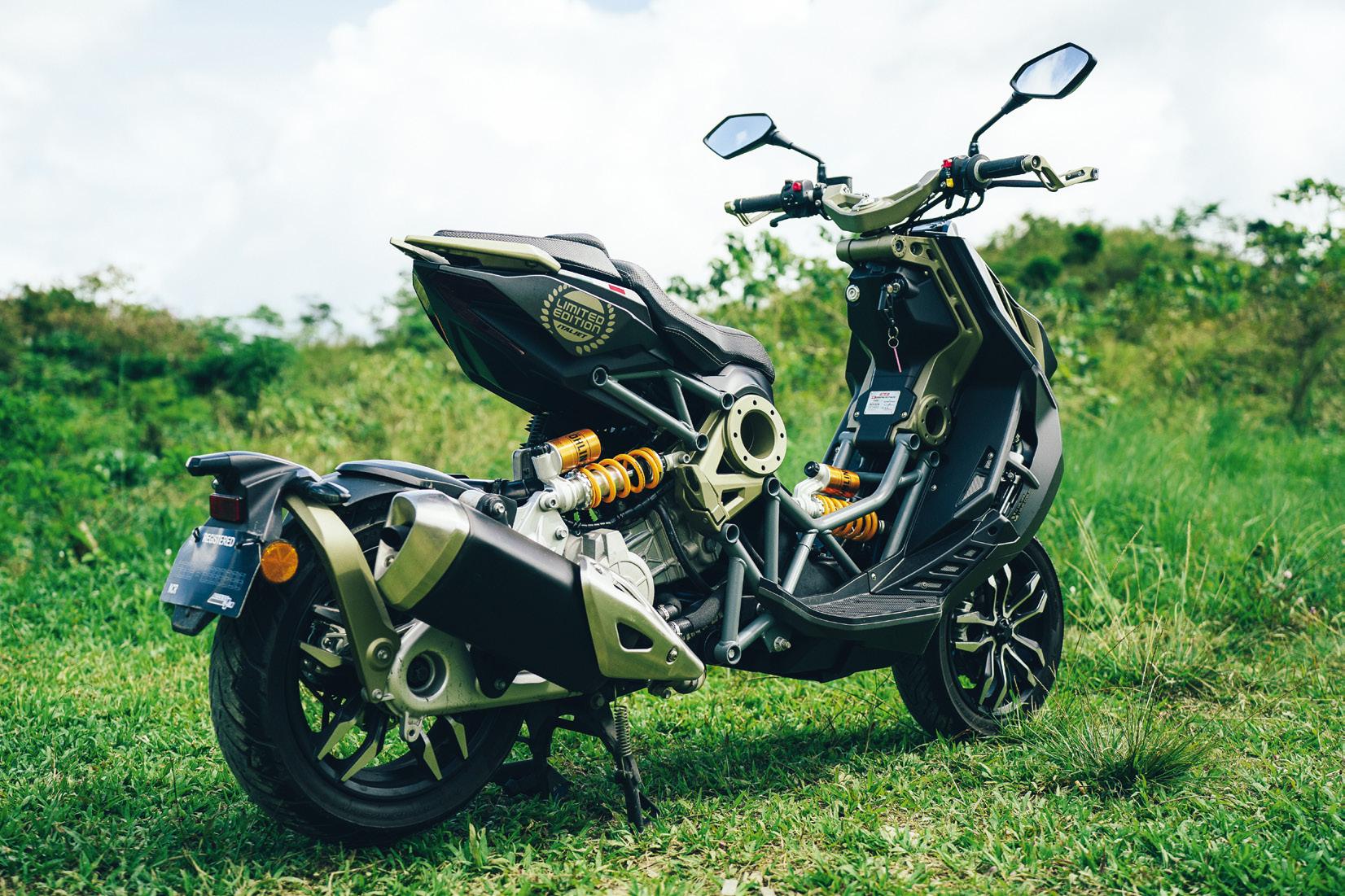

Like the original Dragster, Massimo designed the new one with a staggered wheels set-up; 120/70-12 up front and a 140/60-13 at the rear. This helps the Dragster steer quickly, and adds to the badass nonconforming look. It also has a steel tubular frame like the old Dragster.
If you are wondering why there are a few Ducatiesque elements in the design, like the steel Trellis frame, and the rear tail and tail-light that looks so much like the Panigale's, that’s probably Massimo’s way of paying homage to his father Leopoldo’s history with Ducati. Leopoldo used to race Ducatis in endurance races, and also owned and operated a Ducati dealership with his father (Massimo’s grandfather) back in the 60s right up to the time they started Italjet.
The sequential LED turn signals are integrated into the lever guards, and the cowl looks similar to the old Dragster's but is so much more aggressive and angular. The LED projector headlights work great at night illuminating the road quite well. The instrument panel is very spartan like the ones on dirt bikes, displaying just the speedometer, odometer, trips A, and B, and the fuel guage. It also has a few warning lights and turn undicators. If there was one thing I wish the Dragster 200 had, it is a full TFT dash.
The seat let's you know that the Dragster is a performance scooter. The cushion, while well shaped is on the stiffer side of things. It really lets you have a feel for what the rear tire is doing, giving you much feedback. The seat has quite an aggressive bum stop, holding you in place during hard acceleration. The riding position is supermotoesque giving you a feeling of being on top of the bars. This gives you good leverage for quick changes of direction. The feet position is a choice between standard riding with your feet on the floorboard, or moved behind for a more sporty feel. No feet forward position here.
The seat height is a friendly 770 mm and allows a rider like me with a 5 foot, 6 inch height and a 31 inch inseam to flat foot on the floor with both feet at the same time.
The Dragster 200 is powered by a game changing 181 cc water cooled, fuel injected engine with an oversquare 63 mm bore, and a 58 mm stroke. I say game changing because there is no other Double Overhead Cam (DOHC) scooter out in the market today. This engine is set up for performance. The
twin radiators are mounted on the front, under the cowl where high flowing air is directed to them and are aided by cooling fans to keep the temperature down. The impressive 19.8 horsepower, and 12.6 lb-ft of torque pushing this 112 kg dry weight scooter is enough to keep you entertained. But with this set-up, you know that the Dragster means business and will easily accommodate bore up kits and aftermarket exhaust systems to get you more go juice.
I mean the cooling system is already overkill for the stock engine and would be able to cool down any performance upgrades that would be added to the engine. The CVT transmission is finely tuned to keep the engine reving within its powerband delivering peak power and peak torque all over the transmission range. It sure is fun getting off the line at the stoplight.
This particular Dragster is equipped with a set of adjustable Ohlins shock absorbers, so I wouldn't be able to tell you how the stock suspension performs as this is the only Dragster I've tried; but these golden suspenders is the creme-dela-creme of suspension systems. These make the ride plush yet very controlled, you can dial in just the right amount of compression and rebound damping to suit your riding style within just a few clicks. Of course, you can also set the preload to your weight, setting the scooter up to the correct sag. I can guarantee that the PhP 67,000pair of Ohlins are worth the money!
Well you certainly get what you pay for. While the price maybe steep at a SRP of PhP 376,000 for the regular version and PhP 383,000 for the Malossi Edition, (You can no longer get this Massimo Tartarini Limited Edition as there are only 499 examples in the world.) The equipment and intricate details built into this scooter are staggering.

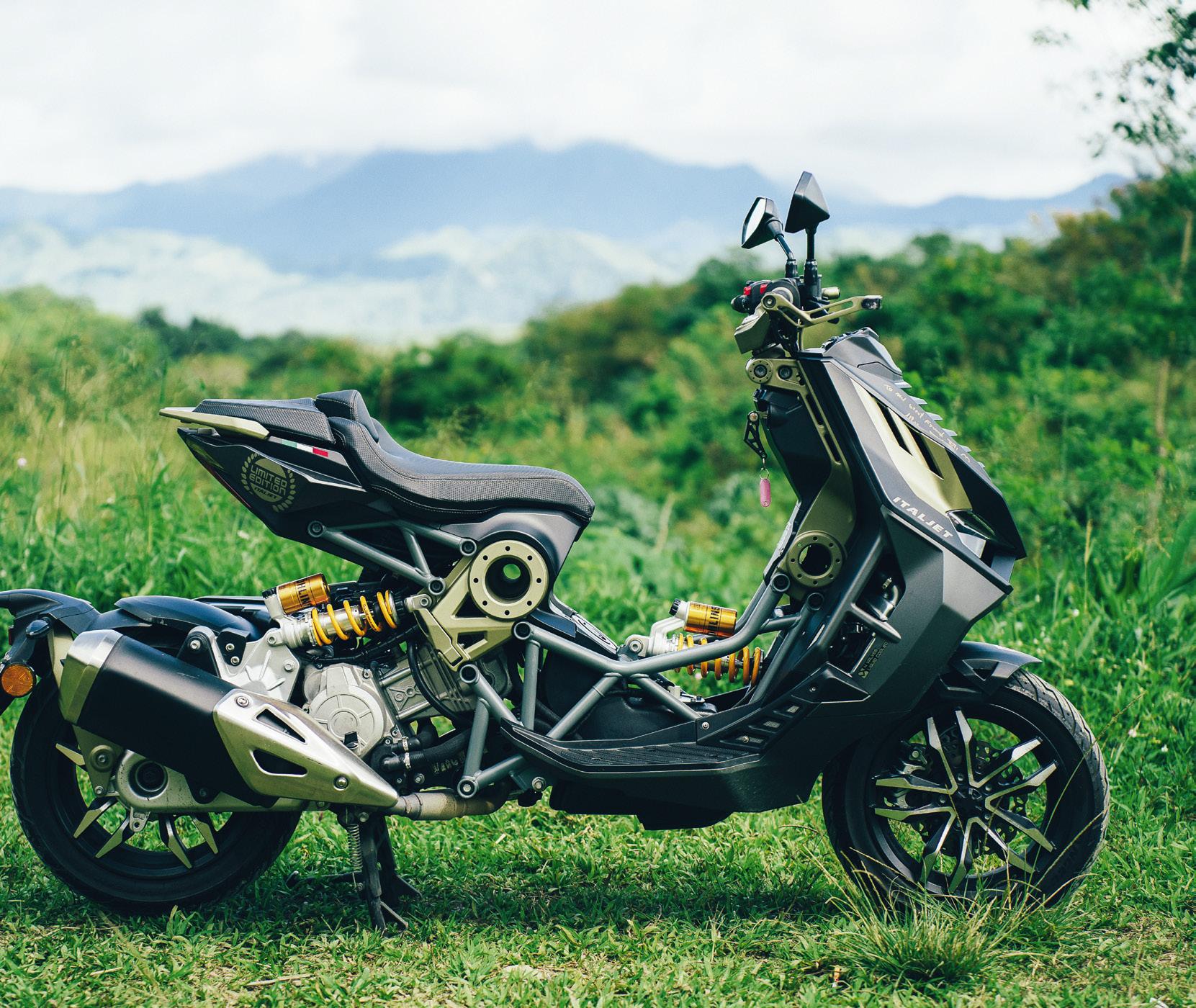


This is definitely not your garden variety scooter. It is a rolling work of art that performs like no other. It is a bold statement that sets you apart from the rest and gets you a whole lot of fun on the road. Definitely for well heeled riders who already have several expensive bikes in their stable.
